Australian
and international
exploratory
performance and
media arts
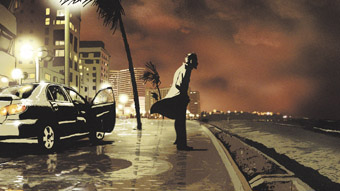
Ari Folman's Waltz with Bashir
I began writing about Australian animation in 2003, but only by default. I was in the queues for the Melbourne International Film Festival waiting to see various short film programs, which is what I intended to review. I kept overhearing the names 'Adam Elliot' and 'Harvie Krumpet' in conversations between fellow filmgoers, and noted they were talking about animation, not short film. I wasn't aware Australia had much of an animation industry. I had known student friends who made cartoons, but professionally? It wasn't like local animators were ever mentioned in mainstream media, therefore they didn't exist, in that if-a-tree-falls-in-the-forest kind of way. But there was an insistence about this Elliot character that made me want to know more, and that's how I came to interview him. That was before Adam's Oscar success, and I was left with admiration for those who made painstaking animations in a country that barely acknowledges Australian live-action film, let alone something as marginalised as this medium (it seems likely there'll always be a cross-section of society that sees animation as strictly 'for kids').
There have been some hiccups. A few RealTime writers, including myself, have criticised the oft-simplistic nature of Australian animation, usually directed towards storytelling. Generally, the technique is admirable and improving, especially since the CGI fad seems to be waning. RealTime's reviews of the annual Melbourne International Animation Festival demonstrate this: some years, the festival's local component seemed out of touch; recently, it has held its own with the international selections. The RealTime archives highlight other significant developments and patterns. Danni Zuvela's review of Aboriginal animation from Canada and Australia focuses on work blessed with much storytelling potential at the historical and mythological levels. Ashley Crawford declares the slapstick Dadaism of Arlo Mountford's extraordinary work in a league of its own. Dan Edwards takes a timely look at the 17-minute Sweet and Sour, an Australia-China co-production and a welcome change from what he terms Australia's “depressing myopia” when it comes to non-US/UK film influences. And Keith Gallasch admires Lee Whitmore's compelling The Safe House, “in which childhood, history and politics…come seamlessly together, a rarity in Australian film.”
Appraisals of international productions include no less than four reviews of Boca del Lupo's theatre/animation hybrid, My Dad, My Dog; Angela Ndalianis's seduction at the hands of ACMI’s Pixar exhibition; and Megan Carrigy's analysis of the extraordinary animated documentary Waltz with Bashir, making the salient point that having the film “in general release…is significant since animation has become a major site for innovation in Australian short films”. A couple of historical overviews serve to contextualise: Adrian Martin passionately introduces The Illusion of Life II, a 576-page collection of essays from animation scholars past and present; while my own look at Flickerfest's historical overview of Australian animation allows me to revisit the beloved “Life. Be In It” commercials of my youth, leading to the revelation that this country has always had an animation industry, just not where you'd expect to find it.
Simon Sellars
reviews
animating dream into action
danni zuvela: big eye aboriginal animation from canada & australia
mary and max: little people, big imagination
kirsten krauth
animating the interactive spin
greg hooper: knowmore (house of commons), state library of queensland
active recall: animating history
megan carrigy: waltz with bashir, an animated documentary
australian animation:quality wins
simon sellars: flickerfest’s oz animation celebration
from chinatown to china
dan edwards: sweet and sour, an australia-china animation co-production
traditional animation, the computer finish
angela ndalianis: acmi’s pixar exhibition
small tales tall and true
simon sellars: australian short film at the melbourne film festival
unleashing the inanimate
adrian martin launches a new australian book on animation
art animated and dissected
ashley crawford: arlo mountford’s animations
re-animating australian history
keith gallasch: lee whitmore’s the safe house
animation: in the moment
keith gallasch: 2004 afi awards
education feature: the intricate making of animators
simon sellars
the library withoutbridget currie: jenna woodburn and ben howard's [site-works]
melbourne international animation festival
tricks and treats
simon sellars: miaf 2009
puppet power & scary magic
simon sellars: miaf 2008
animation: access, artistry, limits
simon sellars: miaf 2007
animation: potential or impasse?
rebecca l stewart: miaf 2004
my dad, my dog @ PuSh festival: live art and animation
my dad, my dog: unfinished tales
anna russell
my dad, my dog: disconnection sketched
meg walker
my dad, my dog: between worlds
andrew templeton
my dad, my dog: fuzzy friend
eleanor hadley kershaw
interview
krumpet wins!
simon sellars talks to adam elliot
Splitrec CD19
www.splitrec.com
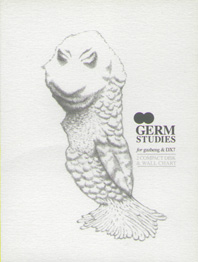 Germ Studies is a double CD produced by the duo of Clare Cooper of NOWnow Festival fame and Chris Abrahams of The Necks, and the two have been collaborating on it since 2003. Each CD comprises no less than 99 tracks, 198 in all. That is a lot of material and it represents an extensive investigation into the endless range of sounds that can be created by combining the venerable DX7 synthesiser and the even more venerable Chinese zither, the guzheng. It is also a deep exploration of musical language. Rather than producing longer, more self-contained compositions, Cooper (guzheng) and Abrahams (DX7) have created a series of sonic moments that flit through conscious awareness, sharply distinguished from each other by the nature of the sound, the sum of which creates a substantial and engrossing oeuvre. Many of these exquisite tracks are less than a minute in length, some just a few seconds. A few are longer, at 2 or 3 minutes, and, perhaps ironically, the track entitled Neutrino (referring to the almost weightless sub-atomic particle) is an epic at 8 minutes.
Germ Studies is a double CD produced by the duo of Clare Cooper of NOWnow Festival fame and Chris Abrahams of The Necks, and the two have been collaborating on it since 2003. Each CD comprises no less than 99 tracks, 198 in all. That is a lot of material and it represents an extensive investigation into the endless range of sounds that can be created by combining the venerable DX7 synthesiser and the even more venerable Chinese zither, the guzheng. It is also a deep exploration of musical language. Rather than producing longer, more self-contained compositions, Cooper (guzheng) and Abrahams (DX7) have created a series of sonic moments that flit through conscious awareness, sharply distinguished from each other by the nature of the sound, the sum of which creates a substantial and engrossing oeuvre. Many of these exquisite tracks are less than a minute in length, some just a few seconds. A few are longer, at 2 or 3 minutes, and, perhaps ironically, the track entitled Neutrino (referring to the almost weightless sub-atomic particle) is an epic at 8 minutes.
Cooper seems to play the guzheng in every conceivable way, generating a range of sounds as broad and nuanced as the DX7. The two instruments, acoustic and electric, together produce highly colourful timbres and textures—squeaking, ringing, whistling, popping, vibrating, beeping, pulsing, resonating, grinding and scraping, with fleeting hints of melody and occasional sustained excursions, miked-up and mixed to add emphasis or presence. Cooper and Abrahams have orchestrated these organic and inorganic voices into tight musical statements, each unique for the choice and manipulation of its sonic elements. Both are experienced improvisers (including collaborations with the Splinter Orchestra), and with such a broad sonic palette available, they are working within a much expanded and very rich and rewarding compositional field.
The CD package includes a fold-out sheet of 198 drawings, one for each composition. The title of each drawing, combined with its imagery, creates its own micro-world. The evocative titles are often cryptic or ironic words or phrases, like crossword clues—for example, Acid Shower, Ability, Pulitzer, Mariah, Barrister Incident, Competitive Edge, Prejudice Stopper, Jogging, Eating Own Shoulder, Farnham—and the drawings range from a few abstract, squiggly lines to expressionistic doodles and complex, narrative tableaux that are variously funny, sad, happy, mad, realistic, surrealistic and satirical. It looks as if Germ Studies has emerged from a game similar to Pictionary (sonictionary?). There is Rosalie Coccario’s winged, white-faced snake flying away from the city and crying big tears of farewell (Pale Faced Adios) and Gerard Crewdson’s leering court jester and skull (Big Chill). The artists include well-known names from the world of contemporary music (Robin Fox and Jim Denley among others), while some drawings look to be by children, suggesting that Germ Studies is the product of an extended musical family.
Sometimes the music seems deliberately programmatic, parodying or exemplifying the concept embedded in the title—for example, Acid Shower suggests lots of nasty droplets, Jogging is rhythmic like footsteps, Bass Needle is a series of low frequency tones, and the onomatopoeic Crackle sounds crackly. Mingus Germs, presumably referencing the jazz musician Charles Mingus, incorporates jazz-like syncopation, though the hissy growling sound suggests a badly tuned radio or perhaps Mingus’s spirit. Some sounds resemble speech elements or the omnipresent electronic signals of contemporary life. Or the character of the music might seem to recreate the psychological or emotional state associated with the title. Overall, the Germ Studies sound world evokes the chaotically dense and polymorphous sonic panorama of the real world. But always the work is complex and layered and there is an overriding and beguiling musicality.
We’re not told whether each title was a response to the composition, whether the image was used as a graphic score or whether the title was used to trigger a musical gesture from which an improvisation developed. While on CD#1 each drawing and track generally share the same title, on CD#2 they don’t match, as if the tracks have been shuffled, so that each title/drawing is disconnected from its analogous composition, denying the listener the opportunity to read fixed meanings into the music or to draw conclusions about its genesis. Your imagination is teased in all directions by the potential interpretations of these images, phrases and sounds, inspiring vivid daydreams.
The musical language Cooper and Abrahams have created thus addresses the use of sound as an analogue to speech, text and imagery, and examines the relationships between sound, image, word, memory and meaning. Cooper and Abrahams are fine musicians and composers who have developed a closely shared musical sensibility, and this is an intriguing CD.
Chris Reid
“Everyone likes to look through the net curtains, on a dark night when they walk down the street. Everyone likes to hear and see what’s going on over their neighbour’s fence. It’s partly because you want to know if things are better than your lot, or worse than your lot.”
Paul Watson, Director of Sylvania Waters, interviewed for the 7.30 report, ABC 1992
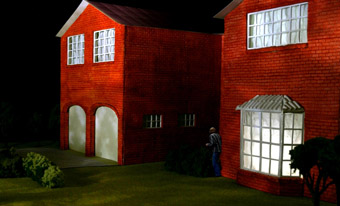
David Lawrey & Jaki Middleton, The world’s more interesting with you in it 2009
Image courtesy of the artists
David Lawrey & Jaki Middleton, The world’s more interesting with you in it 2009
As if mirroring the words of Sylvania Waters’ British director, Paul Watson, Jaki Middleton and David Lawrey have created a miniature version of the once infamous million-dollar waterfront home occupied by the Donaher family. In this three-dimensional environment, inserted into the a wall of the Hazelhurst Regional Gallery, the artists represent their video selves through the device of the Pepper’s Ghost, peering around the house’s garage and lurking in front of the bay windows of its living room. A replica Victorian streetlight wetly illuminates the empty driveway as the artists haunt the house’s exterior like apparitions of nosy neighbours.
Described as a long-term project by curator Daniel Mudie Cunningham, Reality Check deftly intertwines analysis and discourse around popular cultural forms of entertainment with the commissioning of works by 10 established and emerging Australian artists whose practices variously remix, retroactively adjust, repurpose or re-mediate our cultural ephemera. The exhibition is firmly situated within a specific locale; The Sutherland Shire where Sylvania Waters was filmed and the Hazelhurst Gallery resides. Reality Check not only focuses on the histories and legacies of this community—but how, in the rarified moment of Sylvania Waters, and through a single family, it shaped and challenged ideas of representation and the construction and international dissemination of national identity.
In Reality Check, the rapid proliferation of confessional-style entertainment and exploitative forms of television since the early nineties is of course a recurring theme. As a teenager and recent migrant to Perth at the time of Sylvania Waters’ original airing on ABC TV, I have to admit to never watching a single episode of the docu-drama that seemed to polarize the nation. In a 7.30 Report interview, accessible via YouTube, the Donaher family—in defence of themselves—grappled with the problematic and cynical machinations of so-called Reality TV; the subjective nature of which we now expect, enjoy and take for granted.
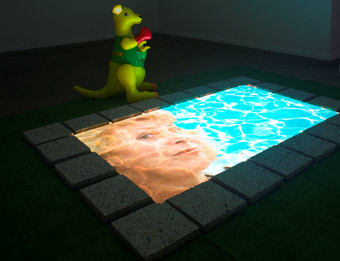
John A Douglas, Ask Noeline….(not the ogre) 2009
Photo by Silversalt. Courtesy the artist & Chalk Horse, Sydney
John A Douglas, Ask Noeline….(not the ogre) 2009
Cunningham’s exhibition is filled with phantoms of the Donaher family, from manipulation of actual Sylvania Waters footage, to representations of the home and family members; in particular their outspoken matriarch, Noeline. The Kingpins’ series of colour photographs and towering blonde-humanoid-wig-sculpture Blonde Ambition resurrect her domineering feminine presence and aggressive consumption of particular products: Jim Beam, Coke and Winnie-Reds. John A Douglas’ video installation, Ask Noeline…(not the ogre), reframes the ubiquitous Australian backyard pool as a kind of wishing-well where sound-bites of Noeline dispensing advice like an agony aunt are aired as her face shimmers across the screen’s blue surface. Carla Cescon’s installation with Donaher effigies situates Noeline’s caricature within the kitchen as the central hub of the family’s operations, while two shack-like ‘outposts’ on the grounds of the gallery are connected by walkie-talkies.
The exhibition space of Reality Check is filled with the sound of Elvis Presley’s Edge of Reality courtesy of Ms + Mr’s video Alternate Realities 1992/2009, which presents a spectral, uncanny parallel universe/narrative to Sylvania Waters by working with a video archive acquired through another Sydney-based family, the Archibalds of Glebe who were shortlisted, but not selected for the BBC show. In this work, several short scenes of the family interacting are treated as if the digital archive were permeable in real time: wormholes appear and people slip-through, while the poster image of Elvis (Time traveler? Alien abductee?) looms in the background. In Luis Martinez’ detailed pencil drawings, the Donaher mansion on Macintyre Crescent is contrasted against the humble Cabramatta home the artist was living in at the time, drawing attention to the wealth disparity of ‘average’ Australian families.
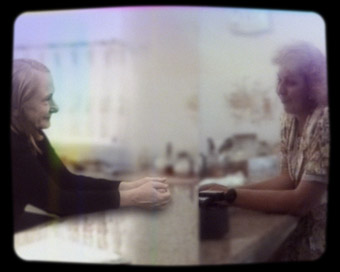
Ms & Mr, Archibalds/Donahers 1992/2009
Courtesy the artists & Kaliman Gallery, Sydney
Ms & Mr, Archibalds/Donahers 1992/2009
Elvis Richardson’s Sylvania Waters/Elvis Rants Away considers the constantly overwritten and obsolescing format of the personal VHS archive in two large-scale photographs representing VHS spines with assorted anagrams of the TV show’s title. Holly Williams’ card game Happy Families also addresses the decline of analogue forms of domestic interaction and play. The live-feed video installation of Archie Moore conversely reveals the instantaneous and manipulable nature of digital image-making technologies, effected directly upon the gallery visitor.
While the monochromatic abstractions and pared-back symbolism of Mitch Cairn’s work require a deeper knowledge of the Sylvania Waters episodes to adequately decode, they bring in to focus from my perspective the tendency to misread and misinterpret edited and decontextualised information or images—which is a constant criticism of the reality TV format. For Sylvania Waters novices (like myself), the curator has also assembled episodes from the series, Noeline Donaher’s one and only cringe-worthy hit single No Regrets, as well as works by artists who responded to the show at the time of it’s first screening including ceramicist Peter Cooley and performance artist Simon Hunt.
Seventeen years after Australia’s first brush with reality TV, the Hazelhurst Gallery’s curator, Daniel Mudie Cunningham has presented the organisation and its community with a curatorial coup. As an artist whose practice operates at a sometimes dazzling intersection between popular culture, performance art and fandom, Cunningham’s curation of Reality Check is richly informed by not only his creative methodologies but by rigorous research, as evidenced in the exhibition and it’s ambitious and thoroughly absorbing publication.
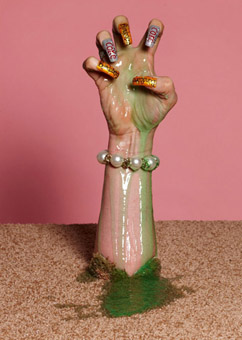
The Kingpins, Unstill Life 2009
Photo by Jordon Graham
The Kingpins, Unstill Life 2009
Reality Check: Watching Sylvania Waters, curator Daniel Mudie Cunningham, artists Jaki Middleton and David Lawrey, Elvis Richardson, Mitch Cairns, Holly Williams, The Kingpins, John A Douglas, Carla Cescon, Ms + Mr, Luis Martinez, Archie Moore, Hazelhurst Regional Gallery 10 Oct–29 Nov
RealTime issue #93 Oct-Nov 2009 pg.
© Bec Dean; for permission to reproduce apply to realtime@realtimearts.net
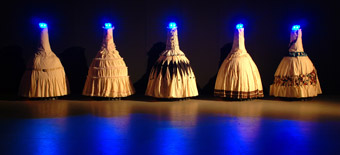
Wade Marynowsky, The Hosts, Performance Space
the artist
Wade Marynowsky, The Hosts, Performance Space
That huge foyer in Carriageworks: commodious enough to play jump-rope in, and wholesome enough too. It’s a chunk of light cut from the atmosphere in a heavy industry sized serving, populated in work hours by those expert occupiers of knee-grazing surfaces, small running children.
Then, you enter the show in Bay 21, and nothing could be more distant than the memory of that air and light.
When the double door thumps shut I can see only the stippled patterns on my retina in the dark. A beam of light pins me from above, radiating from a transparent dome two arm spans above my head, just over … there. It stirs, glides toward me, revealed as the crowning cupola atop a towering robot. Wearing a gigantic bustled dress.
The scale of the creature makes the theatrical dimensions of the space seem domestic, even claustrophobic; I’m the one built on the wrong scale, an interloper in another’s intimate space. My illuminated host makes me welcome nonetheless, stopping an alarming few centimetres away for a curtsy. It (she?) mumbles some indecipherable pleasantry, and as the lights and the sound swell, I can see the room throngs with these enormous things, marking out the sporadic steps of a disjointed dance that I seem to be the only one not to know.
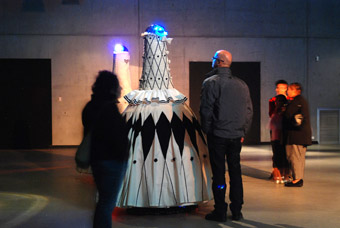
Wade Marynowsky, The Hosts, Performance Space
the artist
Wade Marynowsky, The Hosts, Performance Space
If these creatures owe something to the Victorian automata to whom their creator claims a debt, then it is the fashion. Their clothes are a pastiche of dress gowns, corsets, lace and military paraphernalia, an alien forensic anthropologist’s reconstruction of a Southern plantation ball demolished by stray cannon shot, familiar but dissonant.
Their performance lacks the endless repetition of those parlour automata. These are unsettlingly interactive, personal, provoking. Each robot approaches in turn, offers some vocal non-sequitur (“Do you love me?”) and then pirouettes, inviting me hopelessly to some dance you would surely need prostheses to participate in. I intuit with unease that my faculties are inadequate for the social world of these creatures, and find my ears trying to demodulate the drones that fill the room as a modem decodes signals from a telephone line. Have I stumbled onto a mechanical rehearsal for some obtuse celebration? Are these machines taken aback to find a human among them half way through their private training in the finer points of the graces of the fleshed? Or is that what they want from me? This performance doesn’t feel like spectacle—rather it fills me with the suspicion that I am the spectacle. As the indecipherable noise spilling from the ‘gramophone horns’ crescendos, it becomes so close in there that that it feels an effort to breathe. I go.
It’s not only the lace trimming that links this show to Marynowsky’s earlier robotics experiment, The Discreet Charm of the Bourgeoisie Robot [see Studio]. In both, Marynowsky plumbs the crevices of the shifting contemporary anthropology of robotics, and it is we punters who are on display, with the grating awareness of self that uncertainty about our observers provides. What are these beings? If the society of the 1800s was taken in by Wolfgang von Kempelen’s notorious hoax Mechanical Turk, are we perhaps more vulnerable to that same hoax today? How much looser might the criteria be now for an entity to merit social pleasantries, in this age of digitally mediated conversation, public surveillance, machine learning? There is a kind of inversion of the panopticon here. I know I am watched, but I do not know truly by what. Is it another of Wade Marynowsky’s telepresence hoaxes, or some automated trickery, or perhaps something more unnaturally intelligent? Is the moment at hand when we reprise our ancient animism, catching ourselves being polite to our appliances just in case there is an intelligent mind of any sort peering back at us that we might offend? Are we anticipating the time that our contraptions will accuse us of being mere imitations? In my case, I am startled and sheepish at the faint Frankenstein paranoia that characterise my part in this gothic techno social comedy of manners.
I do have to say, though, those preschoolers from the foyer love it.
The Hosts: A Masquerade of Improvising Automatons, media artist/artistic director Wade Marynowsky, electrical engineer Aras Vaichas, programmer Jeremy Apthorp, lighting Mirabelle Wouters, costume Sally Jackson, camera John Douglas, edit Sumugan Sivanesan; Performance Space 14 Aug-12 Sept
RealTime issue #93 Oct-Nov 2009 pg.
© Dan MacKinlay; for permission to reproduce apply to realtime@realtimearts.net
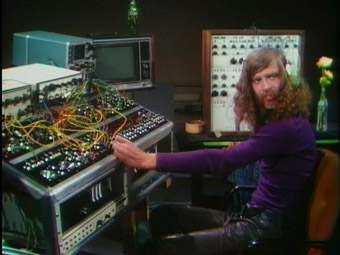
Stephen Beck
image courtesy the artist
Stephen Beck
A REVIEW OF THE ORIGINS OF VIDEO ART UNCOVERS A SIGNIFICANT, MULTIFACETED FIGURE, THE NORTH AMERICAN VIDEO ARTIST STEPHEN BECK, WHO DESERVES ACKNOWLEDGMENT FOR HIS CONTRIBUTION TO REAL-TIME AUDIOVISUAL PRODUCTION. THE CREATIVE PERSONALITY OF BECK’S WORK HAS TAKEN SHAPE IN VARIOUS FIELDS OF ARTISTIC EXPRESSION: VIDEO-SCULPTURE, INSTALLATION, MUSIC, PERFORMANCE, MUSIC VIDEO, VIDEOGAME DESIGN AND RESEARCH. THERE ARE NO DEFINITIVE BORDERLINES IN BECK’S WORK; HE EMPLOYS VIDEO AND OTHER TECHNOLOGIES TO TRANSLATE AND REPRESENT HIS SINGULAR EXPERIENCE.
Between 1969 and 1970, as an electronic artist in residence at the National Center for Experiments in Television (NCET) at KQED-TV in San Francisco, he developed the Beck Direct Video Synthesizer, an ingenious invention for the generation and manipulation of analogue images in real-time. With it he created a series of audiovisual performances, Illuminated Music, in 1972-73 before a live audience interpreting a musical piece previously recorded or conducted live, with the images displayed on television screens or by projectors. Performativity, spontaneity, ubiquity, the non-objective nature of the art work, its ephemeral quality and the immediacy of its representation highlighted the uniqueness of the work, translating the experience of the artist’s interiority into a non-verbal language with symbology and Eastern imagery. In Beck’s own words:
“I had the image come to me from listening to the music, and as I often do, much of my work in visual art and video is based on what I see with my mind’s eye, my eyes closed—inner imagery. I’ve seen inner imagery for as long as I can remember, even since I was a young boy—phosphenes, hypnogothic [sic], hypnopompic, eidetic, hallucination, meditation. So, as I would listen to the music and start to see certain visual elements I would notate them into the score for the visual composition.
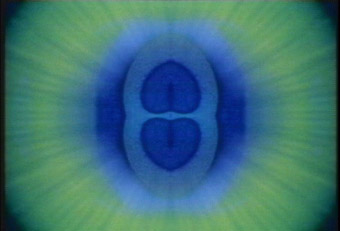
Yoni Glow, Stephen Beck
image courtesy the artist
Yoni Glow, Stephen Beck
“Now, in each performance of Illuminated Music that followed over the next two years, if you looked at all six of them, you would see there is a similar structure. It begins with these tiny rotating particles, suggesting perhaps, subatomic particles or some kind of magnetic, gravitational, orbital, based on sine waves, and then it kind of expands into these waves of lines and lace, becoming from one dimension of a point to two dimensions of lines and weavings. Eventually, solid smooth orbs and spheres appear along with a final spiral vortex, symbolising the great energy of the cosmos as [it] has been exhibited in many cultural icons throughout history.”
Beck reorients non-objective art in Illuminated Music I and II through an extraordinary communion with the soundtrack, a creative ‘synthony’ that demonstrates the multidisciplinary character of the artist’s background, with its roots in electronic music (Beck studied with John Cage at the University of Illinois). In his work we can perceive music as an inspirational source, both in the execution of the audiovisual work in real-time, and in the later addition of the sound as a component that determines the meaning of the audiovisual message. The structure of his message, as Beck himself describes it, presents certain analogies with jazz: the presentation and development of a theme with variations. Beck uses a grammatical syntaxis that gains strength with improvisation, the reading and in situ interpretation of a musical piece: “…that was kind of my concept, wanting to try to create a form of visual jazz, that would flow in time like music but be visual, and also have a compositional structure that was formal and intact, but still allowed for variations in the way that it was played and performed.”
Beck’s vision has technology and art flow together in a fertile encounter. At the end of the 1960s, Gene Youngblood, in his book Expanded Cinema (1970), a seminal work that embraced video and computers, demonstrated a collaboration between engineers and artists that was already happening in west coast America. In the vein of Harry Smith, Jordan Belson and the Whitney brothers, in the work of Beck we can appreciate the creative side of the man-machine symbiosis. Technology is a tool at the service of artistic expression.
With the works Colour Music and Lumia, Beck’s intention was to achieve a synaesthetic union of sight and sound—which could be expressed as “painting the music.” By creating and manipulating form, colour, texture and movement, Beck introduced the embryonic electronic image in constructing an audiovisual discourse in real-time. Beck’s 25 frames per second contributed to the acceleration of the processes of interaction and participation in new media. He says, “At this point, in terms of real-time video performance, that was pre-digital era. There was no programming, there was no pre-recording (of video), it was played live on the synthesizer.
“Well, I always like to say that my art spans from pre-digital to post-digital. Pre-digital meaning the era that I started, the late 1960s, when for all practical purposes, there was not much available to video artists in digital computing that could do a dot—draw one monochrome dot on a screen. It would take hours to draw some more, they had to be filmed with stop action, such as John Whitney’s work, Arabesque. Post-digital, meaning the current era, is all pervasive. I still describe myself as live and analog, meaning I prefer the analog texture, the analog approach, even though of course, I’m using digital tools, fully and completely now like everyone else because of the ease, convenience, quality control.”
Another of Beck’s most celebrated video pieces is Voodoo Chile (1982), a music video with recorded music from Jimi Hendrix, where we cannot separate music from image. In making Voodoo Chile Beck mixed real time with video editing: “All the varieties of scenes that you see in Voodoo Chile, optical seeding, video synthesis, a lot of use of video feedback, analog fractals, which I had learned to control with special circuitry in my Beck Direct Video Synthesizer to obtain video feedback-type effects and energies that were unique. And they also had the rights to an image of Jimi Hendrix playing the guitar, but my concept for Voodoo Chile was to not show Jimi Hendrix playing the guitar, but to show a light show-like visual interpretation of his music. Not, you know, a definitive visual interpretation, but my visual interpretation.”
Almost four decades have passed and Noor (2005-09) is Beck’s most recent project. Ambitious and in constant development, Noor is a live organism where imagery and motifs from Eastern cultures come to life through abstract form and patterns, models of representation and expression, showing the richness of Beck’s cinematic speech. Working in his laboratory, leading the Noor project and teaching at the University of California at Berkeley, Beck still chooses experimentation as a way to structure his vision of culture with video as a medium. Lately, he is exploring the creative possibilities of digital tools, searching in the language of programming for new forms of representation. Noor is a metaphor for Beck’s primary concern: trying to decipher and explain the complex consciousness of a human being, translating it with images in movement. “To me, the goal of my art is to inspire…to reveal the beauty of life in a world that is often filled with ugliness and tragedy and darkness. So working with light, working with video, working with Noor is the latest form, the latest path, the latest method by which I hope and intend to realize this vision.”
This article is based on an interview with Stephen Beck, January 12, 2009, Berkeley, California for Ustarroz’s forthcoming book, Vj-ing Theory—Audiovisual Production and Representation in Real-Time, A Link to the Cinematic Avant-Garde of 20th Century. For more on Stephen Beck: www.stevebeck.tv
RealTime issue #93 Oct-Nov 2009 pg. 35
© César Ustarroz; for permission to reproduce apply to realtime@realtimearts.net
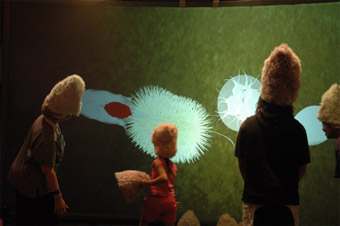
Metazoa, 2008, Angela Main, Super Human Exhibition
courtesy the artist
Metazoa, 2008, Angela Main, Super Human Exhibition
FOR THOSE FEELING THE URGE TO EVOLVE, MELBOURNE IS THE PLACE TO BE IN LATE NOVEMBER AS LEADING MEDIA ARTS MAKERS, COMMENTATORS AND HISTORIANS CONVERGE FOR THE ANAT’S SUPER HUMAN: REVOLUTION OF THE SPECIES. CELEBRATING THE 150TH ANNIVERSARY OF THE PUBLICATION OF DARWIN’S ORIGIN OF SPECIES, THE EVENT INVOLVES A SYMPOSIUM, MASTER CLASS AND MONTH-LONG EXHIBITION EXPLORING COLLABORATIONS BETWEEN THE SCIENCES AND THE ARTS AND THE IMPACT THESE HAVE ON BEING HUMAN.
Keynote speakers for the event include Ju Gosling (UK), working with digital lens-based media exploring ideas of the able and disabled body; Tami Spektor (US) an organic chemist with an interest in nanotechnology; Barbara Maria Stanford (US) who explores the intersection of visual arts and neuroscience to shape our senses; Paul Brown (UK) media artist exploring robotics and neuroscience; and Junichi Ushiba (Japan) who has developed the Brain-Machine Interface (BMI), offering the potential for people to operate avatars in SecondLife just by thinking about it.
There will also be two days of masterclasses with a wide range of international and Australian artists, curators and thinkers with practical advice on resource networks, marketing and audience development, as well as theoretical discussion, from the likes of Amanda Macdonald Crowley, George Poonkin Khut, Lizzie Muller, Kim Machan, Jens Hauser and Sarah Cook.
Wedged between the Symposium and Masterclasses is Re:live 09, an International Conference on the Histories of Media Art, Science and Technology, which will dig through the vault for alternative histories of the media arts, with presentations by three keynote speakers. Zhang Ga is a media artist and director of the Netart Initiative, responsible for the large scale public artwork, People’s Portrait, part of MAAP04 which utilised big screens in New York, Singapore, Brisbane, Linz and Rotterdam to display photos of a participating general public. Lisa Gitelman is co-author with Geoffrey B Pingree of New Media, 1740-1915 (2004) which extends the idea of new media as a phenomenon of the 20th and 21st centuries exploring what new technologies meant culturally in the 18th and 19th centuries. Making a welcome return (he was a lecturer at UTS in the 90s) Doug Kahn is best known for excavations into the history of sound in the arts in his books Noise, Water, Meat (1999) and Wireless Imagination: Sound Radio and the Avant-Garde (1992). Kahn will also be one of the Superhuman Masterclass presenters as well as delivering a series of lectures around the country courtesy of ANAT’s Embracing Sound Program and their partnership with Art Monthly. Nested within Re:live will be the Leonardo Education Forum.
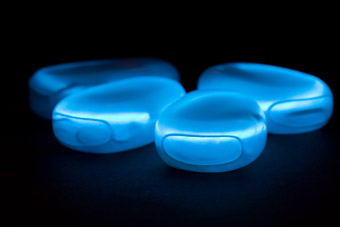
Drift, 2009, Leah Heiss, Super Human Exhibition
courtesy the artist
Drift, 2009, Leah Heiss, Super Human Exhibition
The Super Human Exhibition will run for the entire month at RMIT Gallery with works by Justine Cooper, Jonathan Duckworth, Donna Franklin, Tina Gonsalves, Leah Heiss, George Poonkhin Khut, Angela Main, Brad Nunn, Jill Scott, Paul Thomas, Tissue Culture & Art Project and Mari Velonaki. Other aligned activities include a SymbioticA workshop just prior to the conference and ABC’s Pool presenting a new thematic space called Gene Pool. By December, the human race may well have advanced a step or two along the evolutionary pathway or, at the very least, the well-being of new media art ecology will have been given a boost. RT
ANAT, Super Human, Symposium Nov 23-24, BMW Edge, Federation Square; Masterclasses Nov 25-26; Exhibition, Nov 5 – Dec 5, RMIT Gallery, http://www.superhuman.org.au/; Re:live – The International Conference on the Histories of Media Art, Science and Technology Nov 26-29, http://www.mediaarthistory.org/relive/; Melbourne
RealTime issue #93 Oct-Nov 2009 pg. 34
© RealTime ; for permission to reproduce apply to realtime@realtimearts.net
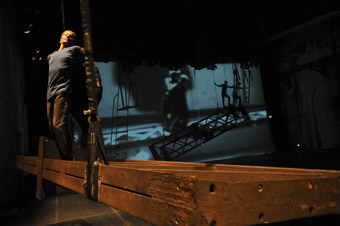
Peter Fraser, Linda Luke, Run: a
performance engine
DE QUINCEY COMPANY TRAINING IS SO CELLULAR, SO DEEPLY MUSCULAR, SO FULL OF BONE AND BLOOD, THAT THERE IS NO ESCAPE FROM FULL COMMITMENT TO TASK. BODY WEATHER PRACTICE MAKES ATMOSPHERIC PERFORMANCE: THICK WITH THE HEAT OF BODIES ENGAGED EVEN TO QUANTUM LEVELS.
Entering a DQC performance is to enter a world already ripe with the design and breath of what is to happen. Run did not feel like that. In a huge space, splintered, fractured and cold, dancers were initially held at a distance, making shape against lines of steel and pendulous sculpture. Surprisingly choreographic, Run did not immediately grab my guts. But amidst a harsh landscape a gentle build began to gather. Eventually, my stomach lurched with the drops and swings of heavy scaffold and vulnerable flesh, my cheeks pinked up with a familiar and sympathetic heat. No longer dancing from their skin and shape Tom Davies, Victoria Hunt, Linda Luke and Peter Fraser began to dance from their intestines and their sweat: ah, here it is.
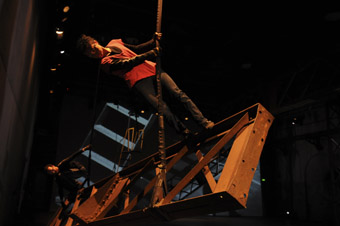
Tom Davies, Victoria Hunt, Run: a performance engine
Kudos to musician Dale Gorfinkel who came from Melbourne at a ‘moment’s notice’ to replace the ill Jim Denley. He sits on the floor with his back to the audience. Before him is strewn a miniature ‘orchestra’ of detritus: broken polystyrene, balls, tubes and all manner of unrecognisable gadgets. The sounds he creates from this barnyard of objects are often gentle, sitting below the surface of the action, only occasionally lashing out into rips and screeches. Sound itself is made apparent and performative by the various ways it enters flesh: ringing, vibrating, stinging, humming, droning. Sound hangs, lingers and shoots; sometimes funny or ominous, sometimes rhythmic and then almost invisible in its subtlety. Gorfinkel rattles, rings, dongs, chimes, bubbles, taps, vibrates, flicks and buzzes. When this music disappears it is only to reveal a distant but persistent hum coming from a somewhere, a bass line to his band and an archetypal comment on a world made of scaffolding.
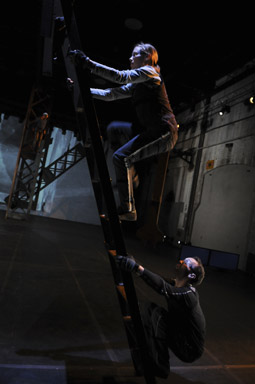
Linda Luke, Tom Davies, Run: a performance engine
photo Heidrun Löhr
Linda Luke, Tom Davies, Run: a performance engine
Linda Luke creates the opening image of a woman trapped in steel. She shifts her metal encased head in delicate axial glides that will break the fusion and start this hanging sculpture swinging. Throughout, this hunk of weight will turn, twist and sway, making visual the forgotten forces of gravity, weight, girth, solidity, steadiness, lift, fall, recovery, support, strength, thickness. The ebb and flow of energy meeting mass is made metallically graceful.
Sitting inside this beauty is the danger. These strong muscled dancers trust completely the ropes from which the mammoths hang. They ride, weave and duck in smooth timing, loving the steel that could smash and wither. Small gasps escape audience mouths as a scaffold flips and drops, taking bodies with it. Straight lined hunks of iron swing across my eyes, making arcs. Dancers jump over creaking metal carousels, which in their oncoming certainty crack, groan and grind out irresistible rhythms only to swing themselves into silence.
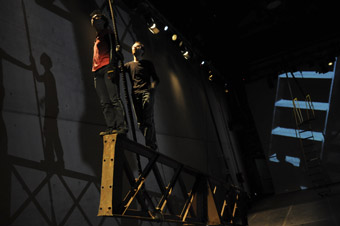
Victoria Hunt, Tom Davies, Run: a performance engine
photo Heidrun Löhr
Victoria Hunt, Tom Davies, Run: a performance engine
Feeling the mobile weightiness of such large sheets of metal was moving. And the ride the dancers took on them was titillating in its peril and satisfying in its accomplished ease. The program states that this “6 tonne dramaturgy” allowed the performers to “fly the space”. Hmmm, not so sure. ‘Flight’ is lift, take off and soar and Run was far more gravitational than this. Run was more earth than sky, more bowel than wing. Bounded groundedness was its thing.
In the mix with the dancers’ surfing on the laws of physics was the mediating technology. Live feed cameras created huge grey ghosts from coloured performers, making shadows dance on shadows of shadows, layering performing multiplicities in the same instance. Close-ups of steel revealed abstractions of monochromatic texture and pattern. Screens, hidden before, emerge, one after the other, revealing doorways of light. These are entrances to a moving stream of manipulated live images, smearing action across virtual depth as a beam of light is smashed into rays across the floor.
Production is performed as Travis Hodgson and Emmanuela Prigioni, sit on shinier, more modern scaffolds, creating worlds of light and video image. The roof and walls of CarriageWorks Bay 20 become sky in this “the scaffolding of the world”. So, so, so much to see, everything is interesting.
Do the dancers get lost in all of this density? Sometimes. But this is a sensible swamping to render them part-of; perhaps a gang of crazy bridge builders working in a landscape so much bigger than themselves. They dance in solos, duets, trios but rarely foursomes. They hug, fight, hang and laugh. They speak text that somehow seems like light relief. Walking on steely air, they slide down ladders, tangling with each other. Victoria Hunt is hurled and flipped by an invisible tormentor so violently I feel hurt. At denouement I am tired, over-stimulated, hot and twitching. It only ends when Gorfinkel stops and then there is that gap, where the audience is silent and slightly stunned: sitting inside that bassline hum that never went away.
–
De Quincey Company, Run: a performance engine, direction, choroegraphy Tess de Quincey, performers Tom Davies, Peter Fraser, Victoria Hunt, Linda Luke, sculptural installation and rigging Garnett Brownbill, Bernie Regan, lighting design Travis Hodgson, music Dale Gorfinkel, video artist Emmanuela Prigioni, media installation John Tonkin; Performance Space, CarriageWorks, Sydney, Aug 20-29
RealTime issue #93 Oct-Nov 2009 pg. 36
© Pauline Manley; for permission to reproduce apply to realtime@realtimearts.net
{$slideshow} PHILLIP ADAMS’ CHOREOGRAPHY SOMETIMES REPEATS A PHYSICAL ACTION UNTIL IT ACHIEVES THE TRANSCENDENT EXTREMITY OF RITUAL. BY TAKING ON THE SUBJECT MATTER OF MASS HYSTERIA AND APOCALYPTIC CULTS, WHERE THE HELD BREATH OF EXPECTATION IS CLOTHED IN MANTRAS AND CYCLICAL BEHAVIOURS, HE HAS FOUND A FITTING UNDERPINNING FOR HIS NEW WORK, MIRACLE.
Balletlab’s Brindabella (2007) was bisected by four dancers jogging in near-unison around the stage. This went on far longer than one expected and, in doing so, suspended the audience from any act of judgement or any desire to draw literal meaning. This was a relatively unadorned pause in between more elaborate worlds on either side. It acted as an enforced threshold, the thud of footfalls was mesmeric and the circling bodies hypnotic. We were being lulled into a different state.
In Miracle, it’s all about different states—the hallucinatory, the delusional, the ecstatic, the postmortem. We start in a state of quiet dislocation. The space is filled with brightly lit haze, creating an obscuring curtain of white. As the haze fades, four figures are revealed far back on the stage. They stand in a line, in loose-fitting robes: orange, yellow, blue, green. The costumes, by fashion designer Toni Maticevski, are a confectioner’s riff on tie-dye.
The dancers retain their stance and their silence for a long, enticing moment. After all, when you are waiting for the end of the world, anticipation is the key. Then, suddenly, and with great force, the sky opens up and peals of sound rush forward along with the dancers. Their bodies carve out a diagonal sweep and the speakers crush out an orchestrated wall of strings, voices and beats. Holding hands, the dancers retrace their steps, their mouths agape with cries, and they cross forward and back again and again until their efforts drive them into prostration. The effect of such intensity could be galling, eviscerating or transformative but the emptiness of the stage, marked simply by a square of grey, and the swathes of movement suggest an animated Franz Kline painting: urgent and physical, but safely contained on canvas.
In a question and answer session after the show, Adams felt that this particular run of Miracle had been “too cosy, too comfortable” for the performers. He stressed the importance of the hysteria being experienced, not merely represented. Yet he also spoke of his desire to achieve a “cinematic” effect. Perhaps he meant something else with this statement, but it seemed at times that the performers were fully enveloped by the experience, yet in the vast reaches of the Meat Market they were held at a projected distance from us that was neither threatening, nor fully engaging—we were invited to watch them but not to feel like one of them. We witnessed hysteria and ecstasy, but were never transported to that state ourselves.
Hysteria and performing arts are hardly strange bedfellows. The success of a theatrical experience usually demands a communal suspension of disbelief, arguably an act of mass hysteria. Thus, in making the experience of hysteria the sine qua non of Miracle, Adams binds the success of his concept and choreography to the success of its mass reception.
Nevertheless, even on a “cosy” night when the fever doesn’t quite set in, the extraordinariness of Miracle’s components is apparent. The stunning score is a joint creation by David Chisholm and Myles Mumford. They mix and process a range of diegetic and recorded sources, live for every performance, in what they describe as a “plunderphonic” composition. In the large, blank space, the multiple speakers cut through the air giving shape to the void.
The performances, despite Adams’ qualifications, display a rare mix of sensitivity and visceral dedication. BalletLab’s work has increasingly tilted towards the second part of its name and the exploratory nature of experimentation requires a very different specificity to that of ballet. Like Deborah Hay’s company of dancers in the recently toured If I Sing to You, the dancers in Miracle are constantly aware of the whole and not just themselves. The result is an apparent freedom of form, an organic flow of actions and reactions that feel autonomous rather than directed.
This performative freedom and the permutations that result suggest the centrifugal whirling of a dervish. From the original point of stillness and silence, Adams spins Miracle into sound and fury: we pass whirling rag balls and extension cables, we circle bullhorns and clogs until, in a final astonishing image, having exited Earth’s gravitational pull, Miracle hovers weightlessly in a moment of divine suspension.
Balletlab, Miracle, choreographer, director Phillip Adams, dancers Brooke Stamp, Clair Peters, Luke George, Kyle Kremerskothen, composers David Chisholm and Myles Mumford, lighting design Bluebottle, Jenny Hector, costume design, Toni Maticevski, Arts House, Meat Market, Melbourne, July 15-19
RealTime issue #93 Oct-Nov 2009 pg. 37
© Carl Nilsson-Polias; for permission to reproduce apply to realtime@realtimearts.net
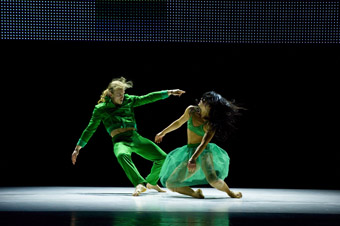
Troy Honeysett, Emee Dillon, G, Australian Dance Theatre
photo Chris Herzfeld
Troy Honeysett, Emee Dillon, G, Australian Dance Theatre
WHAT IS IT ABOUT A CLASSIC REVIVED THAT COMPELS OUR ATTENTION? IS IT THE SHEER MIRACLE OF RESUSCITATION? THE GHOULISH LURE OF A ZOMBIE, RAISED FROM THE DEAD? OR JUST SOMETHING COMFORTABLY FAMILIAR MADE NEW, LIKE AN OLD PAIR OF JEANS, CUT-OFF, PATCHED-UP, DYED GREEN PERHAPS?
We put an emphasis on experiment and innovation in valuing the creation of new work. But isn’t performance always offered in repertoire—a repetition of the past, a rehearsal, a re-presentation, served each time afresh? Australian Dance Theatre’s G is just such a work, the dancers like some ancient layered archive, accumulating and re-performing the choreography of our culture’s obsession with romance.
G is short for Giselle, the famous classical ballet, first performed in Paris by the Ballet du Theatre de l’Academie Royale de Musique in 1841. Its revival by Marius Petipa for the Imperial Russian Ballet in the 1880s and 1900s defined the choreography performed by ballet companies to this day. Since the 1940s, Australian audiences have seen Giselle in productions from the Australian, Royal, Bolshoi and Borovansky companies. The Australian Ballet last performed the work in 2006 and 2008.
G was seen as a work-in-progress at the company’s Adelaide studio in March 2008, and premiered in Utrecht later that year. From the Netherlands, it toured through Belgium, Luxembourg, Spain, France, Italy and England before returning recently to Adelaide in 2009 for a season at the Dunstan Playhouse as part of the Adelaide Festival Centre’s Pivot(al) dance program. As a classic case of postcolonial playback, the work has struck a chord with European audiences, and will return to France in November. It also has an affinity for Australian audiences: the Adelaide season was a sell-out and spectators were enthusiastic in applause. It deserves seasons elsewhere in Australia.
In its choreographic intent, G is akin to Birdbrain, the ‘deconstructed’ Swan Lake from 2000 which was Garry Stewart’s first full-length work for ADT. But the modus operandi of this work is not so much deconstruction as truncation and compression. The names of characters are reduced to letters: G, of course, who falls in love with L, who is really a prince named A betrothed to Princess B.
The narrative is similarly cut-up into isolated gestures and stilted fragments, which nevertheless flow past in a stream of body-images and image-objects. Arms crossed in love, hands clasping hearts, swords at hearts, heads thrust back, heads hung low, bodies thrown down and danced upon, a procession of pine trees—the whole story of Giselle, her lovers and their demise is danced in 60 minutes— from left to right.
That is, the dancers process continuously across the stage from left to right in various ways. They make the round trip backstage, of course, and thereby create the panoramic illusion of perpetual flow. There is a great deal of pleasure to be derived from this simple operating premise—from the changing rhythms, speeds, the body densities of the flow, and from entrances that follow exits almost impossibly too soon.
The meanings implied in this ruthless circularity accumulate throughout the work, resonating with that great romantic mystery at the centre of Giselle: the eerie possibility that one could dance oneself—or, more mysterious still, be danced against one’s will—to death. Along the way, the dancers’ moves lay down a lovesick palimpsest of sex, desire and death. This is the choreography of romance in mutation—dug from within and exposed to view like some kind of bio-archaeological excavation.
Colour is a key. The dancers are lit, in part, by Geoff Cobham with a massive electronic screen. Their dancing arcs from the classic choreography of ballets blancs to encompass the excess of gothic horror in black and red, and the surreal formalism of music video in green and blue. Captions are another key which flicker across the screen: narrative fragments with words cut out and streams of words beginning with the letter G—among them, ‘gothic’, ‘grief’ and ‘gonorrhoea.’ The music from Luke Smiles is orchestral and ethereal at times, but mostly it is slavishly metronomic in effect, securing the commitment of the dancers to delivering the work’s unrelenting flow.
Shudder, freeze and flicker are the strongest movement-images that I logged alongside the luminosity of the work’s signature colour, green. Green for jealousy, of course, and also green for feeling queasy. G is a classy diagnostic for assaying the lovesick among us.
–
Adelaide Festival Centre Pivot(al): Australian Dance Theatre, G, conception, direction, choreography and set design Garry Stewart, performers Chris Aubrey, Emee Dillon, Amber Haines, Troy Honeysett, Daniel Jaber, Lauren Langlois, Lina Limosani, Larissa McGowan, Kialea-Nadine Williams, Kimball Wong, lighting design Geoff Cobham, composer Luke Smiles/motion laboratories, costumes Daniel Jaber, Gaelle Mellis, Dunstan Playhouse, Adelaide Festival Centre, Aug 25-29
RealTime issue #93 Oct-Nov 2009 pg. 37
© Jonathan Bollen; for permission to reproduce apply to realtime@realtimearts.net
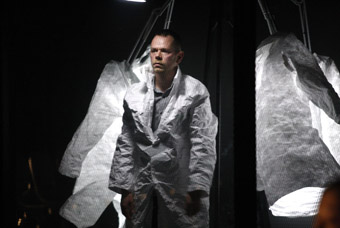
Anthony Hamilton in Corridor (2008), Lucy Guerin Inc
photo Jeff Busby
Anthony Hamilton in Corridor (2008), Lucy Guerin Inc
ANTONY HAMILTON IS A RELUCTANT MAN OF THE MOMENT. “A FEW THINGS HAVE HAPPENED AT ONCE”, HE ADMITS, “BUT NOTHING HAS CHANGED FOR ME PSYCHOLOGICALLY. THERE IS AN EBB AND FLOW, BUT I HAVE BEEN WORKING AS HARD AS EVER FOR 10 YEARS.” WE ARE TALKING ABOUT HAMILTON’S RECENT RUN OF ACHIEVEMENTS AS PERFORMER AND CHOREOGRAPHER ON THE EVE OF HIS DEPARTURE FOR BERLIN AS THE FIRST RECIPIENT OF THE TANJA LIEDTKE FOUNDATION FELLOWSHIP.
Hamilton is right to indicate that he is no blow-in. He has long been one of the most distinctive dancers in Australia, contributing to the work of Lucy Guerin Inc and Chunky Move in particular. He has also been quietly making work of his own for initiatives such as ADT’s Ignition program and Lucy Guerin’s Pieces for Small Spaces, as well as adding to the repertoire of Stompin’, Dance North and Rogue. Hamilton has also made work with students at the VCA and created choreography for bands such as The Presets.
In 2009 Hamilton’s profile as a choreographer has been enhanced through the two Greenroom Awards for his 2008 self-produced Blazeblue Oneline and the glowing audience and critical response to his Chunky Move commission, I Like This, co-directed with Byron Perry. His receipt of the inaugural Liedtke Fellowship follows his 2004 receipt of the inaugural Russell Page Fellowship, indicating that his is the work which prevails when new choreographic talent is the priority.
Hamilton is leaving for Berlin and concedes to feeling rather nervous about this solo expedition, after so many years of international touring in companies. “There is a lot of pressure. A lot of people will be watching.” He will work with members of Sasha Waltz’s company at Radialsystem V, bringing Australian expatriate dancer Melanie Lane into the collaboration. He is also hoping to work with Berlin-based British graffiti artist Mode2. “It is great to be allowed to experiment within a dance fellowship”, he says. “There are no parameters about the form.” Hamilton will spend seven weeks in the studio, presenting his research at the Asia Pacific festival curated by Radialsystem in October. He has no plans to create a production from this residency. His main aim is “to embed myself in Berlin and really live it.”
This collaboration with a street artist and a dancer is indicative of where Hamilton’s interests lie. “I am keen to bring fashion and visual arts to the table”, he says. “But I am passionate about dance in the traditional sense. I am not that into hybridising work. I’m quite a purist when it comes to choreography. If you just touch the edges and then add other things, you are only going to diminish all the forms.”
This might read as something of a surprise to fans of the searingly cool Blazeblue Oneline which won its awards for concept realisation, set and costume design. Yet Hamilton is clear that his time in the trenches as a performer is what has enabled him to articulate his vision so clearly and that his incorporation of other media is only possible because of his life-long commitment to choreography. “Choreography has always been my calling. In order to be a great dancer, you have to imbue everything you do with a sense of choreography.” He is particularly proud of his 2009 Helpmann Award for Best Male Dancer for Chunky Move’s Two Faced Bastard. “That meant a lot. Two Faced was a performer-driven show. I did a huge improvised solo at the end and was given space to deliver myself on stage.”
“I am deliberately taking a break from working with choreographers now”, Hamilton says. ”I haven’t made any new work with Lucy [Guerin] or Gideon [Obarzanek] all year. The last thing I did was [Guerin’s] Untrained. While I always welcome touring, I need to take this break as much for myself as for the choreographers. It is important to create space for other artists.”
Hamilton has a “strong desire to create opportunities for people who haven’t had many chances.” He has just made a piece with third year VCA students and encouraged them to create their own openings in the way that the Rogue collective has done. ”Young artists have to improvise and shape-shift to move within an increasingly fluid cultural and financial landscape”, he says, talking as much about the trajectory of his own choreographic career. Hamilton took four years to produce Blazeblue Oneline. “I think artists are hard-wired to think in the moment. It is hard to project forwards. I have just finished the development of a new piece but have no real sense of where that is going.”
Hamilton is fortunate enough to have a couple of producers on board to do some of that projection with him. He is part of the MAPS initiative, managed by Strut & Fret in Victoria. They are hoping to take Blazeblue Oneline to APAM (Australian Performing Arts Market) in 2010 and Chunky Move will continue to seek touring opportunities for I Like This. Hamilton will travel to France for three weeks in December to make a piece for the Lyon Opera Ballet. This opportunity arose, as seems to be the pattern for Hamilton, through the impact of the work alone. He was encouraged to apply to the Rolex Mentor and Protégé Arts Initiative in 2008. Whilst he was not a winner, Yorgos Loukos, Director of the Ballet, was on the Rolex panel and was impressed by the DVD of Blazeblue Oneline. He sought Hamilton out to contribute to a triple bill of new work which will be presented in France in June 2010.
Despite the opportunities offered by the European projects, Hamilton has no plans for global domination. He is reticent when it comes to networking and approaches his residencies with a calm focus upon the work in hand. “I try not to follow trends”, he says, “I almost prefer not to know what is going on. I am happy to be doing my thing. It’s about remaining inspired with what you do regardless of any accolades.”
Tanja Liedtke Foundation, www.tanja-liedtke-foundation.org
RealTime issue #93 Oct-Nov 2009 pg. 38
© Sophie Travers; for permission to reproduce apply to realtime@realtimearts.net
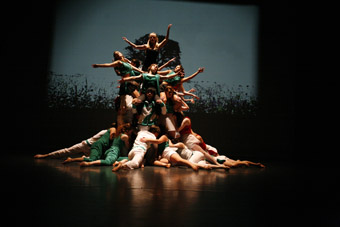
Quantum Leap
photo Lorna Sim
Quantum Leap
TELEVISION PROGRAMMING IS NOW REPLETE WITH COMPETITIONS FOR FATTIES, THINNNIES, WANNABIES, HAS-BEENS, FAMOUS AND INFAMOUS. MICHAEL’S GONE, BUT HIS VIDEOS AND HIS SHUFFLE WILL NEVER DISAPPEAR. BUT HOW DO BODIES DO THAT? AND WHOSE BODY IS DOING THAT? AND IS IT ALRIGHT FOR THAT BODY TO BE DOING THAT?
Dance and dance training brings along with it so many issues to do with ethics. For what are we responsible when we choreograph, or teach bodies to dance? Are we answerable to particular aesthetics or, ethically, to innate human potentials?
From the mid-20th century there have been many challenges to the primacy of ballet technique as the basis for training in Western dance. Especially since the advent of so-called postmodern dance (associated with the Judson Church in New York), processes derived from ordinary physiology, everyday movement (incorporating the notion of ‘least effort’) and sensory relationship have informed choreographic development. Along with the freedom that such new aesthetics have created, however, arises another problem. How do we know what we are looking at? What are its values, its strengths, its achievements? Is it any ‘good’ or not?
Such issues are heightened where dance is created with and for people with differently-abled bodies. London’s Candoco Dance [established in 1991], a company choreographing for mixed groups of professionals, with or without legs, produces stunning work. Similarly, Entelechy, a company based in south-east London, includes people of multiple and severe disabilities and also works with people with dementia or Alzheimer’s disease. Their process creates a nexus between movement, music, and sensory-based experience: “She likes soft cakes, not biscuits, rice on hands, African spices, the sound of water pouring.” Their outcomes make apparent the moving beauty of thoughts and ideas at work beneath the skin. It makes you think how often our ideas of ‘dance’ come pre-fixed, limiting what we see, how we see it, and what we choose to show.
The genre of youth dance, too, can be straitjacketed by the limited perceptions of its own audience, as evidenced in criticism of Quantum Leap ensemble’s recent Canberra Playhouse season. Select Option—a vibrant, inventive, often stunning show—was berated for failing to display any “real” choreographic pizzazz, collaboration or participant autonomy: “It was evident that the young performers did their very best to keep the grown-ups happy…doing what they were told to do and saying what is expected of them to say” (artsHub, July 31).
The criticism is curious, as all Quantum Leap projects—and especially this one—incorporate a considerable degree of technical training, as well as collaboration in terms of research, subject matter and choreography. Participants have extensive input with guest choreographers in devising structure and narrative both as text and via movement. The results, of necessity, transform subject materials into somewhat more abstract configurations. The achievements are thus sometimes difficult to quantify, but at the very least there is always evidence of a complex relationship between the kinds of freedom and looseness one would expect from ‘youth’, and the sharpness and exactitude which comes from applying technique and bringing ideas into form.
John Berger points out that this tension between structure/training and freedom/intuition is endemic to every form of art and making. Note that he makes a case that this kind of awareness is necessary for the audience:
“Capitalism has brought with it a higher and wider degree of self-consciousness than ever existed before. Self-consciousness [ie structure, training. Ed] is an advance beyond a life of intuition. But the final creative aim of self-consciousness must be to consciously lose itself, to return to a reliance upon
intuition within certain consciously created limits. To live as the athlete runs or jumps or swims. Art also needs the same kind of controlled liberation of intuition—in both artist and spectator…” John Berger, A Painter of Our Time, 1958
I sometimes wonder at the level of narcissism in an audience. Does the performer ‘move me’, or ‘move for me’? And is that all we’re there for?
Select Option was composed of a sequence of episodes brought together by two distinct musical compositions in each of its performance halves. There are deliberate variations in style, from break dance to street funk, classical to contemporary, linked with music, projected film and text.
Skill levels varied, across different areas. A young dancer, hardly moving in a pool of light, explored her sensual stage magnetism; a line of boys expelled their braggadocio drives in a thrilling street dance. The simple device of one dancer after another climbing up a pyramid of bodies was a good metaphor for the aspiring, searching, and mentoring of this age group—an abstract visual counterpoint to the video vérité interviews around a teenager’s ‘choices’ projected upstage later in the show. Each exploration seemed appropriate to the age and respective maturity of the participants, their life experiences, the strength of their bodies in friction with their emotional uncertainties. Clearly, these young dancers are being ‘extended’ in different dimensions.
In the first half, London-based choreographer Liz Lea explored meanings of the colour red, from its associations with sexual liberty (the ‘scarlet woman’ in an evening dress) and flamboyance (clown/cabaret/burlesque) and themes to do with individuation versus conformity in a very moving ensemble segment—12 women in 12 squares of red light, arching and backbending, in line but each lit by their own grace. Nicholas Ng’s gorgeous musical ‘take’ on ‘finding yourself’ as reflected in the Indian tonalities of his composition found nice parallel with Lea’s aesthetic, influenced by her extensive training in Asian martial arts.
In the second half, Marko Panzic and Reed Luplau combined high athleticism and street funk in their respective choreographies, exploring attractions and rejections and the sheer thrill of high kicks, backflips and group dynamics, especially strong in the sequences for the boys. Fourteen-year-old Jack almost outdid them all, but so clearly expressing—and allowed to express—the condition of his young body with such poignancy. His shoulder shimmy was inescapably that of a young boy. Allowing that simple, physical fact to stand told me a million stories about who he is, how time is still ahead of him. No cover-up here: this is a rare, humbling and quite exquisite viewing experience.
It probably takes a lifetime to understand our own sense of agency and relative freedoms. I think we can make a better attempt to appreciate what is there, not just what we expect to see, and try and examine more deeply the cultural imprimaturs we unconsciously bring with us every time we enter the theatre.
QL2 Centre for Youth Dance, Select Option, 44 dancers aged 14-23, choreographers Ruth Osborne, Brian Lucas, Liz Lea, Marko Panzic, Reed Luplau, composers Nick Ng, Adam Ventoura, video Bearcage Productions; Canberra Playhouse, July 29-Aug 1
RealTime issue #93 Oct-Nov 2009 pg. 38
© Zsuzsanna Soboslay; for permission to reproduce apply to realtime@realtimearts.net
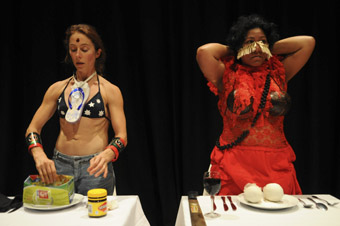
Kathy Cogill, Latai Taumopeau, Intercultural Project, March 2009
photo Heidrun Löhr
Kathy Cogill, Latai Taumopeau, Intercultural Project, March 2009
IN LATE 2008, THE FONDUE SET’S EMMA SAUNDERS WAS APPOINTED BY LISA HAVILAH, DIRECTOR OF CAMPBELLTOWN ARTS CENTRE (CAC), TO DEVELOP A THREE-YEAR CONTEMPORARY DANCE PROGRAM. THE COMPREHENSIVE AND AMBITIOUS PROGRAMMING THAT HAS RESULTED IS THRILLING IN THE CURRENT CLIMATE, PROVIDING AN ALTERNATIVE AVENUE FOR MANY SYDNEY-BASED CHOREOGRAPHERS SEEKING A PLACE TO WORK AND PRESENT. GENEROUS SUPPORT FROM CAMPBELLTOWN CITY COUNCIL, THE AUSTRALIA COUNCIL FOR THE ARTS AND ARTS NSW HAS BEEN WELL SPENT WITH STRANDS DEDICATED TO INTERDISCIPLINARY, INTERCULTURAL, STUDENT, ABORIGINAL AND COMMUNITY RELATED PROJECTS, PLUS RESIDENCIES, COMMISSIONS AND PRESENTATIONS.
The range of artists passing through the centre so far this year has included Brian Fuata, Kathy Cogill, Latai Taumopeau, Julie-Anne Long, Rosie Dennis, Kimberly McIntyre, Lizzie Thompson, Jane McKernan, Martin del Amo, Vicki Van Hout and Kay Armstrong’s youth dance company, youMove.
Havilah’s decision to resource producer positions and employ artists in such roles, has fuelled an expansion of the Centre’s offerings well beyond its established visual arts programming. Havilah believes that artists are best equipped to put in place long-term strategies for the support of other artists and development of new work, providing institutions with an understanding of the process from the inside out. The focus is on supporting new work and “multi-arts practice”, with a strong emphasis on artist-led engagement with communities in South-Western Sydney—specifically Pacific and Aboriginal communities. The richness of traditional art forms in these communities has been largely excluded from contemporary art practice in NSW and Havilah’s aim is to create a long-term strategy to support the process-driven, intensive commitment that cross-cultural initiatives demand.
Campbelltown Arts Centre’s facilities include studios, workshops, a 200-seat studio theatre and artist accommodation, along with placements in community venues. With the ability to take a work from development to small scale presentation, CAC differentiates itself from the Critical Path choreographic laboratory in Rushcutter’s Bay. CAC also offers a curated program (involving guest curators) built around artists who “fit Campbelltown’s broader programming requirements,” as well as the various strands of the dance program. The aim is to fill the gaps in the sector which Emma Saunders has identified as being in the second and third stages of the development of new work.
Surprisingly, finding established artists with community engagement as part of their practice has not been difficult, and Saunders believes that the Centre’s curatorial agenda could influence patterns in creative practice in NSW dance. Various experiences, including remounting The Fondue Set’s Hoofer performance with 90 high school students, have made Saunders an enthusiastic supporter of community-engaged practice. “Artists respond to what’s funded so, if artists begin to think about their work in relation to communities, there could be a lot of new work in that area…It’s very exciting and at the moment it’s not something that has been highly respected, it’s not a thread in everyone’s practice.” Saunders compares the possibilities to a recent durational performance work in which artists Tony Schwensen and Andre Stitt (UK), commissioned by CAC, painted a house in Minto pink. “It blew my mind and when I think about how that can relate to dance, it’s very open-ended.”
There is a perception that inner-city audiences are trooping out to Campbelltown en masse to see artists who are Sydney-based, begging a question regarding the local response to the productions that will result from the initiative. However, Havilah says that the lack of established dance artists in the local area is being addressed by “developing pathways for young local dancers to move into professional dance studies…A lot of young people are going to commercial dance schools and leaving at the end of high school, so we are introducing workshops and public programs to expose young people to different ways of thinking about dance.” Together with a new dance scholarship, youMove, designed to help young dancers make the transition into contemporary dance practice, and a strategic partnership with NAISDA who run an annual workshop where young Aboriginal students can connect with a potential tertiary dance option, the Centre is working to develop a new generation of dance artists and audience members in Sydney’s South-West.
Emma Saunders is very positive about providing local audiences with accessible work: “For example, Martin del Amo’s universal themes engage with an audience…and I don’t rule out that things can be a bit humorous.” It’s estimated that del Amo’s audience for It’s a Jungle Out There (RT92, p36) in August was about half Sydney-based, half local across the three-night season, and while attendances have been very good, Saunders and Havilah point out that, thanks to the Centre’s happy position as a government-subsidised institution, theirs is primarily a developmental program.
Saunders’ last project in this role before going on leave (Julie-Anne Long will be acting curator), is a program co-curated with Havilah exploring where “visual arts and dance intersect.” What I Think About When I Think About Dancing involves residencies, performances, commissioned installations and forums around the notion that visual artists are increasingly becoming performers in their own works, and dancers doing more work in gallery contexts. An interest in untrained bodies, ‘non-skills’ and slippery performance modes has fuelled Emma Saunders’ practice for many years. Perhaps celebrating an aspect of the NSW scene, she brings this preoccupation to an ambitious program.
What I Think About When I Think About Dancing, artists Brown Council, Rosemary Butcher (UK), Mitch Cairns, Rosie Dennis, Brian Fuata , Shaun Gladwell, Agatha Gothe-Snape, Shigeyuki Kihara (NZ), Laresa Kosloff, Cathy Lane (UK), Gabriella & Silvana Mangano, Kate Murphy, David Noonan, Christian Thompson; Campbelltown Arts Centre, Nov 16-Jan 17; performances Nov 27, 5pm; forum Nov 28, 2pm
RealTime issue #93 Oct-Nov 2009 pg. 39
© Erin Brannigan; for permission to reproduce apply to realtime@realtimearts.net
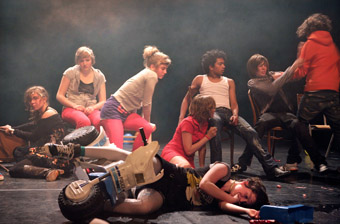
Once and for all we’re gonna tell you who we are so shut up and listen
photo Phile Deprez
Once and for all we’re gonna tell you who we are so shut up and listen
A SIGNATURE’S A FUNNY THING: A SIGN THAT CREATES ITS OWN CREATOR. A UNIQUE MARK THAT PRODUCES THE UNIQUE IDENTITY OF ITS MAKER. I HAVE AN AWFUL SIGNATURE WHICH HAS OCCASIONED LAUGHTER OR SUSPICION FROM COUNTLESS SHOP ASSISTANTS AND OFFICIALS. IT’S AS IF MY OWN SELFHOOD IS DESTABILISED BY THE ERRATIC NATURE OF MY JOHN HANCOCK. BUT WHAT ABOUT THE SIGNATURES OF ARTISTS OVER TIME? A DISTINCTIVE STYLE IS A SALEABLE COMMODITY IN THE VISUAL ARTS, ITS COUNTERFEITING SOMETIMES AMOUNTING TO A CRIMINAL ACT. IN THE PERFORMING ARTS IT’S EVEN MORE COMPLEX.
These thoughts were buzzing around my mind while watching Strangeland, the recent collaboration between Melbourne’s Not Yet It’s Difficult and Korea’s Wuturi. It began as murky light began to filter through the thickest haze effect I’ve ever seen on a stage. Indistinct figures seemed to coalesce and disperse somewhere in the autumnally tinted fog. Their skin was dirty, dusty, perhaps ash-covered. The apparitions seemed revenants haunting us from some unimaginable other-space.
Then I saw the walls. Padded panels a little larger than a door. And I thought, “I wonder when the performers will begin throwing themselves against ‘em?” See, these same panels featured in at least two previous NYID works, and the act of slamming into them has become a kind of signature move for the company. But what does that mean?
On one hand, it could be read as an impoverished recycling of earlier ideas. On the other, it could be a gesture of continuity, tracing a thread that acknowledges the genealogy of artistic production. If you’ve a third hand free, you could also see it as a specifically visceral act of communication, whose violence is more immediate than any of these more linguistic notions can encapsulate.
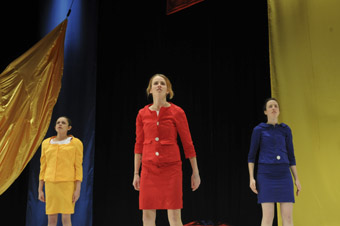
Post, Shamelessly Glitzy Work
photo Heidrun Löhr
Post, Shamelessly Glitzy Work
A contrasting example. The much lauded trio Post’s Shamelessly Glitzy Work bears distinct connections to their previous body of work. An ironic spectacular featuring ditzy dialogue, alcopop-guzzling, bad dancing, bold colours and an existential emptiness, it’s live art that doesn’t specifically quote but certainly echoes the company’s existing oeuvre. Moreover, these signatures don’t just produce the creative identity that is “Post” but also align the company with others working in a similar vein, such as The Fondue Set and My Darling Patricia. These repetitions create that larger identity often called, for want of a better term, a scene.
Forced Entertainment’s Spectacular played in the same space as Shamelessly Glitzy Work, and its empty hour of anti-theatre, in which a performer apologises at length for the lack of a show, was certainly reminiscent of the company’s extensive body of work. Marie-Anne Mancio, in RealTime 89 [page 34] wrote that “the absent show in Spectacular is also the ghost of shows past…Despite the humour, it’s relentless. Not even painful. Just boring.”
It was pretty boring. The ideas Spectacular raises have been explored to more thought-provoking effect by this same company before. It’s not just the repetition that’s the problem, though. Forced Entertainment have their signature, and it’s one that has deservedly influenced many who have come afterwards. It’s that, in this case, the signature is all that there is. It’s like an autograph on a blank page, whose only value is in the confirmation of an identity, not its creation.
Another perspective. Umberto Eco has written of the process of ostention, of communication in which a mimed action takes the place of words—placing a finger to your lips (shhh), waving a packet of cigarettes (want one?). Ostention isn’t just a fancy form of theatre’s ‘show, don’t tell’ dictum (itself rather dodgy). In ostentive gestures, an action becomes a sign of a sign. Post dramatic theatre often requires an implicit recognition of this slippery form of signification—Spectacular, for instance, is at a surface level all tell and no show, but this itself is what constitutes the work’s expressed meaning.
But as I’ve said, I found it pretty boring. The absent show has itself become a presence in contemporary theatre, and has been invoked to greater effect by others (and by Forced Entertainment, for that matter). Shamelessly Glitzy Work, meanwhile, pokes at the dead remains of dramatic performance with a very big stick that is itself hugely entertaining. Spectacular features interminable death scenes and drawn-out monologues on nothingness; Post play with similar durational concepts through a long, numbing techno dance sequence, and toy with the vacuity of theatre by producing hilarious magic or special effects that express, well, nothing much.
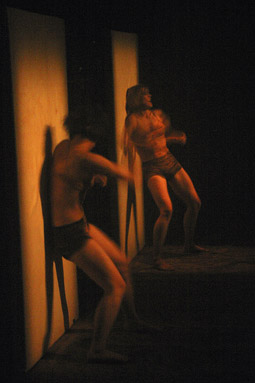
Strangeland, NYID
photo Guiman Shin
Strangeland, NYID
Back to Strangeland. All show and no tell. Movements as signs which seem only to refer to other movements as signs, an infinite regress. Its roots are in dance, yes, and so elements of that vocabulary can be expected to feature, just as Spectacular’s mostly verbal nature appeals to a shared oral vocabulary. But Strangeland, sadly, replaces ‘heard it all before’ with ‘seen it all before.’ Beyond the familiar wall impacts, the choreography of the piece often focused on the kind of shuffling, jerky, unconscious motion that has featured prominently in Melbourne dance for more than a decade, and which has taken on a certain historic air. The interaction between dancers appeared to be based on tiny, improvised movements which occurred whenever another performer was heard to move somewhere nearby. This conjured an interesting sensation of watching the impenetrable communication between ants or other complex social organisms, but is again overly familiar in an age where Merce Cunningham or Deborah Hay have made such processes a common mode of practice.
Post take the familiar and invest it with a surprising currency. In common with Forced Entertainment and NYID, the company holds up to scrutiny the things in which we can no longer place a naïve faith, the world and its forms of representation which have failed us. But rather than the post-apocalyptic void of Strangeland or the ‘sorry about that’ shrug of Spectacular, Shamelessly Glitzy Work makes the shared experience of art a thing of joy in itself. It recovers dead or discredited modes of entertainment with a kind of winking knowingness that is terribly generous to its audience. It knows that we know it all, so it doesn’t need to tell us anything. We get the signs and we get their eternally self-referential status and by gosh, let’s blow up a massive patchwork balloon while we’re thinking about that.
All three works were presented by Arts House over several weeks in a program with new work by locals Panther and The Suitcase Royale. The sixth in the series deserves special mention: Belgian company Ontroerend Goed’s quite incredible Once and for all we’re gonna tell you who we are so shut up and listen. Thirteen teens played out a short chaotic scene structured around simultaneous activities of teendom—teasing scuffles, moody exchanges, boredom, solitude, experimentation. This scene was then repeated with fascinating variations: in an affectionate, euphoric manner; drugged up and stumbling; even, at one point, entirely absent from the stage as their props continue to repeat the scene despite their disappearance.
This work could easily have been a condescending glance backward, either treating teenagers as exotic specimens from another world or using them to remind us of a nostalgic youth we all apparently shared. Instead, it allows its performers to exist on their own terms, as individuals, as a group, as able performers and as fallible humans. They do not become signs of a generation, nor of an abstract principle. The work is carefully constructed, allowing for gloriously open play within its confines, and the energy transfer between audience and stage is of an infectious vivacity that few productions even think to aspire to, let alone achieve.
Not Yet It’s Difficult/Wuturi, Strangeland, director David Pledger, performers Todd MacDonald, Ingrid Weisfelt, Vincent Crowley, Sara Black, Seo Sang Won, Song In Sung, Sang-A Kong, lighting Paul Jackson, Niklas Panjanti, Arts House, Meat Market. Aug 5-8; Post, Shamelessly Glitzy Work, created and performed by Mish Grigor, Natalie Rose, Zoe Coombs Marr, North Melbourne Town Hall, Aug 13-15; Forced Entertainment, Spectacular, director Tim Etchells, performers Claire Marshall, Robin Arthur, North Melbourne Town Hall Aug 6-8; Ontroerend Goed, Once and for all we’re gonna tell you who we are so shut up and listen, writers Joeri Smet, Alexander Devriendt, director Alexander Devriendt, Meat Market, Melbourne, Aug 6 – 11
RealTime issue #93 Oct-Nov 2009 pg. 40
© John Bailey; for permission to reproduce apply to realtime@realtimearts.net
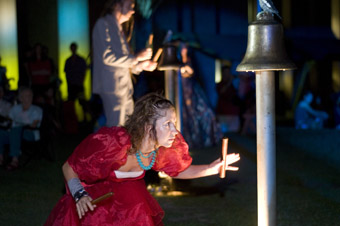
Lulu Madill, Origins
photo Kara Burns
Lulu Madill, Origins
IT IS PERHAPS FITTING THAT DARWIN, THE CAPITAL OF THE NORTHERN TERRITORY IS NAMED AFTER THE SCIENTIST WHO DEVELOPED THE THEORY OF HUMAN EVOLUTION. THE NOTION OF ‘SURVIVAL OF THE FITTEST’ AND THE RUGGED OUTBACK ‘TERRITORY TOUGH’ MYTHOLOGY SIT TOGETHER AS NEATLY AS A GALAPAGOS SEABIRD AND A CRAGGY ROCK.
But what Charles Darwin, naturalist, explorer and author of On the Origin of Species would make of two ‘tween’ boys dressed as spermatozoa whizzing through a park on unicycles to mark his 200th birthday remains as much a matter for conjecture as the thoughts of early Top End settlers whose distinctive elevated houses have been flattened to make way for multi-storey apartment blocks in a building boom that has done more to shape Darwin’s urban environment than any event since Cyclone Tracey.
But let’s set “industrial melanism” (Darwin’s concept relating to phenomena arising from man-made environmental change) aside for now. Despite the encroaching high rise and cranking air-con units, Darwin City’s Civic Park on a balmy Dry Season night remains an ideal location for an event like Origins, a cross-disciplinary collaboration to mark the 200th birthday of Darwin and the publication of his revolutionary thesis. He never visited the Northern Territory. Darwin city was named after him by friends on HMAS Beagle which visited Darwin Harbour in 1839.
Origins was a one-off event that brought together some of Darwin’s key creative organisations: Corrugated Iron Youth Arts, Darwin Symphony Orchestra, Darwin Chorale, Darwin Theatre Company, 24HR Art and Charles Darwin University. It embraced multimedia, symphonic music, performance and installation art, involved myriad young performers, artists and seasoned orchestral musicians and was woven around some of Darwin’s most revolutionary theories. Allopatric speciation anyone? How about adaptive radiation or biogenesis?
So that explains the cycling sperm…and those uplit dresses hanging in the trees. Beguiling monuments to progression or regression, civilisation or barbarity? Beauty is in the eye of the beholder.
Origins also marked two firsts: the premiere of a new orchestral work, Transmutations, by English composer Michael Stimpson, and the unveiling of a public sculpture, Ships Bells, by Victorian artist Anton Hasell. Transmutations was commissioned by the Darwin Symphony Orchestra (DSO) as the fourth part of The Age of Wonders, a series inspired by the life of Charles Darwin. It is a sublime work, imbued with a sense of restless movement and desire for knowledge and adventure. There are clopping horses and bird calls, billowed sails and ships at sea, and the DSO’s interpretation was balanced and polished. For an officially ‘pro-am’ orchestra, the DSO punches well above its weight. Outgoing artistic director Martin Jarvis—who has steered the orchestra for over 20 years— leaves an extraordinary legacy and big shoes to fill.
The rest of the evening was a hotchpotch and, running concurrently with the orchestral performance, proved somewhat of a distraction. There were youth performers and acrobats, multimedia projections, magicians, actors reading from Darwin’s diaries and parading as human species, in all their suburban slobbery, locked up in zoo-like cages.
Each element of Origins, in its own right, was good enough, but overall, the event didn’t really hang together. There was no sense of cohesion, nor of carnival. The feel was more of a community fete than interactive performance event, and it wasn’t helped by huge ‘holes’ in the sound and lighting design. Origins was a great concept, but the execution did not do it justice.
This was Darwin city’s offering to its namesake, a man who was revolutionary, brilliant and brave. As much as Origins showcased all that is good about Darwin and its arts community it also highlighted all that is lacking, in particular the dearth of professional performers and directors in what was once a vibrant theatrical scene. Perhaps the reinvention of Brown’s Mart, under the auspices of Performing Lines, as Darwin’s central theatrical ‘hub’, and the increasingly pro-active role of Darwin Festival’s producers in nurturing local work will redress this situation. Let’s hope so—those Dry Season evenings are too good to waste.
Origins, creative director Alex Ben Mayor, new media artist Tim Parish, visual art facilitator Tim Newth; Civic Park, Darwin, July 1
RealTime issue #93 Oct-Nov 2009 pg. 41
© Jane Hampson; for permission to reproduce apply to realtime@realtimearts.net
{$slideshow} AFTER SUCCESFUL PERFORMANCES OF FOOD COURT FOR THE SYDNEY OPERA HOUSE LUMINOUS SEASON AND RECEIVING A KIT DENTON FELLOWSHIP—FOR COURAGEOUS WRITING—FOR A WORK IN DEVELOPMENT, GANESH VS THE THIRD REICH, GEELONG-BASED BACK TO BACK THEATRE HAVE FURTHERED THEIR VENTURES IN INNOVATIVE PERFORMANCE WITH TOUR GUIDE. THE NEW OUTDOOR WORK HAS BEEN CREATED IN COLLABORATION WITH AUSTRIAN GROUPS MALARIA, SOUNDSO THEATER AND SCHRÄGE VÄGEL AND PERFORMED AS PART OF LINZ’S THEATERLUST.
The performance took place in a public park, with neither sets, nor lighting nor costumes. Tour Guide explores body language as much as the content of its German and English scripts. The audience was reminded that in such public places, while unable to hear the words of others, we may be able to observe the emotions in private conversations, sense the aggression of one person standing over another, decipher the pursed lips of disappointment, or empathise with the embarrassed fidgeting of rejection.
The audience here was wired more deeply into such intense personal drama via headphones, a technique used by Back to Back in their internationally popular Small Metal Objects. The audio guide took us on a voyeuristic journey into a series of intimate moments, many of which were painfully or comically awkward. The script is based on four short stories, expanding in scope from the personal to the societal; firstly an intimate dialogue about sex, then friends giving advice on infidelity in marriage, next a community intervention into a drug deal, and finally a layered narrative on representations of disability in the media.
A little girl searching the park for her lost guinea pig interweaves the four stories. Her role is also to usher the audience to the action as the direction from which the dialogues come is not always obvious. Used more explicitly, this technique would be sufficient but, for many of us, it takes a little while to sink in, by which time, some of the performance has already passed. But by the second act, we are in the swing of it. From inside a car, a man explains to his friend that his wife wants a divorce. His friend advises that, like a plant, a marriage has to be tended. He takes this to his wife, but in his nervousness, misquotes, “I want to love you, like a plant.”
The next scene introduces a more criminal scandal. The little girl approaches a man in a wheelchair and asks, “Have you seen my guinea pig?” The man turns out to be dealing drugs and tricks the little girl into becoming his mule. Discovering the incident, the girl’s sister rallies the park community to set things straight. This is a magical scene. As we see them unite to gang up on the bully, we realise that we have mistaken most of the actors, scattered on park benches for bystanders. Whether we have seen them as people with disabilities or simply as separate individuals going about their daily lives, they now demand to be recognised as performers. Even a dog, also part of the large cast, joins in barking excitedly, and the drug dealer wheels off.
In the last act, we watch several takes of filming a scene in a movie in which a young man with Down’s syndrome has arranged a blind date with a woman by sending a photo of someone else: “a 35 year old man with blond wavy hair who likes going to the theatre, fine dining and walking in the Alps.” When she becomes angry, he then claims to be Michael Jackson. “Michael Jackson is dead”, she cries. He is persistent. “Okay, yes, I’ll be honest. I am James Bond. You have beautiful hands and a beautiful body. You are my Bond girl. Please be my girlfriend.” And somehow, we have been guided back to the beginning of the tour, a desperate man pleading to be loved.
Like Back to Back’s home town of Geelong, the city of Linz is no stranger to the challenge of generating significant work outside the usual cultural epicentres—neither city has more than 200,000 inhabitants. Tour Guide has moments of awkward intercultural collaboration; the Australian and Austrian performers don’t always seem to be on the same page and some English dialogue is simultaneously translated as it is performed. But it shows that local stories can resonate on an international level.
The lost guinea pig is never found, but in meeting so many people, I have almost forgotten that anyway. I am just happy to be part of the guinea pig audience for this project, which will be continued in 2010 and undoubtedly join the list of Back to Back’s success stories.
Back to Back Theatre with Malaria, SOundSO Theater & Schräge Vägel, Tour Guide, Theatrelust, Linz, Austria, Aug 10-11
RealTime issue #93 Oct-Nov 2009 pg. 42
© Alexandra Crosby; for permission to reproduce apply to realtime@realtimearts.net
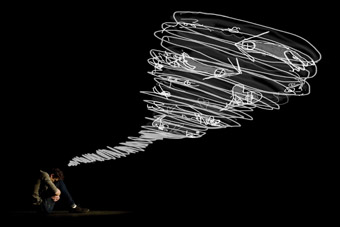
Matthew Whitty in The Fire and Hurricane Survival Guide
image by Thomas Breakwell and Robert Jordan
Matthew Whitty in The Fire and Hurricane Survival Guide
IN MELBOURNE SOME THEATREMAKERS ARE ENAMOURED WITH THE GENERIC RESIDUE OF SURREALISM. RECENT PRODUCTIONS OF WORKS BY ARTAUD (A SURREALIST OUTCAST) AND ARRABAL (A 1970’S ABSURDIST), ALONG WITH JENNY KEMP’S INFLUENCE AT THE VCA AND WRITER LALLY KATZ’S UNCANNY ABILITY TO BE EVERYWHERE SIMULTANEOUSLY, HAVE ENCOURAGED A DESIRE TO EXPRESS THE INDESCRIBABLE LONGINGS OF THE UNCONSCIOUS MIND.
However, this apparent Surrealist impulse is less a desire to reveal interior worlds than a symptom of a contemporary conundrum that confronts artists and audiences alike—a postmodern inability to remember and therefore to concentrate upon immediate problems such as economic crisis and climate change. What we are actually seeing in Melbourne is not Surrealism, but an evasive hyperrealism.
Dream Creatures and The Fire and Hurricane Survival Guide are two performances from Bird on Fence at St Martins Youth Arts Centre that provide contrasting examples of the surrealist impulse. Dream Creatures opens with its central character in bed wearing pyjamas. The creatures that surround the perplexed Ashley—a magician, a bird-man, an elf, an ‘Alice’ impersonator and a feline troll confined to a cage—are all characters that visit him during his nightly REM sleep. Ashley himself is an androgynous mix of ambiguous sexual inclination, completing the overarching impression that any sense of an actual world has been excluded.
In effect, we are watching Ashley’s dream; which could also be a dream within a dream belonging to another character, or even another member of the audience. Noteworthy here is the fact that Dream Creatures relies upon conventional theatrical dialogue and character delineation to express the unconventional world of the lower cerebral cortex, while the second play, The Fire and Hurricane Survival Guide, utilises the power of non-verbal communication.
Two young men stand opposite each other at either end of the stage. Each immerses his head in a bucket of water, but at different times. When a city skyline appears on a rear wall it becomes clear that these two guys, desperate to emotionally connect, are instead overwhelmed by the pressures of urban life. Unlike the previous play, never a word is spoken between the two men; but, of course, much is said about social isolation, teenage gender bending and simple expressions of love lost to prejudice and feelings of acute helplessness.
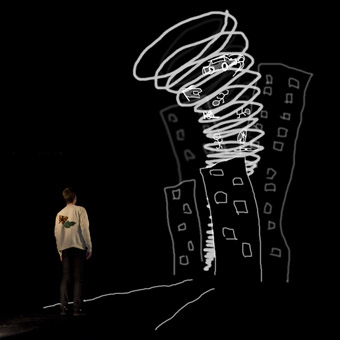
Luke Fraser in The Fire and Hurricane Survival Guide
image by Thomas Breakwell and Robert Jordan
Luke Fraser in The Fire and Hurricane Survival Guide
That Surrealist grand master Marcel Duchamp, an artist notorious for turning his nose up at the urinal of genre classification, also emphasised the communicative power of inanimate objects. In this sense, The Fire and Hurricane Survival Guide comes closest to transposing a precise surrealist impulse into the morass of postmodern life. Watching this impulse attempt to find traction in the year 2009 is one of the strangest experiences a reviewer can have in his theatre reviewing life. Perhaps though, this same sense of temporal-spatial displacement is once again, a necessary condition of the hyperreal.
Bird on Fence: Dream Creatures, and The Fire and Hurricane Survival Guide, Writer-Directors: Alisa Tanaka-King & Brienna Macnish, Performers: Ally Bruce, Amy Jones, Emma Lyhne, Brenna Macnish, Michael Timothy Mission, David Peake, Joana Pires, Stephanie Sabatino, Mattie Young, Luke Fraser & Mathew Whitty, Light: Katherine Hall & Maddy Seach, Sound: Daniel O’ Shea & Danielle Anderson, Music: Glenn Luck & Caterina Pacitti, Sand Art: Amy Jones, Animation: Robert Jordan, August 5 – 8, St Martins Youth Arts Centre, Melb
RealTime issue #93 Oct-Nov 2009 pg. 42
© Tony Reck; for permission to reproduce apply to realtime@realtimearts.net
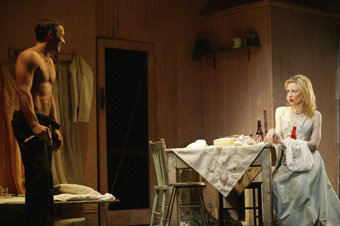
Joel Edgerton, Cate Blanchett, A Streetcar Named Desire, Sydney Theatre Company
photo Lisa Tomasetti
Joel Edgerton, Cate Blanchett, A Streetcar Named Desire, Sydney Theatre Company
a streetcar named desire
It was with some apprehension that I went to see the Sydney Theatre Company’s A Streetcar Named Desire. First, would Cate Blanchett be too young and temperamentally too strong to realise Blanche DuBois’ fading beauty and emotional fragility? Secondly, did an actor as able and inventive as Blanchett need an exotic import like Liv Ullmann as her director? Or was the choice simply a signal of psychological seriousness and world’s best practice? Thirdly, the word was out that the production was going to be conventionally staged. What could we possibly learn from that?
I’d watched the opening scenes of Charlie Kaufman’s film Synecdoche, New York with amusement as a director (Philip Seymour Hoffman) daftly cast Arthur Miller’s The Death of a Salesman with a young Willie and Linda in an otherwise straightforward staging. I’d read Daniel Mendelsohn’s caustic account of Natasha Richardson’s 2005 performance as Blanche in New York with “the sexless glow of an Amazon, or given her coloring, perhaps a Valkyrie” (“Victims on Broadway II”, How Beautiful It Is and How Easily It Can Be Broken, Harper Perennial, 2009). In trying to up the gender wars ante in the Blanche-Stanley conflict Richardson and her director, Mendelsohn complains, had reduced the woman’s vulnerability and altogether eliminated the potential for sexual frisson between the protagonists—a key element of the play for him and so evident in the Elia Kazan film with Vivienne Leigh and Marlon Brando.
At one level, I needn’t have worried about Blanchett. Once again, her capacity for transformation was evident in the overall conception of the role and in myriad details. Her Blanche is driven by a nervous energy that is always on the edge of exhaustion: a quivering alertness alternating with distracted inwardness. Bursts of posturing, over-confident lying and angry self-defense increasingly weary her until, fractured, confession and withdrawal ensue. This stripping away of the Southern belle facade is amplified by the ‘undressing’ of Blanche. Ullmann and Blanchett rightly make much of Blanche’s relationship with her clothes, in the end leaving her with even less dignity than we might expect—exiting abject in petticoat and bare feet. Another image, seen twice, that disturbingly complements this descent has Blanche, still and silent, squatting on the floor with a piece of cloth draped over her head, cutting out a world she can no longer handle. Perhaps it’s this imagery that Liv Ullmann, with her experience of the film world of Ingmar Bergman, brings to Blanchett’s interpretation of Blanche—a complete psychological demolition of the woman and concomitant physical weakening.
Joel Edgerton’s Stanley in the opening performance didn’t seem interpretively distinctive but looked right and by the second half the rolling momentum of his psychological and physical assault on Blanche, and its roots in her overheard reference to him as an ape, is fully felt. As for any sexual play between this Blanche and Stanley, I didn’t detect it, and the rape was a rape. This might not satisfy Daniel Mendelsohn should he see the production when it bravely tours to New York. Blanche and Stanley here are simply antagonists, the complexity of the production residing in the woman’s condition. Certainly there’s no concealing the danger that Stanley embodies—a capacity for blind physical violence, against men as well as women—and a community that hypocritically abides it and for which Blanche is sacrificial victim.
Blanchett’s performance is admirable, above all, for conveying a palpable sense of Blanche’s suffering and her limited self-awareness, but I was left wondering what could have been revealed by a more inquiring director. Ullman’s production looks like one that could have originated on Broadway at any time since the play’s premiere. On the positive side there’s the fidelity to Tennessee Williams’ very particular sense of light and sound in Nick Schlieper’s lighting, sharply contrasting the moonlight and dark in which Blanche hides with, for example, sunlight blazing through a window, while Paul Charlier and Alan John do film score justice to the writer’s desire for a sound world which includes music largely heard only by Blanche, and ourselves. The kind of ‘magical realism’ that Williams was aiming to achieve is, then, partly realised if not forthcoming elsewhere.
The set design emphasises the limits of the production. Ralph Myers (whose wonderfully expressive designs for Benedict Andrews and Barrie Kosky sometimes evince an architectural sensibility, as in the thrusting rooms in Act 2 of Lost Echo) places atop of Stanley and Stella’s humble 1940s apartment a giant, oppressive block of 50s modernist construction that fills the upward balance of the stage, as if perhaps to highlight a world that has moved coolly on from these downstairs melodramatics. However, the apartment setting itself looks not simply like a poor American home but a standard American stage set. As well, there’s an uncomfortable feeling of facing a pronounced fourth wall, of peering into rather than sharing a world (amplified if you’re some distance from the stage) where the actors, for the most part, play to each other across the stage in a self-contained world. This is at a time when stage acting is in a fascinating period of transformation with much gestural and spatial play and a return to, or radicalising, of older conventions of performance in more direct relation to the audience.
If grateful to have witnessed Blanchett’s performance, not least in the final stages of Blanche’s decline, the residue of feeling about the production was of over-familarity, of museum mustiness that blunted the threat that A Streetcar Named Desire can still doubtless deliver. We are quietly reminded of this not in the passages of high passion but when Blanche is tempted to seduce the boy collecting newspaper money or the silent moments when she covers her head.
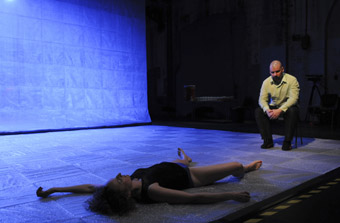
Kim Vercoe, David Williams, This Kind of Ruckus, version 1.0
photo Heidrun Löhr
Kim Vercoe, David Williams, This Kind of Ruckus, version 1.0
this kind of ruckus
It’s a quick trip across town, from Tennesee William’s 1947 at Sydney Theatre to version 1.0’s 2009 at CarriageWorks, but not a lot has changed—the violence perpetrated by men against women is still the issue, but the way of playing it is light years away. Version 1.0’s mixed media and performance modes have cast a widely admired ironic and revealing light on contemporary politics, but in This Kind of Ruckus the company inhabit a reverie confabulated from their own raw materials instead of their customary drawing on government reports, Hansard and the media.
The outcome is a large scale looping reverie of motifs, strange tales, fragmented encounters, unlikely cause and effect, missing links and a dense layering of metaphors. There’s little that’s literal. The outcome is a work of peculiar beauty, like a half-remembered dream, part-nightmare, replete with oddly aestheticised violence and not a little humour. “It was funny, in an ugly kind of way”, I heard someone say.
This Kind of Ruckus is like a Freudian dream theatre: images repeat, split, multiply, condense, mirror themselves; figures appear in new guises; narratives fragment, skip beats; episodes re-play with new variations, some obvious, some distant. Suspended screens appear to duplicate the live action below, but are as likely to contradict stage conflict with images of fond intimacies. The screens reveal memories of distress and trauma but also images of wish fulfilment.
The performing space itself transforms, multiplying meanings. Initially a huge curtain, lit red, looms over the audience with the cast lining up as cheer leaders, locked into position, ready for the “1, 2, 3…” Instead they abruptly sit and chat, one vigorously telling a story of two women on a Saturday night drive witnessing city street violence and fantasising vigilante action on behalf of endangered females—until they’re disabused by a sinister policeman. The storyteller is joined by another of the cheerleaders and together they ogle the men in the audience, making lewd offers. Actually, they’re mimicking male behaviour; a dismissive male cheerleader states the obvious: “You haven’t got the balls.” The curtain is gone, revealing a wall and floor of quilted bubble wrap, suggestive of a padded cell or, a dance club, a therapeutic space. Above is the screen, to either side, tables with rows of alcoholic drinks which the performers consume regularly with an escalating sense of bingeing, especially by the women.
The opening scene is indicative of the metaphorical layering and shifting which are the show’s modus operandi: the image of an unspecified sporting function mutates into a storytelling bout, into some calculately confusing gender role shifts, and then morphs into a “this is theatre” mode and offers an ambiguous performing space in which a seated man stares at a woman sprawled on the floor, possibly unconscious, perhaps lifeless. A victim of violence?
Before the curtain closes when the cheerleaders return for their oranges at half time, the audience has had printed into its consciousness a series of images and episodes. Central to these is the man watching the woman on the floor. We’ll see the same couple in conflict but intimate on the screen, and then undergoing counselling in this padded room. The counseller negotiates the man’s approach to the woman, constraining him according to the woman’s response (“He was pretending not to walk but he is walking. It’s a bit creepy.” “He feels tall, toweringly tall.”) She’s wounded, volatile. He’s accommodating, but has nowhere to go. Our empathies swing; we’re deprived of context.
In a parallel scene in the second half, when wall and floor have disappeared to make way for a large space down which the performers can hurtle as if in a race (sport again?), a man approaches a woman. An escalating, grating score suggests the location as a dance club. He draws very close, moves about her, touches her cheek, her arm. She does nothing. He touches her breast. She waits then briskly walks away. He shivers, rejected; he shakes with body-consuming fury. Elsewhere in the performance, the same figure has quietly repeated a few questions to a woman that suggest the controlling personality that underlies jealousy. We make the link. Later images are more overtly suggestive of violence: blood smeared across faces and torsos, male and female. The man who stared at the floored woman, now sits bloodied, naked to the waist, at the same angle, but now in the distance. We guess at the cause, the event has gone missing. Her blood or his? We guess, we weave.
In This Kind of Ruckus version 1.0 has studiously avoided making documentary theatre, instead conjuring suggestive images of the triggers for and aftermaths of male violence against women. Some of these are blunt and a few surprisingly literal (a court scene in which a victim’s humilation is intensified by a female defense council). Most are more complex, ambiguous even. Likewise, the framework for the show appears to be rooted in sport, but it’s cheerleaders we see, not players, in an unglamorous rendering of a mere fragment of the spectacle.
Once sport was thought of as a means for sublimating sexual desire but we see it now as locus for sex, violence and corruption. This Kind of Ruckus might have been ‘inspired’ by a spate of sports-related sexual violence but it’s not an investigation of that phenomenon—which has included the desire of team members to witness each other having sex with the same woman in the same room at the same time. This show essentially operates at a more atomistic level—the couple. The second half, for example, opens with the story of a woman terrified into having sex with her partner after she’s told him the relationship is over. The following morning they have breakfast as if nothing has happened and she never sees him again. The other members of the cheer squad quietly imply she triggered his threatened violence, as does the defense lawyer later on.
Other than sport, it’s dancing—noisy, ruckus-y, lewd, limp and falling-down—and alcohol consumption that provide a mutating framework for the show’s sexual violence, not as causes per se but amplificatory, suggestive of an inescapable loop of the forces at work in the nightmarish arena that version 1.0 has created. With its distorting single figures, blurred couple action (sometimes glimpsed through bubble wrap), spare scenography and projected video diptyches, This Kind of Ruckus recalls the febrile visions of Francis Bacon.
The company, with guest Arky Michael, performs with great no-frills conviction and ever intensifying ensemble strength while Gail Priest’s dense, pulsing score (breaking glass and riot melded with dance beats) and Sean Bacon’s haunting live and pre-recorded projections provide motifs that not only heighten the show’s dream sense but anchor its wilder flights.
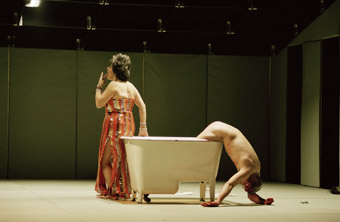
Barbara Spitz, Florian Carove, Poppea
image courtesy Sydney Opera House
Barbara Spitz, Florian Carove, Poppea
barrie kosky’s poppea
If you love Monteverdi’s The Coronation of Poppea (1642) you have to put much of it out of mind to enjoy Barrie Kosky’s re-working of the opera as vigorously entertaining, comic to the point of silly, sometimes aptly repulsive music theatre. All opera is music theatre but not all music theatre is opera. ‘Theatre’ is writ large in this production. It’s not that the music is secondary in any way, but rather that its realisation is infinitely more theatrical than even the most progressive of 21st century opera productions (even New York’s Metropolitan Opera, in search of new audiences, has mounted a new Tosca set in an industrial warehouse and replete with blow job for Scarpia). This Poppea has been created for and is rooted in the theatrical capacities of performers Kosky worked with in Vienna and even where they are stretched by the music (Cole Porter no less a challenge than Monteverdi) they bring it into their own range, entirely in character. Beatrice Frey as a tall, Shelly Duvall-ish Octavia ascends in falsetto to the top note, reaching it with a cracked screech—funny, without any sense of parody and apt for the empress’ frustrations.
Elsewhere Kosky redistributes musical passages to pointed psychological effect. Seneca (Florian Carove), the playwright-philosopher adviser to Nero (Kyrre Kvam), is played as mute, his tongue having been torn out as prelude to a forced sucide. Nero, hovering over a bloodied Seneca awash with blood in a bath tub, sings his erstwhile tutor’s lines as if knowing precisely what he would argue. It lends Nero a sharper intelligence, intensifying the sense of danger he embodies along with the ambivalent feelings as he embraces and then bluntly tosses aside Seneca’s body. Fittingly, Kvam’s singing is the closest to operatic.
The physically sexual intensity of the production is evident early on when the erotic play between Nero and Poppea (Melita Jurisic) has the emperor behind his mistress, his hands tightening around her neck in an act of sexual strangulation, grimly counterpointing opera’s breath-based, orgasmic soaring. Later there’s cunnilingus (to “Anything Goes”), Nero briskly rapes Ottone (Martin Niedermair as Poppea’s former lover) and Poppea cuts Nero’s chest. The emperor’s court is joyously and dangerously decadent, making actual what was only suggested in the opera.
Ottone, quite unlike the furiously angry man in the Monteverdi, is played here as a love lorne, lugubrious intoner of Cole Porter songs while looking like a sailor refugee from Fassbinder’s Querelle de Brest. He plots with Nero’s wife, Octavia, to kill Poppea with the help of the latter’s servant, Drusilla (Ruth Brauer-Kvam)—now infatuated with Ottone. An exotic, Theda Bara-ish presence in the court, her vocals inflected with a husky Eastern-European twang, Jurisic’s Poppea is sensual, self-possessed and single minded in her ambition, but the physical centre of the production is Drusilla, a joyful dynamo whose dancerly speed and contortions recall Meow Meow at her most excessive. Amor (Barbara Spitz), the god of love, on the other hand is a languorous observer, a droll queen, not the cute devil-cupid of some 20th century productions.
The final duet, shared by both the opera and this music theatre confection—when the emperor has, remarkably, forgiven and banished the plotters—is as affecting as ever. Poppea’s dark mezzo underlines and entwines with Nero’s lilting tenor. Love has unexpectedly weathered the rampages of lust and perversion even in Kosky’s grimly hysterical 21st century rendering. Compared with The Lost Echo and The Women of Troy, Poppea is Kosky-lite and his idiom now more than familar if never less than fascinating—especially as realised by such formidable performers.
the rameau project
While Barrie Kosky preserves the essential narrative of Monteverdi’s opera, the principal characters and some of the music, Nigel Kellaway’s approach to classics of any kind is very different and, in Rameau, more demanding if you’re not familiar with the source material. He has high expectations of his audience. In a season of three free performances in one of the voluminous CarriageWorks tracks, The opera Project presented a new music theatre work after the 18th French composer with whom Kellaway feels a particular affinity.
The centre of this work was not a Rameau opera (these have recently found new favour in major productions in Europe) but Genet’s play The Maids supplemented by texts from other sources and a strand of petulant satire that had Kellaway on the phone to Cate Blanchett negotiating an unlikely collaboration. The text-based scenes were punctuated by pieces largely from Rameau cantatas scored by Kellaway for two violins, two cellos, double bass, piano and singer Annette Tesoriero, who doubled as the maids’ Madame, voice-off and elegantly fulfilled a range other functions. The small ensemble was particularly effective, neither emulating a period feel nor, thankfully, sounding like a 19th century chamber group. Tesoriero’s lucid singing made the Rameau a double pleasure. As for what the songs were about…none of the luxury of Opera House surtitles here.
Compared with previous opera Project productions Rameau was efficient, a meticulous, upgraded work-in-progress showing, no mean achievement given the late replacement of Regina Heilmann (called away on a family matter) by Nikki Heywood with script in hand. Over a number of productions, Kellaway and Heilmann have developed a mutual playing idiom, somewhat Brechtian, intoned, almost dancerly and most memorable in their take on George and Martha from Who’s Afraid of Virginia Woolf in The opera Project’s Another Night: Medea, 2003 (which drew in part on Clerambault’s cantata Medee, 1710). Passion in this manner of playing is palpable, but tautly framed, indeed operatic. Heywood broke the mold, countering the arch, strutting imperiousness of Kellaway’s maid with nuanced responses and a felt emotional collapse, at the same time avoiding conventional psychological realism. Kellaway’s maid departed like a strangled diva, deprived of her aria.
Rameau confirms Kellaway’s esoteric vision—musically scholarly, literary, in love with the cut and paste of building idiosyncratic works out of others’ classics. It’s a modus operandi he shares, broadly, with Kosky, and one which faces the inevitability of likewise becoming itself ‘classical.’
the duel
With the Elevator Repair Service’s seven-hour ‘reading’ of Gatz still resonating pleasurably in mind and body, a visit to the ThinIce/Sydney Theatre Company production of The Duel (from an episode in Dostoevsky’s novel, The Brothers Karamazov) proved to be a bonus. Tom Wright’s adapation dextrously interweaves direct storytelling with adept dramatisation played out in designer Claude Marcos’ wide, shallow box of a room emblematic of the closed circuit of social relations and codes that one man will rupture, if only for his own moral salvation. Like postmodern dancers, the actors stand about, observing and then suddenly slipping in and out of storytelling or acting as required. Played very close to the audience, the performances are realised with an absorbing, intimate intensity by Luke Mullins, Renee McIntosh, David Lee Smith and Brian Lipson. Lutton’s directorial hand is assured. It would be good to see more of Perth’s ThinIce in this kind of welcome co-production in a period, at last, where more and more shows cross state borders as well as the boundaries of form.
the city
Benedict Andrews’ meticulously faithful account of Martin Crimp’s The City precisely captures the playwright’s ambiguous tone. Crimp appears to be the inheritor of the early Pinter idiom, not in his silences but in the signifiers that refuse be nailed down and the threats that come with their instability. Characters are constantly uncertain of the topic of conversation or their position within it and seek clarification—the apparent banter of social comedy quickly turning dark when characters can’t read intentions. Crimp calculatedly extends the resulting verbal ambiguities (about love, family, identity, war, vocation and storytelling) into physical reality when a small girl, the daughter of the principal characters, Clair and Chris, suddenly appears dressed identically to the nurse, Jenny, who is the family’s neighbour. At this stage, Clair, a translator and would-be novelist, suspects (as we do) that she might be inventing her own and her family’s reality.
Much more than a postmodern conceit, this scary bleed between worlds real and imagined runs through this short (80-minute) but remarkably dense work. The very notion of the city shifts about restlessly, one moment a cruelly adaptive market economy and uncomfortably cosmopolitan, the next a model of a writer’s inner world, elswhere the scene of war. The neighbour Jenny confides an account of a “secret” war (where her husband is a doctor): “the city has to be pulverised so that the boys—our boys—can safely go in and kill the people who are left—the people, I mean, still clinging to life.” Director and cast wisely eschew literally enacting the anxieties prompted by these uncertainties; the tone, not least in Belinda McClory’s finely idiosyncratic performance as Clair, is close to social comedy and all the more chilling for it. Characters are distracted, suprised and indifferent by turns, and like the verbal dancing, it’s hard to tell which way things are going, like Chris’ happy transformation from businessman to supermarket butcher.
Ralph Myers’ set almost looms over the audience, mirroring the seating rake in a series of giant carpeted steps (an abstracted city garden) requiring the performers to make their moves often with great effort, amplifying, if too awkwardly at times, the real challenges of meeting each other and negotiating already problematic communication.
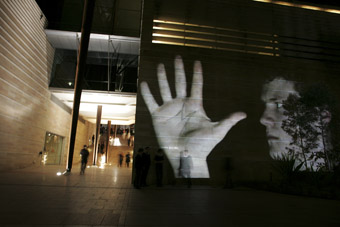
Lots in Space, UNSW/NIDA
photo courtesy NIDA
Lots in Space, UNSW/NIDA
nida: lots in space
Melbourne director Peter King has been NIDA’s inaugural artist-in-residence for six months this year, bringing together first year actors, students from NIDA’s open program, the McDonald College of Performing, UNSW Performing Arts and the UNSW Faculty of the Built Environment to collectively create Lots in Space. The outcome was an engrossing epic, true to the director’s architectural passions, flowing from the Parade Theatre foyer up the UNSW Mall, moving from installation to installation, and back to the theatre for a performance.
On the mall we glimpsed, through glass, figures in a halting abstracted Renaissance dance descending the Law Library stairs. Further on virtual water tumbled spectacularly down a raked square on which actors played out an excerpt from Thomas Middleton’s Women Beware Women (c1621). Around a corner a huge moon and scrolling text filled a vast facade below which performers danced, then led us back down the mall, completing a circuit of some 10 installations. In the theatre, images from the promenade recurred alongside further excerpts from Middleton’s play, Shakespeare’s The Tempest and Pericles and, hugely projected, Eistenstein’s Ivan the Terrible.
The almost ritualistic ebb and flow of large numbers of performers was dotted with microcosmic moments of intense drama of manipulation, oppression and sudden release. If at times a bewildering collage (a treasure house for keen quotation identifiers and cross-referencers), Lots in Space displayed organisation, collaboration and commitment of a high order. The young actors were impressive and the promenade installations revealed a confident engagement with powerful projection technology. Lots in Space was an apt celebration of UNSW’s 60 years and NIDA’s 50, when it needs to be looking to the demands of a diversified performance sector in the 21st century.
–
Sydney Theatre Company (STC), A Streetcar Named Desire, writer Tennessee Williams, director Liv Ullmann, performers Cate Blanchett, Michael Denkha, Joel Edgerton, Elaine Hudson, Gertraud Ingeborg, Morgan David Jones, Russell Kiefel, Jason Klarwein, Mandy McElhinney, Robin McLeavy, Tim Richards, Sara Zwangobani, musician Alan John, set designer Ralph Myers,?costumes Tess Schofield, lighting Nick Schlieper, sound designer Paul Charlier; Sydney Theatre, Sept 5-Oct 17;
version 1.0, This Kind of Ruckus, performer-devisors David Williams, Danielle Antaki, Arky Michael, Jane Phegan, Kym Vercoe, video artist Sean Bacon, sound artist Gail Priest, lighting Neil Simpson, devisor-dramaturgs Deborah Pollard, Yana Taylor, Christopher Ryan; Performance Space, Carriageworks, Sept 3-12;
The opera Project, The Rameau Project, writer, director, composer Nigel Kellaway, performers Nigel Kellaway, Nikki Heywood, Annette Tesoriero, dramaturg Bryoni Trezise, lighting Simon Wise; Performance Space, CarriageWorks, Aug 20-22;
The Duel, adapted by Tom Wright from Dostoevsky’s The Brothers Karamazov, director Matthew Lutton, performers Luke Mullins, Renee McIntosh, David Lee Smith and Brian Lipson, designer Claude Marcos, lighting Damien Cooper, sound design Kingsley Reeve; Wharf 2, STC, opened June 9;
The City, Martin Crimp, director Benedict Andrews, performers Georgia Bowrey, Anita Hegh, Belinda McClory, Colin Moody, Gigi Perry, set designer Ralph Myers, costumes Fiona Crombie,?lighting Nick Schlieper, composer Alan John; Wharf 2, STC, opened July 3;
NIDA and UNSW, Lots in Space, director Peter King, designers Matthew McCall, Kate Robert, Aron Dosiak, lighting Sarah Kenyon, Richard Whitehouse, UNSW Mall, Parade Theatre, Sydney, July 21
RealTime issue #93 Oct-Nov 2009 pg. 44-46
© Keith Gallasch; for permission to reproduce apply to realtime@realtimearts.net
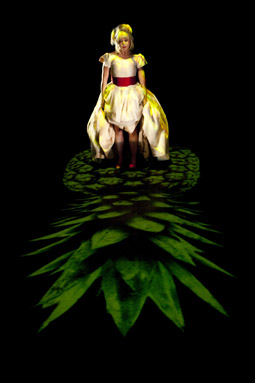
Lisa O’Neill, The Pineapple Queen
photo Sean Young
Lisa O’Neill, The Pineapple Queen
HOWEVER IDIOSYNCRATIC, LISA O’NEILL IS AN ICONIC QUEENSLAND DANCER, ACTOR AND NEW MEDIA ARTIST. WITH HER OWN DEEP SENSE OF IRONY, THE PINEAPPLE QUEEN MIGHT SEEM TO HAVE BEEN INTENDED TO SELF-REFLECT THIS CULT STATUS, AS INDEED IT DOES, BUT NOT IN A WAY PERHAPS MANY OF US EXPECTED.
the pineapple queen
This collaborative performance piece at the Roundhouse Theatre began as a more condensed, feral affair gleaned from a reworked script by writer Norman Price in 2004 as part of a series of Dada inspired performances around Brisbane. This piece and its developments, one says admiringly, exhibited O’Neill’s usual strengths. However, the La Boite showing added a new dimension of transparent vulnerability to O’Neill’s performance and repetoire. Strong dramaturgical input from director Ian Lawson elastically stretched definitions of both theatre and performance for La Boite who showed nerve in mounting this production.
The Pineapple Queen is presented through short scenes and minimal effects reminiscent of Buchner’s Woyzeck retold in a rural Queensland setting. The crucial elements in Buchner’s play—the dark pool (love and suicide) and the encroaching storm (Woyzeck’s madness)—are reproduced to similar effect in this production by the mysterious “coal hole” and the storm over the Glass House Mountains. However, as the Glass House District Pineapple Queen, it is O’Neill who is going mad, and her romantic self-confabulations and grand illusions are butresses against this end. As her defences crumble, the domestic brutality and squalor of the protagonist’s marriage are revealed in a final directorial coup which exposes O’Neill’s character as no longer capable of ‘acting.’ It is as if we are seeing Buchner’s Marie further down the track with her Sergeant, with all the nasty implications of history implacably repeating itself. In the final fadeout on the dethroned queen, cringing without any armour, it is as if we too have been effectively shut out from the text, along with her, denied a voice in history.
If the voice of history is patriarchal and monological, where are our vaginas? The central image of the hole in the Golden Circle Pineapple and the ellipses implied by the “coal hole” alert us to the gaps in consciousness, language and the body where real possibility for dialogue in this dark fairy tale exists. But Ian Lawson’s narrative uptake drives the play like a detective story, providing clues to the Queen’s madness, and this is indeed intriguing while ironically we are complicit from this monolithic vantage point in excluding her voice. But that a realistic explanation would ever be sufficient clue is moot given that the cause of her trauma is so shockingly and symbolically overdetermined in what is proposed in the final analysis—that she was forced as a child to assist her mother to self-abort with a baling hook, and that she herself repeats this familial cycle of violation. Her own comically depicted abortion of a pineapple after a vicious rape has an appropriately hallucinatory edge.
Despite such shocking imagery, this production sustained an uncanny poetic flow, all the elements contributing to maintaining a heightened feel that this woman is trying, above all, to survive and live. Price’s text this time is more spacious and allows the performance to move forward adeptly. Michael Coughlan, as the Pineapple Queen’s husband, delivers a superbly timed, immaculate performance of restrained emotion and potent physicality. The animations by Jaxcyn, projected onto the floor, such as the pineapple process plant at which The Pineapple Queen presumably worked in a menial position, or the expanding flower arrangement on which O’Neil danced, is simply the best integrated video design I’ve seen in a very long time. These were matched by David Walters’ subtle lighting and portentous music from Guy Webster.
There seem to be two versions of The Pineapple Queen. The earlier, more surreal version was easier to laugh at; the second is harder to watch, but equally rewarding in very different ways. In the first, The Pineapple Queen resorted to an axe to decentre authority or perhaps, more importantly, to perform a creative, purposeful act of self-authority. In this one, we see the performer Lisa O’Neill make a huge leap with the assistance of generous collaborators to lay herself open to dialogue with multiple voices.
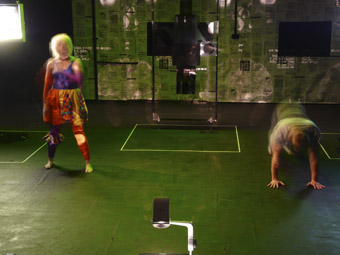
Genevieve Trace, Kieran Law, Transverse Fracture of the First Metacarpal
photo Yvette Turnbull
Genevieve Trace, Kieran Law, Transverse Fracture of the First Metacarpal
transverse fracture of the first metacarpal
Another work in the physical performance vein was Transverse Fracture of the First Metacarpal performed as part of the Independents 2009 season at the Sue Benner Theatre at Metro Arts. This often disarming but deceptively contrived piece dealt with personal encounters with physical injury and rehabilitation by the co-creators Kieran Law and Genevieve Trace. That this might be of major industrial concern for starting out artists was emphasised, coincidentally, by the fact that only relatively recently did mid-career artist Lisa O’Neill return to performance after significant time out due to injury. Curiously, the shows bear a resemblance.
Law and Trace warmly engage with the audience and each other, developing a neat patter between them and bearing lightly on their physical injuries. Trace is particularly funny as she clowns through the story of how she seriously hurt herself while in the original daffy costume she wore on stage as a teenage performer. Law plays a more bashful muggins when he describes the usual dumb things young men do that resulted in his own injuries, although, to be fair, Trace unrepentantly confesses to having her nose broken in a stupid fight with her sister.
There’s an underground tension that emerges darkly to counter this lightness. This transverse fracture in the proceedings is well managed by the performers as they disengage from the audience and each other, entering another world of their own. Thom Browning’s low key electronica inundates the space to create a moody uneasiness perfectly complemented by Whitney Eglington’s spare lighting design. Two medical light boxes suspended in the space illuminate the brain scans and x-rays of broken bones held up to them in classic gestures that recreate to strong effect the still moment of anguish and horror before a patient’s life or death sentence is pronounced. Law’s Suzuki-based and Trace’s circus style of repetitive choreographed movement performed with absolute focus likewise served to prolong this moment to an unnerving extent considering the real risk of injury in this context.
This was a sophisticated and interestingly constructed show—the moment of disconnect, the movement into abstraction, was similar to the act of severence performed by O’Neill in The Pineapple Queen wielding her axe, and for the same reasons. Law and Trace, by cutting ties to their own self-narratives, seemed to be staking claim to new and uncharted territory on a level basis with the audience. Given their obvious skills and commitment, it will be interesting to see how their future work develops with larger subject matter. As a footnote, I’d like to mention the salient influence I’ve been observing that OzFrank has been having on two generations now in Brisbane.
The Pineapple Queen, creators Norman Price, Lisa O’Neill, writer Norman Price, director, dramaturg Ian Lawson, performers Lisa O’Neill, Michael Coughlan, sound composer Guy Webster, lighting design David Walters, costume design Glen Brown, video design Jaxzyn; Roundhouse Theatre, Brisbane, July 28-Aug 8; Transverse Fracture of the First Metacarpal, co-devisors, performers Genevieve Trace, Kieran Law, sound design Thom Browning, lighting design Whitney Eglington; Sue Benner Theatre, Metro Arts, Brisbane, July 9-25
RealTime issue #93 Oct-Nov 2009 pg. 47
© Douglas Leonard; for permission to reproduce apply to realtime@realtimearts.net
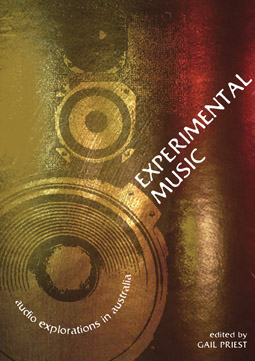 A NEW BOOK, EXPERIMENTAL MUSIC: AUDIO EXPLORATIONS IN AUSTRALIA, FROM UNSW PRESS, OPENS ‘SCENIC’ WINDOWS ONTO HIDDEN WORLDS OF AUDIO CULTURE AND CONTEMPORARY MUSIC-MAKING FOR THOSE WHO MAY HAVE BEEN CAUGHT IN ITS SPELL AND WONDERED WHERE IT ALL CAME FROM.
A NEW BOOK, EXPERIMENTAL MUSIC: AUDIO EXPLORATIONS IN AUSTRALIA, FROM UNSW PRESS, OPENS ‘SCENIC’ WINDOWS ONTO HIDDEN WORLDS OF AUDIO CULTURE AND CONTEMPORARY MUSIC-MAKING FOR THOSE WHO MAY HAVE BEEN CAUGHT IN ITS SPELL AND WONDERED WHERE IT ALL CAME FROM.
My first conscious meetings with experimental music were through a high school music camp tutor and through the older brother of a school friend. The tutor introduced me to the post-war classical experiments of total serialism, graphic scores and chance processes; the friend’s brother to the world of Severed Heads and other Australian and international manifestations of the experimental electronica that emerged in the wake of Punk. These two broad strands of activity are the primary antecedents that the editor of Experimental Music, Gail Priest, identifies for today’s Australian experimental music culture.
It’s been a long wait for a book-length attempt to document and interpret these developments in Australia and I approached Experimental Music with both excitement and anxiety. I was excited because at last an important part of the music scene of my own era and place was being represented in book form, but anxious that the book would not be up to the task—that I would find myself taking issue with the writers on everything from the book’s title to its many claims and omissions.
In attempting to meet this challenge, Gail Priest and her publishers have provided an introduction and framework for what amounts to a series of essay memoirs by a representative group of artist-commentators, each presenting and reflecting on the genre, scene or facet of the experimental music kaleidoscope they know best.
The opening quote from Jon Rose sets the book’s tone. “You can and should research and write your own history…” This is history written by the history-makers, an idiosyncratic assemblage of artists whose primary strength as commentators is the immediacy of their experience and the freshness of their memories of the cultural scenes, practices and people they write about.
A snapshot of Experimental Music’s kaleidoscopic treatment of the experimental scene is gleaned by turning to the index and dipping into the different facets of particular artists featured across several chapters. The commonalities point to the slippery and constantly evolving nature of experimental ‘genres.’ They also highlight the importance of a relatively small number of artists in catalysing the scene-making activities of the many. Indeed, the convergence of the book’s narratives around these figures (such as Lucas Abela, David Ahern, Ross Bolleter, Philip Brophy/tsk tsk tsk, Warren Burt, David Chesworth, Jim Denley, Tom Elllard/Severed Heads, Robin Fox, Ron Nagorcka, Jon Rose and Rik Rue) seems to suggest an implicit Australian experimental canon. The absence of women from this quick survey reflects the apparent rarity of influential cross-genre female protagonists, women being best represented in improv and radiophony. Does much ‘experimental’ culture have a relatively macho, or ‘boys-with-toys’ character?
Launching in from a brief sketch by Priest of the main uses of the term ‘experimental music’ and its neighbours ‘sound art’ and ‘exploratory music’ the book’s 10 chapters provide 10 slices or ‘scene-based’ views of recent experimental music in Australia. Each of the chapters is marked by the language, feel and cultural priorities of the writers and their ‘scenes’—a jumble of heterogenous voices set within the framework provided by Priest. She bookends the collection with a brief focus on the ways in which contemporary sound culture is increasingly engaging the visual.
Priest and Julian Knowles in his opening chapter define experimental music primarily in terms of what it is not, a culture marked by its spirit of opposition. The glue that binds this unruly assemblage of divergent music-makers together is the will to push or transgress boundaries, whether between music and noise, the extreme loud and soft edges of hearing, the boundaries of intention and chance, of copyright, of the nature of instruments whether found, newly created, modified or reinvented, of music with other artforms, or of the social and physical contexts of music-making.
Knowles’ introduction delivers an overview of some key festivals and concert series that have supported and promoted the DIY end of experimental music over the past two decades. He provides a sense of the background and ecology of current scenes, emphasising both the fecundity of artists, events and practices and their fragility, subject to intermittent funding and the rapid ebb and flow of venues and series, all riding on the largely unpaid energies of their artists/curators.
His sketches of What Is Music?, Liquid Architecture, the NOW now Festival and other manifestations of the contemporary listening-oriented music scene begin to flesh out sub-cultural affiliations to free jazz and improvisation, to the electronic music and multimedia work of the academy and to the more anarchic energies of noise and other more punkish music-making.
As with the other contributors in this book, Knowles’ conception of experimental music-making perpetuates the late modernist amnesia concerning the extraordinary local Indigenous and colonial musical experimenters of the previous 200 years, as described in Jon Rose’s 2007 Peggy Glanville-Hicks Address. Again, this amnesia is partly built into the publisher’s brief for this book and its UNSW Press Australian Music series companions to tell the story of the past 30 years of music in this country. This is a time frame that makes more sense in Australian classical music where there are already a handful of books dealing with earlier periods. The short focus unfortunately reduces any sense that there is a local or national heritage to be drawn on, making experimental music culture seem to be an international phenomenon to which Australians have more recently responded and occasionally contribute.
In “The Lost Decade”, Ian Andrews and John Blades flesh out the first phase of DIY activities in a scene marked by hand-made cassette releases, low-tech looping, ephemeral labels, fanzines, and constantly permutating bands and collaborations creating an apparently bewildering array of small-scale, grass-roots activity all taking place in opposition to the established music industry. This evokes the time of my early adulthood, full of familiar and half-known names that provoke a flush of nostalgia and recognition while providing a larger context for a scene that I experienced on a purely local level.
The next three chapters follow three different paths from the experimental ‘scenesters’ of the post-punk ‘lost decade’ to the contemporary network of independent listening-oriented festivals and concert series described by Knowles. Cat Hope tells the story of the rise of ‘noise’ from a band-based challenge to mainstream definitions of musical sound to a genre, and now an increasingly important aspect of experimental music across the spectrum. Shannon O’Neill looks at appropriation-based music—the sampling, mash-ups and tributes that have pushed the boundaries of copyright. He makes the interesting observation that experimental music in Australia as a whole has recently shifted towards a more ‘materialist’ focus, eschewing quotation and absurd juxtaposition for a mostly straight-faced focus on the materiality of the instruments and the physicality of sound production and its by-products. Priest and Sebastian Chan’s brief sketch of the coexistence of popular and unpopular electronic music in the rave and party worlds of the 90s fills in one more background to the ‘listening-oriented’ music culture partly created by these artists as they detached themselves from the dance scene at the start of the new century.
By this time the lists of artists and projects, known, unknown and half-familiar, cry out for more detailed description of actual practices, provided to some extent by Bo Daley’s case study of the Sydney electronic music collective Clan Analogue. The account fleshes out the mechanics of scene-making with its attendant behaviours, aesthetics and ethics, within a typically post-Punk collectivist environment that characterised many of the DIY experimenters covered in the previous chapters.
Alistair Riddell takes the reader away from scene-making and into the world of the university electronic studios of La Trobe, Melbourne University, the NSW Conservatorium and Adelaide’s Elder Conservatorium in the 1970s, characterised by the interplay between scientific and artistic mind-sets. It’s a starker version of the interplay between instrument and idea that characterises all creative music making. A similar interplay is found in the independent instrument-building activities of Sean Bridgeman’s chapter, ranging from software, through circuit-bending and the building and radical modification of acoustic instruments. Riddell ends his chapter with a plea for the continued university development of the programmer-musician in the face of a scene increasingly dominated by individual laptop artists operating in the main as end-users of third-party software rather than creative developers of new software to express highly individual artistic intentions.
Jim Denley’s chapter on ‘improv’ returns to scene-making but continues Riddell’s larger sweep of time and geography with a definition and brief sketch of the development of improv in Australia from 1972 to the present followed by a series of portraits of key artists, neatly distilling the contributions and stylistic approaches of each. The What is Music? festivals of the 1990s, founded by improvisers Robbie Avenaim and Oren Ambarchi, are seen as key in taking improv from the underground of a handful of practitioners into a visible scene with a surprisingly large and youthful following. Part of the secret of the large numbers is that improv has developed a participatory ethos in which many players move easily between the roles of audience and performer.
In “Written In Air”, Virginia Madsen introduces readers to the world of radiophonic arts, a strand of experimental sound culture emerging out of the radio sound studios of France, Germany, Italy and the UK. This tradition thrived within the Australian Broadcasting Corporation over two decades, most famously in the long-running program The Listening Room, providing experimental opportunities and resources to diverse artists interested in hybrid interplays of environmental recordings, words, instrumental music, sound effects, electronics and any and all of the arts of sound. Her hymn of praise to peripatetic ex-pat Australian Kaye Mortley’s radiophonic oeuvre had me wanting to hear more and wishing for spaces today where this work might more readily continue to be heard. Gail Priest’s accompanying CD selection of examples barely skims the surface of the many scenes and artists in this book, but does provide a number of tantalising glimpses, including an extract from Mortley’s Exilio from 1999.
Experimental Music: audio explorations in Australia fills a cultural gap, documenting local audio culture and providing a useful taxonomy of the main modes of practice in Australia frequently understood as ‘experimental music.’ A contentious aspect of the book will be the very Sydney-centric roster of contributors. Some of these do better than others in elaborating a national perspective, but the provocation is there to counter the shortcomings with more books and articles, offering alternative readings and the coverage of artists and local scenes not represented here.
And the publication of such a book has a valuable legitimising effect, building wider awareness of the experimental scene’s traditions and key antecedents and therefore of its place in the broader culture. There is of course some ironic tension in the legitimising of experimental music culture given that culture’s commitment to opposing and dismantling orthodoxies. At what point does an experimental musical form/scene/process/aesthetic/…cease to be ‘experimental’ and become part of received culture? Nevertheless it’s healthy for any culture to foster historical awareness among its participants if only to guard against the uncritical acceptance of new ‘experimental’ orthodoxies.
Gail Priest, editor, Experimental Music: audio explorations in Australia, UNSW Press, 2009, ISBN 978 1 921410 07 9. The UNSW Press Australian Music series was supported by the Music Board of the Australia Council.
www.experimentalmusicaustralia.net
RealTime issue #93 Oct-Nov 2009 pg. 48
© Stephen Adams; for permission to reproduce apply to realtime@realtimearts.net
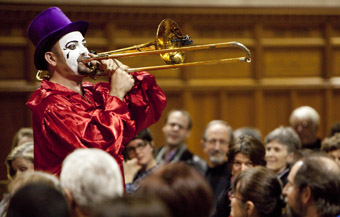
Perspective, Soundstream: Adelaide New Music Festival, Dave Palmer
photo Jia Zhuang
Perspective, Soundstream: Adelaide New Music Festival, Dave Palmer
SOFIA GUBAIDULINA’S CLOWN STEALS THE SHOW AT THE OPENING NIGHT OF ANMF. A TROMBONIST IN COSTUME ENTERS THE AUDITORIUM AND INTERRUPTS A SAXOPHONE QUARTET PERFORMING ON STAGE IN HER VERWANDLUNG (TRANSFORMATION). THUS BEGINS AN ARGUMENT, THE DIFFERENT INSTRUMENTS AND THE PLAYERS REPRESENTING OPPOSING MUSICAL AND CULTURAL FORCES, WITH THE RED-SMOCKED TROMBONIST, THE OUTSIDER, CHALLENGING THE ESTABLISHMENT.
In a program note, Russian composer Gubaidulina states that “the trombonist stands for a Russian archetype, the holy fool or yurodivy.” The yurodivy “plays the fool, while actually being a persistent exposer of evil and injustice.” The clown flirts with the audience—the people—to gain their favour as he attempts to disrupt the saxophonists.
Gubaidulina’s Transformation (2003) is a theatrical composition whose message has universal significance. Unable to suppress the formidable saxophonists, the clown sits dejectedly to remove his makeup while a cellist and a double-bassist take up the musical line. Trombonist Dave Palmer is splendid as the clown who ultimately joins the sax and string ensemble, abandoning his outsider identity by covering his costume and performing from the same score as the others who now accommodate him, developing a canon form to indicate the echoing of new ideas. The work ends with the solitary beat of a tam-tam by a performer-witness in a red shawl who has sat silently by throughout, patiently awaiting her moment, signalling a beginning rather than an end.
Adelaide is a city of many festivals, but until recently hasn’t had a dedicated new music event. The excellent program for this, the second Adelaide New Music Festival, spans a century of composition, attracting good audiences with outstanding performances. In opening the ANMF, former Adelaide Festival of Arts director and ANMF patron Anthony Steel noted how difficult it is to get audiences outside of the comfort zone of the Adelaide Festival.
ANMF Artistic Director Gabriella Smart’s theme for this ANMF is the sacred and profane, and a central character is the clown or fool, who also appears in the closing concert at Coriole Vineyards on the Saturday afternoon.
At St Peter’s Cathedral, Transformation was preceded by a performance for cello, choir, celeste and percussion of Gubaidulina’s Sonnengesang (Canticle of the Sun, 1997), which sets a text by St Francis of Assisi, pays homage to revered Russian cellist Mstislav Rostropovich and attests Gubaidulina’s own faith. In this fabulous work, the choir acts as the orchestra for what is in effect a cello concerto as well as a canticle, and stands in for parishioners. The percussionists rub the moistened rims of glasses that represent chalices, creating a whining sound that blends with the cello and soprano voices to create an ethereal effect. Tubular bells evoke the sound of church bells. Later, the cellist puts down his instrument and walks about the choir as he plays a flexatone with a bow, eliciting a responsory as part of the canticle and thus directing the choir, before returning to the cello to bring the work to its climax.
Sonnengesang is thus based on two distinct musical forms, actively linked by the cellist, and on sacred and profane traditions. Gubaidulina asks much of the soloists in her work, as musical performance is extended into dramatic performance with detailed stage directions. Netherlands-based Australian cellist John Addison, a Gubaidulina specialist, gave a spellbinding account of this complex and demanding piece, and the Adelaide Chamber singers under Carl Crossin were magnificent.
On the second night, Adelaide’s Zephyr Quartet gave a recital exploring Jewish musical traditions, including Argentine-born composer Osvaldo Golijov’s breathtaking Yiddishbbuk, Inscriptions for String Quartet (1992), a reconstruction of music to accompany a set of apocryphal Jewish psalms. The work unfolds as a series of dramatic gestures, with notes held long like screams, and moves on to fragmentary tunes that are frighteningly abbreviated. Also included were Adelaide composer Quentin Grant’s Klezmer Variations and Melisande Wright’s suite Lighter Shades of Pale, both of which foregrounded the unique Klezmer tradition with its seductive, danceable rhythms.
Melbourne’s Anthony Pateras and Robin Fox are internationally renowned but had never before performed in Adelaide. The third night was theirs, Pateras giving a mesmerising performance on prepared piano and Fox a wondrous rendition of his laser and sound show. They formed a dynamic duo to conclude with several short pieces for synthesisers, laptop and Pateras’ sampled voice, with Pateras manipulating the synthesiser as frantically as he had the piano.
On the Saturday there were morning and afternoon concerts in the Barrel Room at the delightful Coriole Vineyards, with a sumptuous lunch in between. The morning session comprised five exquisite short works by Australian and international composers: Pierre Boulez’s Anthèmes (1998) for solo violin (James Cuddeford), Tan Dun’s 1989 intensely introspective Traces for solo piano (Gabriella Smart), Adelaide composer David Harris’s Chinook (2009) for a trio of clarinet (Peter Handsworth), cello (Addison) and piano (Smart), Brett Dean’s Demons (2004, Geoffrey Collins, flute) and finally Hannah Kulenty’s A Fourth Circle (1994) for cello (Addison) and piano (Smart). Harris’s recent work is described as “expressive post-romanticism”, and in Chinook (one meaning of the term is ‘a warming wind’), he adroitly weaves tonal and chromatic lines and contrasting rhythms into a passionate and satisfying composition, highly resolved but with a delicious hint of uncertainty, like a complex rhetorical question. Kulenty’s is a stunning piece, emotionally overwhelming and brilliantly executed. Following a long piano passage like a tolling bell, the cello begins a series of questioning phrases that become incessant, using short, microtonally notated glissandi, crying imploringly—why? why? why? An intense crescendo is then slowly relaxed, with the glissandi curling downward. I was speechless for some time afterwards, so affecting were the writing and the performance.
In the afternoon was a single work, Schoenberg’s classic Pierrot Lunaire of 1912, which, though it is the earliest work in the festival, seems to draw together the threads of the previous four concerts—it was Schoenberg who championed chromaticism; it features the clown who is alienated from society and it speaks of tragedy and loss. Schoenberg set 21 poems to music, to be delivered using sprechgesang, a form of declamatory speech-like singing, in which the reciter slides into and out of notes. Greta Bradman’s performance as Pierrot was outstanding, and she was ably supported by a wonderful ensemble of Smart, Cuddeford, Addison, Collins and Handsworth under the firm direction of Pierrot expert Charles Bodman Rae.
This ANMF comprised an exemplary program of local and overseas works that reflect music’s recent development, thoughtfully curated by the indefatigable Gabriella Smart. Audiences benefited from detailed program notes, gaining a much expanded musical awareness. Especially, we heard music that also needs to be seen, recognising that the playing of an instrument is the enactment of a theatrical role.
Soundstream Adelaide New Music Festival, artistic director Gabriella Smart, Adelaide, Aug 19-22
RealTime issue #93 Oct-Nov 2009 pg. 49
© Chris Reid; for permission to reproduce apply to realtime@realtimearts.net
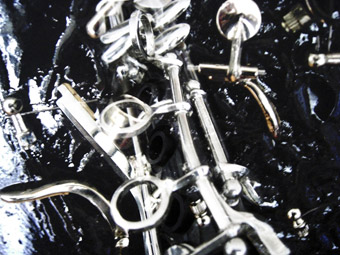
Brigid Burke, Scratching (video still)
courtesy the artist
Brigid Burke, Scratching (video still)
UNDER THE GUIDING HAND OF CHAIRMAN JAMES NIGHTINGALE, THE NEW MUSIC NETWORK HAS EXPANDED ITS CORE PROGRAM OF ESTABLISHED ENSEMBLES TO INCLUDE A RANGE OF CONCERTS BY SOLO ARTISTS AND EMERGING GROUPS OF CONTEMPORARY CLASSICAL MUSICIANS. NOT ONLY IS THIS PROVIDING PROFILE FOR NEWCOMERS BUT, AS MANY OF THESE ARTISTS EMPLOY MORE EXPERIMENTAL COMPOSITIONAL AND PERFORMANCE METHODOLOGIES, IT IS ALSO BEGINNING TO BLUR SOME OF THE PERCEIVED BOUNDARIES BETWEEN THE CONTEMPORARY CLASSICAL (DOT-BASED) CAMP, AND THE EXPLORATORY (IMPROV, LAPTOP, AUDIOVISUAL) GANG. TWO RECENT CONCERTS IN THE NEW MUSIC NETWORK MINI SERIES ARE INTERESTING ILLUSTRATIONS OF THIS.
solo perspective 2
Featuring Brigid Burke, Mark Cauvin and Michael Fowler, this concert offered three contrasting approaches to expanding the artists’ relationship with their instruments. The evening began with Burke who composes for clarinet and video. Her first piece, Island City (2009), is energetic, with sharp vocal utterances, sibilances, intricate clarinet trills and sustained split notes. It is accompanied by snapshots in a grid format of scenes from the coastlines of Victoria and Ichagaya in Japan and a live feed of a seahorse in a fishbowl. The effect is of faded and fragmented recall, where perhaps it’s not the event itself you recall, but rather the memory of the photograph.
Three Sounds on Buildings (2004) offers a more cinematic approach, the extended techniques applied to the B-flat clarinet completing the stark, yet somehow affectionate visual composition of old buildings, graffiti, corrugated iron textures and long pans taken from a train window. There is a sense of nostalgia, perhaps due to the work’s original conception in 1992 (for slides), and while a well-explored visual field, the composition of music and vision provides a satisfying narrative. The final two pieces, Roses will Scream (2007) and Scratching (2009), incorporate live video in a more essential way, overlaying live feeds to affect textures and transparencies on pre-recorded material, both photographic and hand drawn—an impressive feat of multitasking. Both pieces for bass clarinet explore the rich range of the instrument, finding an elasticity to its tone and timbre but with an agile, melodic touch. Brigid Burke’s compositional strategies and integration of visual elements make her performance quite unique.
Mark Cauvin is a man driven to explore every sonic possibility of his instrument, the double bass, thus Stockhausen’s Plus Minus Nr.14 (1963/2009), a graphic score of symbols and instructions, offers the perfect vehicle. In this performance you get a tangible sense of the performer as co-composer rather than interpreter of the work. There are very few pure notes, the interest lying more in the noisy artefact—the scrape, rattle and hum. However, rather than an improviser’s impulsive adventures with these sonorities each of Cauvin’s responses is deliberately extracted, measured and placed. Musician and instrument seem to be in an intense symbiotic relationship as Cauvin summons extraordinary sounds, the correlation of gesture and sound absolutely pure, non-theatrical, yet utterly engaging. Through such demanding material Mark Cauvin creates a sinuousness and continuity between jagged sounds and actions to deliver a mesmerising performance.
There is the sense that Cauvin is also co-composer in his second piece, David Young’s No More Rock Groynes (2009)—a small watercolour score interpreted through a prepared microphone applied to the double bass. Once again, notes with neat frequencies are abandoned, replaced by scratches, squibbles, squeaks, soughs and sighs—a study in how a large instrument can make small and subtle sounds.
The final soloist was Michael Fowler, a pianist also well versed in synthesiser programming and research into the intersection of architecture and acoustic design. Both his pieces explore the piano in duet with machine. The first, Downtime (2005) by Benjamin Boretz explores the interplay between piano and a pre-recorded midi-instrument track. It is spacious, the midi palette unfolding methodically from synthesised drums through to tuned percussion. Each ‘player’ takes turns exploring tones, timbres and the space between. The unaffected midi instruments seem so synthetic in comparison with the deep resonances of the grand piano, drawing our attention to the fundamental timbral nature of the sounds. In Reflections (1975) by Milton Babbit, the machine in question is the behemoth RCA Mk II, the first programmable electronic music synthesiser that few besides Babbit and his colleagues at Princeton University ever managed to utilise. The recorded machine offers a palette of ‘sounds of the future’ as envisaged in 1957, playing spiky polyphonic sequences impossible for human reproduction. Babbit was interested in the attack of the note and as Michael Fowler and pre-recorded material duel, the frequencies tumble over and crumble into each other in what essentially becomes an invigorating onslaught of notes. A fittingly vibrant end to the concert.
golden fur
Golden Fur is a relatively new collaboration between Melbourne musicians Samuel Dunscombe (clarinet, laptop), Judith Hamann (cello) and James Rushford (piano, viola), and they offered a nicely varied program of five pieces. Liza Lim’s Inguz (1998) for clarinet and cello is the perfect opener—both angular yet supple, as clarinet and cello drone slip around each other, their tonalities intriguingly intermingled into an all new sounding instrument. Trio No. 5 (2009) commissioned by the group from Kate Neal, is similarly well suited, allowing the trio to explore high energy, gestural playing, with cycling fragments, replete with dramatic pauses and eruptions. (The program note does suggest that the group explores ‘theatre and ritual’—perhaps a little overstated for some crisp gestures and the plastic wreath that adorns the clarinetist’s locks.)
Rushford’s interpretation of Music for Piano with Slow Sweep Oscillators (1992) by Alvin Lucier is in keeping with the choices of Michael Fowler, however this work focuses on psychoacoustic interplay. As piano resonances cut through the pure sine tone to produce swirling and beating effects, the sound becomes thick and tangible. Rushford’s touch is gentle and evocative allowing the beauty and meditative nature of the piece to come to the fore.
The two final works utilise graphic scores. The first, Parallel Collisions (2008) by Marco Fusinato (both a sound and visual artist), employs a series of visual provocations and stopwatches. It appears from the similar timbral and rhythmic responses (and the title) that each musician plays a musical gesture parallel to the image, which I found a little unsatisfying, particularly as the audience doesn’t get to see the visual stimulus. While I don’t need to see a notated score to experience the music, the rhetoric the group employs about the ‘intersection of visual arts and music’ suggests that the audience might benefit from some sharing of the visual element.
For Jaap Blonk’s Transiberian Part 2 (2001), the trio take to the floor, Rushford playing an amplified viola, Dunscombe a laptop and Hamann laying the cello down for some beating. Listening to their jagged, raspy exploration, I can’t help wondering if it would be more interesting—more organically cohesive—if the musicians threw away the score and simply improvised. It’s not that the sounds irk me, rather I wonder if corraling them into the structural conceit of the visual score makes for the most interesting use. But I have to out myself as being from the no-dots music camp, part of the reason I found the explorations by the musicians in these two concerts particularly engaging and challenging. They revealed the increasing slippage between current contemporary classical and exploratory sound and music practices—a trend that thankfully the New Music Network appears more than eager to encourage.
New Music Network, Solo Persepective 2: Brigid Burke, Mark Cauvin, Michael Fowler, Aug 16; Golden Fur: Samuel Dunscombe, Judith Hamann, James Rushford, Sept 6; Recital Hall East, Conservatorium of Music, Sydney
The New Music Network is calling for concert proposals for the 2010 Mini Series, deadline Nov 30, 2009; www.newmusicnetwork.com.au
RealTime issue #93 Oct-Nov 2009 pg. 50
© Gail Priest; for permission to reproduce apply to realtime@realtimearts.net
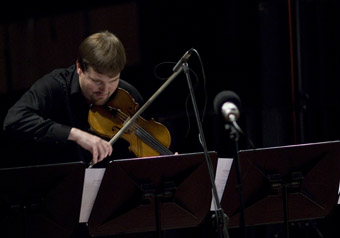
Soloist Graeme Jennings, Elision Ensemble
photo Marc Grimwade
Soloist Graeme Jennings, Elision Ensemble
RICHARD HAYNES MAKES THE E-FLAT CLARINET TALK IN HIS ENCHANTING RENDITION OF MICHAEL FINNISSY’S MARRNGU. IN THE YOLGNU DREAMTIME TRADITION MARRNGU IS THE POSSUM MAN, AND FINNISSY’S WORK IS ABOUT MARRNGU’S STORY, A STORY TOLD IN MUSIC RATHER THAN SPOKEN WORD.
Finnissy’s 1982 composition resembles speech in its lilting, dramatic tones, gathering in intensity and emotion as the story unfolds, the linear phrasing mimicking an emphatic story-teller. Though smaller and higher pitched than the more common B-flat clarinet, the E-flat clarinet has a rich, creamy sound that is particularly evocative in suggesting the human voice. Haynes builds deep, complex character into the music, and his playing of this demanding work is effortless and beguiling.
Elision concerts are like no others—showcases of exquisitely crafted works for solo instruments or small ensembles that push the limits of instrumental performance. This evening was set out as two one-hour concerts, each of five short works written between 1981 and 2009. The selection especially showed how instruments can express the human voice and tell a story.
The first concert opened with Tristram Williams’ solo trumpet performance of Liza Lim’s Wild Winged-One (2007), which Lim reworked from her opera The Navigator. The trumpet represents the Angel of History, which, according to the program notes, is a “half-human half-animal bird figure of prophecy and witness.” Williams creates a language of sound forms, combining breathing through the trumpet with scatty motifs to form a kind of declamatory speech. This was followed by Richard Barrett’s inward (1994-95), a kind of dialogue that opens with gently tinkling percussion (Peter Neville) followed by a long, lyrical exposition for flute (Paula Rae). Again the performer’s own voice is heard through the instrument. The dialogue is ultimately an internal one, a troubled soliloquy culminating in a long, high exclamation.
For Jeroen Speak’s Silk Dialogue VI (2007), scored for string quartet, E-flat clarinet, flute and five snare drums, the six performers are seated in a semi-circle, and between each is a drum they beat periodically to mark each section of the work. These forceful junctures frame the music as a series of discrete, almost visibly geometric shapes, culminating in a drum crescendo as if concluding a story told in exquisite drawings. The E-flat clarinet part leads the work, and Speak’s writing for it is persuasive—it was commissioned by Haynes, who is again brilliant, and, for me, Silk Dialogue VI is the centrepiece of the evening. The writing is finely crafted and the threads are densely woven yet light and airy, creating musical forms that swirl around. The conductor, Hamish McKeich, holds it all together wonderfully.
The first concert concluded with another extended solo work—Roger Ramsgate’s Ausgangspunkte (1981-82), a very intense piece for oboe that requires a herculean effort from the performer, Peter Veale. The work is complex and detailed, requiring almost as much concentration from the listener as from the performer.
The second concert opened with Benjamin Marks’ Perdix (2009) for trumpet and vibraphone, though the latter comes in only towards the end, gently cooling a very heated trumpet solo. The writing is agitated but quizzical, again a kind of soliloquy, but calm is restored at the conclusion. This is followed by Graeme Jennings performance of Liza Lim’s Philtre (1997) for solo Hardanger violin, a more introspective piece that exploits the unique resonances that emerge from the violin’s sympathetic strings.
Richard Barrett’s Wound (2009), for violin, cor anglais, E-flat clarinet and cello, was evidently influenced by the paintings of Francis Bacon in which the action is framed within the canvas. The violinist stands opposite the other performers in animated exchange with them, and, for me, the composition posits the violin as interviewee and the other instruments as inquisitors, or perhaps the violin as a bird and the others as its cage. The human voice proper reappears in Robert Dahm’s absorbing work the flesh is grammar (2009), for a wind and brass septet that includes contraforte, a reed instrument that produces the deepest notes. The text in the work is whispered or spoken by the performers, combining with densely layered instrumental textures to produce a juicily corporeal effect. Your attention shifts back and forth between the compositional structure and the instrumental timbres and resonances, with the personality of each instrument becoming a character in a play.
In many works, the performer complements the composer by developing novel techniques to realise new musical forms and new aesthetics. Elision concerts are precious opportunities for the creation and performance of innovative music by the best composers. They demand virtuosic playing and reward committed listening.
Elision Ensemble in Session, live broadcast, Iwaki Auditorium, ABC Centre, Southbank, Melbourne, July 28
RealTime issue #93 Oct-Nov 2009 pg. 51
© Chris Reid; for permission to reproduce apply to realtime@realtimearts.net
AS PART OF THE LIQUID ARCHITECTURE FESTIVAL’S 10TH ANNIVERSARY, I WAS COMMISSIONED TO TRAVEL ALONGSIDE THE ARTISTS TO EACH OF THE PARTICIPATING CITIES AND WITNESS THE PERFORMANCES, ATTEND FORUMS AND TAKE PART IN INFORMAL DISCUSSIONS, WHILST SHARING MY THOUGHTS ON THE LIQUID ARCHITECTURE BLOG AS A MEANS OF INCREASING THE DIALOGUES BROUGHT ABOUT BY THE EVENT.
This initiative came to be in response to the dissatisfaction of Liquid Architecture organisers and artists with the level of critical feedback generated following past festivals. In touring, I learnt that such critical exchanges exist, but sadly are not often formalised or committed to print.
I saw the entirety of Liquid Architecture and in a new light, as a multifaceted event. I witnessed several very different festivals across Australia, reflecting the collaborative nature that founding director Nat Bates often mentions when discussing Liquid Architecture. It was also clear to me that after 10 years the festival has entered a phase of reflection and self-critique.
The multifaceted nature of the festival raises many questions; on the road with LA10 the vibrancy of sound arts and exploratory music practices in Australia was evident. Tura New Music in Perth, ROOM40 in Brisbane, Alias Frequencies and Plum Industries in Sydney, On Edge and The House of Falcon in Cairns as well as Cajid Media in Central Victoria were co-producers with Liquid Architecture based in Melbourne. They brought their own organisational practices to the hosting of the international artists toured by Liquid Architecture. It should be noted, however, that LA10 was one tier of what these organisations do yearly (often collaboratively, across states). So, beyond providing international artists, what additional role does Liquid Architecture play?
Over the 10 years that Liquid Architecture has grown as a brand, a certain stability and perhaps expectation of an aesthetic and presentation standard has developed. It is safe to say that the festival’s scope is not (and would not claim to be) an accurate account of all exploratory sound practices currently engaged in globally. International performers travelling to the festival tend to be European (and to open an argument that I must start and end here for the sake of brevity) male, and often of certain European avant-garde music traditions that perhaps reflect the tastes of the Melbourne organisers.
It could be argued that the true variety in the festival’s programming is the assortment of local artists. The usual international component of Liquid Architecture is likely to be, as one friend noted in passing, “men with machines.”
So for many it’s disappointing that Liquid Architecture’s palette of performers reflects not so much a survey of international contemporary practice (as perhaps the Melbourne International Biennale of Exploratory Music in 2008 did more successfully) as appearing to be a specialist music organisation supporting a particular tradition.
However, the festival has created greater access to experimental music than other events. This is not true of all the states that Liquid Architecture travels to, but the attendance at this year’s North Melbourne Town Hall concerts proved that 10 years has helped develop an audience that wouldn’t be accommodated at the numerous smaller events occurring constantly in Australian underground music scenes.
At a forum organised by Within Earshot, a collective of RMIT University Fine Art (Sound) students, there was a lively debate surrounding dissatisfactions with the first Town Hall concert. The point was made that for new audiences, the concert did not present a varied program of what is truly taking place in contemporary exploratory music cultures both in Australia and abroad. For first timers, it would have shown merely one (rather Euro-centric) take on the sonic arts. Does this require the festival to be the provider of a perhaps impossible survey? Is it about the festival miscommunicating its motivation? Festival co-founder and director Nat Bates often states in conversation that if the festival causes disagreement amongst patrons leading to them starting their own event, that would be a success. But for LA’s new (and growing) audience, does such a view carry weight? Yes, there are plenty of new events being organised constantly by those who wish to get people thinking about sound. But, LA 10’s satellite events at Horse Bazaar and the Within Earshot for RMIT students did not feel like a considered part of the festival.
The very fact that Liquid Architecture has grown into a major, national event reveals that the exploratory sound cultures of its focus are not as niche as once thought. It was my sense in traveling with the festival that the transition from Liquid Architecture’s point of conception as a vessel for presentational opportunity to its current incarnation, happened too quickly for the festival organisers to keep pace. Certainly, I gathered a sense of dividedness as to what LA10 was trying to deliver. The organisers themselves might be in two (or more minds) about it. The festival’s funding too, does naturally provide expectations about what Liquid Architecture should deliver.
LA’s directors are working hard to consider not simply avenues of improvement but how to solidify Liquid Architecture into a stable, pertinent incubator for a critical exchange on sound arts. There are other opinions about what Liquid Architecture could be, but so long as these thoughts remain word of mouth perhaps we will not witness much change.
Liquid Architecture 10, June 24-July 12, www.liquidarchitecture.org.au
RealTime issue #93 Oct-Nov 2009 pg. 52
© Jared Davis; for permission to reproduce apply to realtime@realtimearts.net
AS CHRIS REID WRITES IN HIS REVIEW OF THE SOUNDSTREAM NEW MUSIC FESTIVAL (P49), SOME MUSIC HAS TO BE SEEN AND NOT JUST HEARD. BRISBANE-BASED TOPOLOGY’S EAST COAST TOUR GAVE US A LIVE, WORKING BAND WITH A CASUALLY THEATRICAL AND JAZZY SPONTANEITY YOU MIGHT NOT BE EXPECTING FROM THEIR NEW CD, BIG DECISIONS, WHICH OFFERS OTHER PLEASURES. SYDNEY’S HALCYON DELIVERED A MORE FORMAL CONCERT WITH AN OPERATIC INTENSITY IN WORKS WITH BIG AMBITIONS AND VISIBLY COMPLEX INTERPLAY BETWEEN PERFORMERS.
Robert Davidson aside, Topology’s musicians are an unassuming bunch onstage, but the bassist’s amiable mc-ing, occasionally miming to the voices of Australian politicians in his Big Decisions: The Whitlam Dismissal (2000) and having the audience chant “We want Gough!” on cue, add fun to the occasion. The concert opened with Bernard Hoey’s Chop Chop which briskly marshalled a big band sound from small forces. After John Babbage’s lyrical tenor sax realisation of a Pat Nixon aria from John Adams’ Nixon in China (from the Topology CD Perpetual Motion Machine), Hoey’s viola improvisation on Davidson’s Exteriors (a response to Southern Indian temple architecture) ranged through meditative warblings to passionate flourishes supported by tabla-ish taps on Davidson’s double bass. Babbage’s witty arrangement of Cold Chisel’s Cheap Wine starts out 50s cool jazz and then proves Topology can rock.
The concert centrepiece, Big Decisions, was at once entertaining and chilling (it never fails to vividly remind me of that fateful November 11th). Other works on the program were not familiar but excited interest: Babbage musing on the genome (X174; 2003); Davidson dextrously exploiting the Australian-American rhythms and twang of an ex-Brisbane Christian fundamentalist, Ken Ham, who’s now big in the USA (Generation after Generation; 2008); and another Davidson work, Round Roads (2008). The latter was triggered by a bicycle ride in Canberra that recalled childhood life there including a bushfire, the music oscillating between sweet reflectiveness, potent piano-bass propulsion and some dramatic sax interpolations.
The Sydney duo, Halcyon (soprano Alison Morgan, mezzo-soprano Jenny Duck-Chong) gather composers, instrumentalists and other singers around them to create distinctive, inventive concert programs. Extreme Nature featured bold new works from expat composers recently returned to Australia, Elliott Gyger and Nicholas Vines.
Gyger’s From the Hungry Waiting country (2006) draws on Australian poems (mostly of an older generation: Harwood, Stow, Riddell, Hart-Smith, Buckley, Hope) and Near Eastern religious texts in response to “a profoundly ethical dimension to the emerging ecological crises” (Gyger, program note). Morgan and Duck-Chong were joined by soprano Belinda Montgomery and mezzo Jo Burton to execute the demanding interweaving and layering of texts, surprising glissandi and humming, buzzing insectile vocal noise. Genevieve Lang’s harp entwined beautifully and at times dramatically (buzzing too and twanging) with the singing, making the instrumental interplay with the four superb voices the highlight of the work. It was fascinating to watch the exchanges between these artists, heightened by the various re-groupings of the singers, with the harpist a logical extension of the line-up rather than as sidelined accompanist.
Save for the final text, AD Hope’s Australia (an odd choice, Gyger admits, but deployed to target political rather than intellectual poverty), making sense of the poems is hard work and best left until a recording is made available. Countering Hope’s bitterness, the work ends moving from an almost staccato rendering of lines that then flow into neat harmonies, with an almost Swingle Singers’ jazziness, and a final, musing lyricism. From the Hungry Waiting Country is a complex, consuming work, at once grim and beautiful.
In their onstage intermission dialogue, Gyger and Vines discussed the relationship of their music to “large masses of text.” There was agreement that their approach is “not directly semantic…not every word will be understood, but the work will be ‘semantic’ from a different direction [as] a lattice of reference, starting with poetry that is already complex.” It was suggested that “words are musical regardless of meaning” and that “the poem is a kind of music.”
Nicholas Vines writes that his Torrid Nature Scene (2008) “is at its core a squelchy, lusty romp” but one intended to counter the technologising of our lives and values. In the dialogue with Gyger, Vines said he thought “lush” was not a word typically associated with Australia, but that he wanted to create “a febrile density” in his work, and so he does. The text, a poem by Andrew Robbie, is already dense with ideas and images, and Vines adds nine instrumentalists to engage with Morgan and Duck-Chong. After the opening Wagnerian flourish we are introduced to a sonic world that is certainly lush, rich in operatic soaring, quackings, glides, post-orgasmic gasps, relished words chewed over, and ringing, starry bursts of voices and ensemble as one. In memorable, intense, sustained passages for one singer, the other counters with an undercurrent of noises evocative of nature and the body’s own musical otherworld. Torrid Nature Scene is almost overwhelmingly dense on a first hearing, but its strange beauties are many (its hyper-literary text best left impressionistic). Extreme Nature was an exhilarating if demanding concert, its cogency in no small part the contribution of conductor Matthew Coorey.
At the 2009 Classical Music Awards, Topology picked up the prize for Outstanding Contribution by an Organisation for its inventive 2008 series of collaborations at the Brisbane Powerhouse. Topology will appear with Taikoz and Karak at the Enmore Theatre, November 27, www.enmoretheatre.com.au.
Topology, Sound Lounge, Seymour Centre, Sydney, Aug 20; Halcyon, Extreme Nature, Verbrughen Hall, Sydney Conservatorium of Music, Aug 7.
RealTime issue #93 Oct-Nov 2009 pg. 52
© Keith Gallasch; for permission to reproduce apply to realtime@realtimearts.net
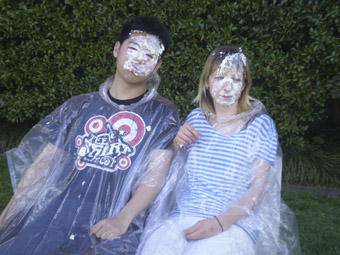
Pie, spat+loogie with Willoh S Weiland
image courtesy and copyright the artist
Pie, spat+loogie with Willoh S Weiland
SINCE ITS INCEPTION IN 1992 PRIMAVERA HAS BECOME ONE OF THE MOST HIGHLY ANTICIPATED SHOWS IN THE MUSEUM OF CONTEMPORARY ART’S YEARLY PROGRAM, OFFERING A SELECTION OF WORKS BY AUSTRALIAN ARTISTS UNDER 35—A PROMISE OF THINGS TO COME. YET WHAT HITS YOU ON ENTERING PRIMAVERA 2009, IS THE GALLERY’S SLIGHTLY DEPRESSING RESEMBLANCE TO AN ART STUDENT STUDIO—THERE IS A CIRCLE OF USED AND ABUSED CHAIRS, PHOTOS STUCK TO THE WALL, FOOD SCRAPS AND A NONDESCRIPT TIMBER CONSTRUCTION.
This held-together-by-masking-tape look is after all a signifier of our visual arts times but it hasn’t until now made much of an impact on the clean-cut Primavera experience. This year, guest curator Jeff Khan has conceived an exhibition that feels different from its predecessors.
Khan, who is known for his artistic direction of Melbourne’s emerging and experimental arts festival Next Wave, scattered around the city from underpasses to art spaces, has (not surprisingly) focused Primavera 2009 on interdisciplinary and expanded practices that engage social connectivity. But selecting artists for a major art institution exhibition who “propose a departure from fixed studio practices and exhibition-focussed styles of art making,” (Jeff Kahn, catalogue essay) can be as problematic as it can be progressive.
One of the highlights of Primavera, the performance project Pie (2009) by collaborative duo spat + loogie (Kat Barron and Lara Thoms) with Willoh S Weiland, serves as a key example. Dressed as waiters on the MCA lawn spat + loogie invite whoever is game to sit with various curators who have been recruited for the task, for one to one 10-minute discussions. The duo offer inspiration by providing a ‘menu’ of accessible and witty topics that invite probing questions into the nature of contemporary art, including “Is skateboarding art if you slow it down?” and “Are these tourists making video art.” Offering participants the opportunity to throw a cream pie in the curator’s face at the conversation’s conclusion, spat + loogie ensure that each pays the price for stuffy art-speak or meaningless waffle.
But blink and you’ll probably miss it. Taking place just five times over the course of Primavera and with only a few tokenistic cream pies and photos in the gallery, Pie raises the wider issue of how performative or ephemeral practices can sustain a satisfactory and much needed presence within the institutional sphere. The beauty of Pie is that it values its participants and engages art goers and random passersby alike, but it makes for a sadly disappointing experience for the majority of Primavera visitors who will simply miss out.
In contrast Christopher LG Hill and Andy Best both explore the social act of art making via collaborative projects that result in substantial gallery exhibits. Hill investigates ideas of value and exchange through collaborations with his art peers that often generate sculptural installations, such as Clique (2009) in Primavera. Clique consists of a democratically arranged ring of modified, almost anthropomorphic chairs interspersed with subtle sculptural assemblages. As if standing in for their makers they reflexively symbolise the collaborative process and open dialogue that created them. A reading bench covered by art publications completes the seating circle, implying that gallery visitors aren’t excluded from the clique but can engage in its ‘exchange’ of information, but with no way to respond this is a purely symbolic, one way system.
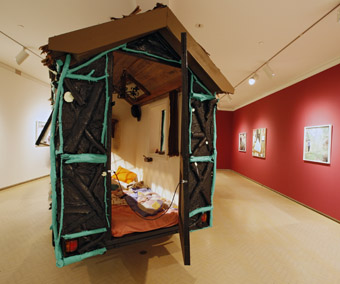
Oom Unit (2009), Andy Best
image courtesy the artist
Oom Unit (2009), Andy Best
Best’s practice revolves around a semi-fictional art community called Oom—a small group of young trendy artists (his friends) who get sloshed and smoke spliffs, make naive paintings that appropriate cult symbolism, play in the woods and sleep in caravans. His installation in Primavera blurs the distinction between documentation and promotion and includes grainy mobile phone photographs, access to the Oom website and, as the centrepiece, the Oom Unit (2009), a small caravan made of logs, housing an unmade bed littered with peppermint tea, sesame snaps and Mentos—think “Tracy Emin quits the London scene to become a gypsy.” It appears that Best and his friends’ exploits and artistic output are products of Oom in two respects—they arise from collaboration and are also part of the Oom ‘brand.’ But as with all branding you have to wonder if there is substance behind the rhetoric, for instance, just how these hippy student clichés provide “genuine alternatives to current conventions”, as the wall text states. I’m left unsure.
The artists’ installations aren’t as compelling as the territory they explore conceptually and performatively. The symbolic ‘aftermath’ of their social connections—Hill’s mismatched chairs and Oom’s cramped sleeping arrangements—are tellingly empty.
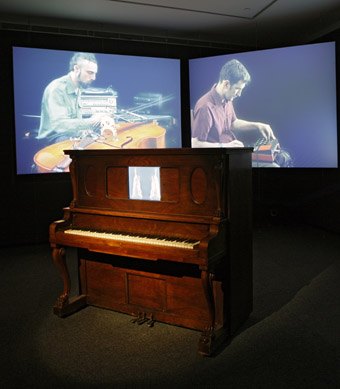
Autonomous Improvisation V.1 (2007), Wade Marynowsky
image courtesy the artist
Autonomous Improvisation V.1 (2007), Wade Marynowsky
Wade Marynowsky and Michaela Gleave offer more satisfying experiences. Avoiding the challenges of non-autonomous art, Marynowsky’s aptly named Autonomous Improvisation V.1 (2007) recasts Sydney’s live performance community into a B-grade horror movie spectacle (RT79,p24). With digital candelabra, warped sound styling and ominous lighting, he improbably combines automated computer technology and 19th century gothic kitsch. Eerily tinkering keys on an automated pianola activate a network of computers that reanimate 37 recorded performances in real time. A red-nosed clown, a didjeridu player, a flamboyantly pink-wigged and otherwise naked hula hoop-er and some seriously absorbed Mac noisicians are just some of the characters who appear in stilted bursts and in randomised sequences across three screens. The result is schizophrenic. As non-linear, surreal narratives emerge, the individual improvisations lose their autonomy, creating an entertaining and provocative metaphor for ‘community.’
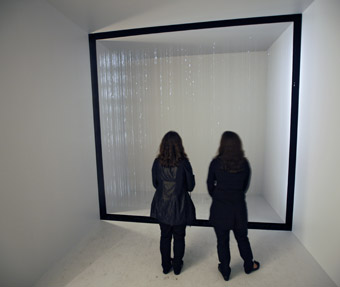
Raining Room (Seeing Stars) (2009), Michaela Gleave
image courtesy the artist
Raining Room (Seeing Stars) (2009), Michaela Gleave
The outer appearance of Michaela Gleave’s Raining Room (Seeing Stars) (2009)—the aforementioned non-descript timber construction—belies the presence of a romantic and bewitching phenomenon that surprises the visitor once inside. There, continually falling, harvested rain drops glisten and flicker like diamonds in the dark. But Gleave engages our senses beyond just sight—the pitter-patter sound evokes a comforting, archetypal memory of hearing rain on the roof. You can touch or walk through the water, while outside the looming cubic construction is imposing and awkward in the gallery space. Made for more than housing a saccharine illusion, the exposed nuts and bolts of the external architecture and visible rain-making apparatus ask us to consider the entrenched infrastructure that distances urban dwellers from a connection with the natural world.
The remaining works in Primavera are comparatively unassuming but reward contemplation. The result of Christine Eid’s research into taxi-drivers in Lebanese-Australian communities combines the languages and methods of both social history and the visual arts. Wall-mounted rearview mirrors and taxi lights bearing drivers’ names verge on the literal, while the accompanying short film Transit (2006), is a sensitive and emotional account of Eid’s father’s experience as a taxi-driver.
Kinetic artist Ross Manning creates everyday automata from playful junk assemblages. Neo-Luddite Pyjama Party (2009) for example, is a mess of tangled wiring, barely balancing fans atop Jenga-like piles of scrap timber and precariously swinging projectors that, via a carefully interconnected system creates an alluring Aurora Australis-like visual effect from refracted and mediated light. Manning’s confusingly complex yet lo-fi constructions wryly invite us to question our reliance on the ‘invisible’ technologies that permeate modern life.
Rather more serious in tone is Western Australian artist Roderick Sprigg’s installation Mechanical Nuisance (2008), an investigation of masculinity within isolated farming communities. Using discarded safety mechanisms from agricultural equipment, Sprigg has constructed a dining table modelled on the one in his family home but that darkly resembles a sort of torture chamber. Together with video projections of himself at work and his grandfather playing the harmonica, Sprigg’s installation sombrely suggests that despite isolating and arduous work, these men feel happier out in the fields than in their own homes.
Jeff Khan’s signature on this show is clear in the strong thematic association between works, playful cross-contamination (between Hill and Gleave’s works) and the somewhat risky inclusion of performative and non-autonomous art forms. The show proposes an exciting new future for Primavera as a platform for dynamic practices—both artistic and curatorial. While overall the work in Primavera 2009 offers less of the wow factor than past shows (recall Soda_Jerk’s epic Astro Black in 2008, or Martin Smith’s achingly honest and delicately defaced photographs in 2007), this community-minded grass-roots Primavera is more of a grower.
Primavera 2009, curator Jeff Khan, artists Andy Best, Christine Eid, Michaela Gleave, Christopher LG Hill, Ross Manning, Wade Marynowsky, Roderick Sprigg, spat+loogie with Willoh S Weiland; MCA, Sydney, Sept 9-Nov 22
RealTime issue #93 Oct-Nov 2009 pg. 53
© Josephine Skinner; for permission to reproduce apply to realtime@realtimearts.net

Wienie Collapse 1965-1983: Bibbidi Bobbidi Boutique, Downtown Disney: “Beautiful prima ballerina dancing in white dress with red light shining from below. Black cloak spread out, about to wrap it around her. She is stepping towards you on the stag
VISITORS TO PRIMAVERA 2008 AT SYDNEY’S MCA MAY RECALL MARCUS CANNING’S PINK WIENIE—A 6 METRE HIGH SILICON CASTLE THAT COLLAPSED UNDER ITS OWN WEIGHT AND BECAME, IN ONE REVIEWER’S WORDS, “A GRANDIOSE POOL OF FAILURE.” FROM THE DEBRIS, REARRANGED, AUGMENTED AND PHOTOGRAPHED, CANNING HAS CREATED WIENIE COLLAPSES, A BODY OF ABSTRACT ‘MEDITATIONS’ ON LATE CAPITALIST CONSUMPTION AND COLLECTIVE CONSCIOUSNESS.
The word ‘wienie’ in Canning’s titles refers less to the ‘immature penis’ or Viennese sausage than to Walt Disney’s term for the iconic castle at Disneyland’s centre. The term is still used by Disney creators to describe the “visual magnet” at the heart of an attraction, and by film crews for the sausage-waving technique that guides stage dogs through a scene. Canning’s luscious inkjet prints mounted on aluminium feature a kaleidoscopic array of forms, complemented by a selection of verbatim Rorschach Test data gathered from Nazi war criminals prior to the Nuremberg trials. These quotations are intrinsic to the works, while the individual titles all reference real Disney castles and their locations, as well as the European architectural follies that inspired them.
Canning’s prints are striking in their lurid spectacle, textural detail and the near-invisible surface on which their folded, wedding-cake richness is overlaid in hot pink, white, and glossy black. The mirrored arrangements seem 3D despite—or perhaps because of—a textural quality as smooth as glass. The wall-mounted Rorschach Test quotes point to a range of interpretive possibilities: “Two gremlins busy with human vertebrae”; “Two pink mice climbing up a tree”; or this one: “Skin of an animal, such as you would see on the floor of a lady’s room. The lady who owned it altered it by adding feathers. Only a lady would do this.”
Nowhere is there a Rorschach quotation to suggest the obvious: Wienie Collapses is easily read as a set of lushly prepared allusions to female genitalia. The lengths gone to to elide this possibility sometimes appear extraordinary, for example: “A funny bear fur spread out…It is alive and represents Bolshevism over-running Europe.”
To create Wienie Collapses, Canning mixed quantities of sump oil, hair gel, sugar and liquid soap into the remains of Pink Wienie to form what he calls “psychotropic landscapes”, which were then photographed and manipulated to create symmetrical configurations. The materials reference some of consumer culture’s most ubiquitous substances; oil and sugar providing potent symbols of what might be termed ‘western decadence.’ The work follows on from Canning’s earlier preoccupations with late capitalism, explored through video, installation and sculpture, such as the creepy Dough Boy video (1999) or Midas (2006), which featured a revolving planet formed from plastic trophy heads.
Conceived as the world economy was going into meltdown, Wienie Collapses explores a literal and theoretical terrain that cleverly weaves the playfully phallic ‘wienie’ into a seductive commentary on excess, folly and material desire. The annotation of the collapsed balloon castle’s photographed detritus with Rorschach quotes draws further associations between consumption, desire and mass psychology, as well as teasing out questions about the meaning and interpretation of art—ultimately another ‘consumer’ product.
Anyone who’s ever seen a vagina at close range will recognise in Canning’s images the clitoral shadows, the tucks and folds, the sense of ragged symmetry and satiny textures. But Canning insists this wasn’t his intention. At most, he acknowledges “the straight-up irony of a glistening pink castle, with all its inherent embodiments of phallic monumentality and mentality across western history, ultimately collapsing into a series of very polymorphic psychotropic works…”
At the same time, “There was definitely an attempt to evoke a sense of a grotesque anatomy, an uncanny body—but a surrogate or artificial body that is corrupted and mutating.” A brave statement, given the historical (and spurious) western binarising of nature–femininity–chaos–corruption versus culture–masculinity–order–reason.
Wienie Collapses fuses a lush array of ideas and a cornucopia of visual intrigue, cleverly critiquing late capitalism’s folly around the anchoring trope of the collapsing wienie. The series certainly fulfils Marcus Canning’s aim of containing “enough teeth, barbs, hooks…to maintain a tension over time, but at the same time fit the profile of a product range…that would hover in a space between attraction and repulsion…”
There’s a juicy irony in this combination of commercial intent and cultural commentary, especially given the central symbol of the must-have ‘wienie.’ Arisen from the detritus, Wienie Collapses is not so much “a lobster pie with decorations” or “a substance taken out of an operated knee”, as a flamboyant, laughing phoenix.
Marcus Canning, Wienie Collapses, Goddard de Fiddes Gallery, West Perth, Aug 7-28
RealTime issue #93 Oct-Nov 2009 pg. 54
© Urszula Dawkins; for permission to reproduce apply to realtime@realtimearts.net
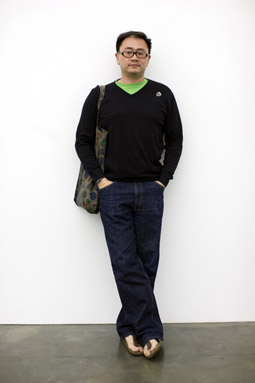
Emil Goh
photo courtesy Jason G Lewis
Emil Goh
THE SAD NEWS ARRIVED AT THE REALTIME OFFICE IN LATE SEPTEMBER OF THE SUDDEN DEATH OF THE TALENTED AND GREGARIOUS NEW MEDIA ARTIST EMIL GOH IN SEOUL.
Born in Malaysia, Emil graduated from the University of Newcastle and went on to study Photography and Sculpture at Sydney College of the Arts and in the late 90s earned his Master of Fine Arts at Goldsmith College, University of London. For many years, he moved between the big cities of Asia, Australia and Europe. We ran into him last year in Sydney’s Chinatown at an opening at Gallery 4A (Asian Australian Artists Association) of which he was a founding member.
After London, Emil spent time in Hong Kong and in 2003 was awarded an Asialink residency to Seoul, a city he came to love and where he eventually settled. Of late, he’d exhibited widely, taught art and design at a number of Korean arts institutions and was working on a range of art and design projects, among them design-it-yourself meditation pods.
An artist obsessed with ephemerality and the everyday, Emil’s output was substantial. In 2005 he showed at the Jakarta International Video Festival and in Seoul: Until Now in Copenhagen. His work was included in Mix-Ed at Sherman Galleries, 2004, in Location Location, at the Australia Centre for Photography, Sydney, 2003, and in 2004 he participated in the Busan Biennale at the Busan Metropolitan Art Museum. Emil had residencies at London’s Hayward Gallery, Hong Kong University, the Chinese Arts Centre in Manchester and SSamzie Space, Seoul.
We recall with pleasure Emil’s work, Between, at the old Performance Space in Redfern. Displaying his customary intimacy and lightness of touch, it comprised 360º video panoramas he had made by perching his rotating miniDV camera on window sills to reveal a 180º view of the inside of a familiar room in two different cities and the view outside. At the time he described the impetus for the work thus: “My entire childhood was spent moving all over Malaysia when my father was transferred for work. It was kinda fun growing up in so many different houses. As a result, I’ve been fascinated how people live ever since.”
This fascination extended to online lives in Emil’s MyCy series made in Korea, the city that became the focus for his work. “What makes MyCy so interesting is the miniroom, one of the main features of a Cyworld Minihompy (homepage). It’s a blank room a user can decorate so in essence it becomes their online ‘living room” or any other type of space they desire. On the surface, it seems trivial, but it’s a reflection of life in Seoul as a young person. Most live with their parents till they get married and the home in general is exclusively for the family, not a place for socializing. So the miniroom is the public manifestation of one’s perfect ‘private’ space. Hence my fascination for domestic living situations has extended to their online versions and the pairing allows me to explore both landscapes.”
Seoul, it seems, was a city made for Emil with its super high speed broadband and where, he wrote, “updating your Minihompy everyday is de rigueur…Korea is a very young and evolving economy. Highly developed parts of the city were rice fields 25 years ago. The city is changing very fast, and observing the adaptations and the process of transition are at the core of my work/research. I guess you could say I am doing a kind of study in the manner of a documentary project.”
His documentation took him on some winding paths, gathering friends and colleagues along the way. One of these says: “He was collecting pictures of the city. According to his latest report he had over 49,000 in his hard-drive. He could spend days riding his GPS-enhanced bike while taking shots of buildings, people or just different types of kimchi. I swear I saw him photographing every single dish we ordered at restaurants. He collected all sorts of mobile phones just for the pleasure of understanding how they work. He even got an iPhone when it was not possible to use it in Korea just to play around with the UI.” http://arduino.cc/blog/?p=333
Fittingly, the record of Emil Goh’s considerable artistic achievement is well archived at http://www.vwfa.net. A prolific poster, it’s wonderful as well to read and see on the net the myriad manifestations of this remarkable artist in his own words and images and those of the many others whose lives he touched. Keith & Virginia
RealTime issue #93 Oct-Nov 2009 pg. 54
© Keith Gallasch & Virginia Baxter; for permission to reproduce apply to realtime@realtimearts.net
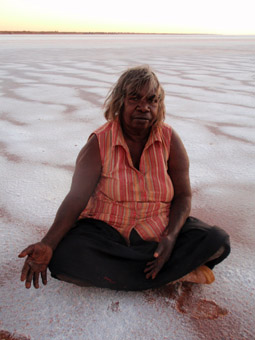
Yuwali on location
courtesy Contact Films
Yuwali on location
SINCE FIRST APPEARING ON THE ABC’S RACE AROUND THE WORLD SERIES IN 1997 (THAT ALSO THREW UP THE GREAT SATIRIST JOHN SAFRAN), BENTLEY DEAN, USUALLY IN COLLABORATION WITH ANOTHER DIRECTOR, HAS MADE A SLATE OF UNFLINCHING DOCUMENTARIES FOCUSING ON SOCIAL JUSTICE ISSUES AROUND THE GLOBE.
In 2001 he began working for SBS’s Dateline and became captivated by South America (directing Anatomy of a Coup in Venezuela and The Siege in Peru) before turning his lens back to Australian issues with the AFI Award-winning The President Versus David Hicks and, one of my favourite documentaries of recent years, A Well Founded Fear, which follows a number of refugees who, rejected by the Australian government, are forced to return to their home countries, often under threat of violence or possible death.
Dean’s latest film, Contact, with co-director Martin Butler, is the story of an Aboriginal woman Yuwali and her Martu tribe of 20 women and children, the last remaining clan living in the isolated Percival Lakes, who in 1964 are ‘discovered’ when they come into contact with white men for the first time.
These “white devils”, as Yuwali calls them, are getting ready to launch a rocket from Woomera and plan to use the Martu land as a “dump area” for crash debris, believing it to be uninhabited (terra nullius, yet again). Terry Long and Walter Macdougall, native welfare patrol officers, were appointed to scour the deserts, looking for any signs of life, armed with cameras. Long says, “We didn’t expect to find anyone out there”, but they soon discover middens and traces of fires and the search is on. The directors have been busy in the ABC archives unearthing amazing footage: the women’s first shy and fearful approach is captured on film (and in photographs); but there are also also preparations for the rocket launch—enormous wide load shipping containers carried on trucks through small country towns and into the bush.
Dean beautifully evokes the stark contrast between a civilisation excited by technological advancement, building and launching satellites into space, where nothing stops for progress, and a community that still hunts and gathers, using dingoes as guides, living ‘entirely off the land.’ Yuwali, seeing cars for the first time, thinks that “big rocks have come alive”, rolling around her camp. When the men arrive at night, the women think they are being chased by monsters (the cars’ headlights scary eyes) and they disappear silently into the landscape, beginning a game of cat and mouse where, intriguingly, the white men become the trackers, searching for clues, following footprints. The women call on the spirits to send in torrential rain, which arrives the next day, washing away their tracks. The officers are forced to hire two Aboriginal men who speak local language (and can move quicker than a bogged truck) to find the women and convince them to leave the desert. Long is a candid subject who admits, “the political scene was quite beyond us” and the rocket launch eventually goes ahead, with the women and children still caught in the desert, huddled terrified watching a fireball in the sky, their ankles roped so they can’t run away.
What’s refreshing about Dean’s documentary is that it’s told from the dominant perspective of an Aboriginal woman. Yuwali was 17 when the first contact was made and is now a feisty 62 with a startling recall for detail. Usually, when we’re told of the first landings of settlers in Australian history, it’s the Aboriginal perspective that’s often missing or sidelined, difficult to trace. Here we have the unique opportunity to hear what Aboriginal women thought first-hand when they encountered whites invading their territory (“A monster is coming. Run, run!”). Yuwali describes the men as “cannibal beings”; she’s terrified they’ve come to eat her. We also get a strong sense of what the land—the “big serpent place” with its Dreamtime stories—means to the Martu women, and Dean’s sublime cinematography translates the beauty of this majestic and quiet place (a fresh water spring in the middle of a salt lake), in contrast to the white men’s vision—a place for dumping waste.
Dean also jumps at the chance to subvert the original ethnographic-style footage—traditionally used to subjugate and classify Aboriginal people—so it becomes instead a tool for empowerment. The women re-enact the story in situ, voicing their memories while hiding in bulrushes, or walking through the desert, and by the documentary’s end, the footage is replaying on an outdoors screen as the women sit around a campfire watching with their families. They have earlier laughed to see themselves so culturally removed from where they are today: “We’d be too embarrassed not wearing clothes…without a hairbelt…Even then she had a big bum.”
But there are always reminders of what has been lost. The wrenching shots of the women and children (the youngest six months) being carted away from their land—”no men to protect us”—into the back of trucks and arriving naked and frightened in Jigalong Mission, 200 kilometres away, are shattering. They’re told, “Don’t even think about going back.” But in this documentary, at least, they are able to return for a while, to where they “left their hearts back in country”, to reclaim their Western Desert land, a sense of shared history and spiritual stories.
Contact was co-winner (with Safina Uberoi’s A Good Man) of the inaugural Australian Documentary Prize at the 2009 Sydney Film Festival, winner Best Direction of a Documentary, Australian Directors’ Guild Awards and has been selected for the International Documentary Film Festival Amsterdam.
Contact, directors Martin Butler, Bentley Dean, producer Martin Butler, cinematographer Bentley Dean, editor Tania Nehme, music Antony Partos; 78 minutes; distributor Contact Films Pty Ltd. ABC Content Sales: www.abc.net.au/abccontentsales
RealTime issue #93 Oct-Nov 2009 pg. web
© Kirsten Krauth; for permission to reproduce apply to realtime@realtimearts.net
THE SUMMER HOLIDAYS USUALLY PROVIDE RESPITE FROM THE DEMANDS OF WORK, BUT SOMETIMES GREATER RELEASE CAN BE FOUND IN CREATIVE LABOUR, IN FINDING ANOTHER YOU THROUGH LEARNING NEW SKILLS. INSTEAD OF SEEKING REFUGE FROM THE HEAT IN ICE-COLD CINEMAS AND HOME-BOUND TV SPORT, WHY NOT LIVE LIFE ON THE OTHER SIDE OF THE CAMERA, OR IN THE EDITING SUITE OR PRODUCING OR WHATEVER YOU’D LIKE TO TACKLE IN FILMMAKING?
Filmmaking courses have proliferated across Australia over the last decade. They vary greatly in duration, intensity, cost, resources and quality. Sometimes it’s wise to temper your grand vision of yourself as filmmaker with a try-it-out-and-see attitude by enrolling in a short intensive course, especially when you have the time to focus entirely on putting your fantasy to the test.
The Summer School in Filmmaking, part of Melbourne University’s Screen Studies’ film education programs, has been running for many years with a compact January program taught by experienced film professionals. Prominent among this year’s presenters are Nadia Tass and Mac Gudgeon. Tass’ credits as director inlcude Malcolm, The Big Steal, Stark, Mr Reliable and Amy. Gudgeon has worked as writer and script editor on Waterfront, Ground Zero, Halifax f.p., Good Guys and Bad Guys. His screenplay for Glendyn Ivin’s Last Ride, released this year (RT91, p24), is a masterly example of effectively spare dialogue and crisp scene construction.
Also teaching in the school will be writer, producer, director and cinematographer David Parker (Mr Reliable, Stark, Matching Jack), sound designer, editor, mixer Craig Carter (Romeo & Juliet, Rabbit Proof Fence, Kenny, Home Song Stories) and composer Cezary Skubiszewski (Two Hands, La Spagnola, Bootmen, Black & White, After the Deluge, Blessed, Bran Nue Dae) among many others.
Areas taught include screenwriting, cinematography (a four day intensive, including steadicam), documentary filmmaking, producing and production management, directing actors, production and sound design, editing, digital effects, film music, screen language, film business and legalities, marketing and distribution.
Individual courses vary substantially in terms of time and cost so participants can determine the degree of their involvement and just how far they want to go in their exploration of filmmaking. To lessen even further the potential distractions of the everyday, you can rent accommodation on campus during the course. A working holiday. RT
Course details and enrolment forms: www.summerfilmschool.com
RealTime issue #93 Oct-Nov 2009 pg. 22
© RealTime ; for permission to reproduce apply to realtime@realtimearts.net
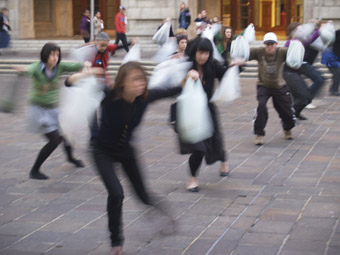
FOR HUNDREDS OF PEOPLE AROUND THE WORLD, TANK MAN TANGO: A TIANANMEN MEMORIAL (2009) WAS NOT SIMPLY ART, AN EXHIBIT, BUT A DANCE THEY LEARNED TO MAKE THEIR OWN, TO SHARE AND PERFORM COLLECTIVELY AS PROTEST, OR AS VIGIL, FROM INSTRUCTIONS ON YOUTUBE IN ENGLISH, CANTONESE, GERMAN AND MANDARIN. THE PROJECT GAVE NEW MEANING, DIMENSIONS AND FORM TO THE NOTION OF PUBLIC ART AND THE POSSIBILITIES FOR PROTEST.
Sydney-based artist Deborah Kelly recently won the inaugural James Cook University Screengrab New Media Art Award for Tank Man Tango: A Tiananmen Memorial. It has been shortlisted for the Sadler’s Wells Global Dance Contest, London, to be awarded by popular vote in November. The work featured in Kelly’s solo show at Adelaide’s CACSA (June 12-July 19), at Serial Space’s 649 (June 4-14) and at Screengrab (p23).
Kelly describes Tank Man Tango as “a monument, a memorial, on the 20th anniversary of the Tiananmen Square massacre, built of dancing bodies.” She is very specific about her intentions: “it’s for those who would remember; to give it shape, duration, experience and ritual. Against forced amnesia, it remembers the protests, and the murdered protestors, through that one person, the symbolic tank man. The work pays homage to courage, to fighting tyranny: and god knows, all our governments are bad. It hopes to bring life to history—our lives, and our history. Dancing this memorial is a way to be, to act, in a city or a town, to make a public sphere, to be an agent in it.”
The geographical distribution of the work is impressive. Kelly writes that “[Tank Man Tango] was made on June 4 in Perth, Brisbane, Sydney, Warrnambool, Daylesford, Hobart, Leipzig, Weimar, Bielefeld, Erfurt, Singapore, Mexico City, Melbourne, St Catharines in Ontario, Philadelphia, Auckland, Dunkerque, Belgrade, Athens, Richmond in Virginia, Bristol and in three different parts of Brussels. And maybe other places.”
Kelly had to accept that Tank Man Tango would develop a life of its own in other hands, some with different intentions: “I love that people accepted it as a gift—no, as their right. Many didn’t let me know they were doing it, many didn’t know an artist, or even a person, had made it. Many I have found by sleuthing—some had intentions very different to mine. Some strangers did it somewhere in the US and subtitled it Dancing on the Grave of Maoist Atheism (Jesus!). In Athens, the artists who took it up there seemed to frame it in an understanding that the protestors of Tiananmen Square were demanding capitalism. I realise I undermine my own will for the work by releasing it so freely that people can and have filled it with their own meaning. But that makes it all the more interesting to me; the work’s own disseminated autonomy means I get to understand it newly, over and over.”
If many people made Tank Man Tango by performing it, Kelly also pays tribute to those other makers, the many who helped her realise this unfunded project before it was even danced: Teik-Kim Pok who “taught the steps of the dance Jane McKernan choreographed”, Sumugan Sivanesan who “made the videos in all the languages” and many other contributors who provided space and equipment, translation, dramaturgy, institutional support, live streaming and those who acted as dance leaders. The thank you list reads like credits for a movie, a reminder of the scale of this dispersed, collective project. RT
–
Tank Man Tango, Deborah Kelly, June 4, www.forget2forget.net
RealTime issue #93 Oct-Nov 2009 pg. 2-3
© RealTime; for permission to reproduce apply to realtime@realtimearts.net
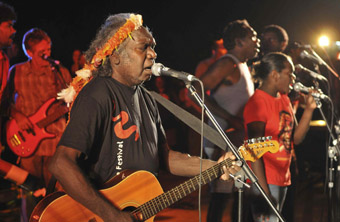
Mandawuy Yunupingu and Yothu Yindi Band, Garma Festival
courtesy Yothu Yindi Foundation
Mandawuy Yunupingu and Yothu Yindi Band, Garma Festival
PEOPLE WHO’VE BEEN TO THE FESTIVAL OFTEN REPORT HAVING A ‘GARMA MOMENT.’ NOW IN ITS 11TH YEAR, THIS EVENT ON YOLGNU LAND AT GULKULA—CLOSE TO YIRRKALA, NUMBULWUY AND THE MINING TOWN OF GOVE—BRINGS TOGETHER UP TO 2,000 PEOPLE IN TENTS AND ENDLESS FOOD OR SHOWER QUEUES, THERE FOR INDIGENOUS CULTURAL TOURISM OR BECAUSE SOME ASPECT OF THEIR LIFE INVOLVES INDIGENOUS MATTERS OF THE MOMENT.
In the latter case, they may be invited by the Yothu Yindi Foundation to contribute to the three-day forum at the heart of the event. As you may imagine, it’s such a rush of experiences, it’s significant when one stands out.
For me, that happened on a quiet backtrack leading from an open-air art gallery to a peaceful point where the escarpment drops suddenly away towards the distant Gulf of Carpentaria. Out of nowhere, eight local kids were walking towards me doing it all—yidaki (didjeridu), clap sticks, song and even some dance. This is something that gets turned on nightly for visitors on the huge ‘bunggul’ oval—traditional dances kicking sand up into the evening air accompanied by frenzied commentary. But here I was privileged to experience transmission of culture through the generations—itself a sub-purpose of the festival—quite spontaneously.
For Robyn Archer, there to make a keynote speech at the forum and to participate in Reconciliation Australia meetings, it was an experience which she delightedly described as “a blow job” from a senior Yolgnu man. She sat in the sand before him and his mighty yidaki, which she was told to place against her chest. He blew, all but sending her flying. And, as her body recovered equilibirium, she realised that the asthma that had been with her since arriving in Arnhemland, had magically cleared.
Earlier, Archer had given us the word of the festival—“detritus.” In her definition, this is “what’s left over after the creation process; ie the product, which shouldn’t be thought of as the end-product. For creative work is a continuum. And the best way to keep working usefully is to think of that product as detritus—for sale or review. The latter’s not a judgment; an artist takes what’s necessary from reviews, and keeps developing. An artist who doesn’t grow, doesn’t try new projects, or investigate new markets with each new work, is the equivalent of a cover band!”
To the Yolgnu in the audience, this was coals to Newcastle. For, of course, their ‘art’ had originally only been valuable to the extent that it performed a role in ceremony, after which it literally became detritus. Even since we gave them reason to achieve permanence in their painting, an Emily Kngwarreye could say “That’s pretty” about an eight-metre canvas, and leave it to the white art system to turn into ‘green’ ($100) notes—for she despised all inferior yellow or orange ones!
Emily had what we’d call an ephemeral attitude to her painting. But Robyn Archer worried, “We don’t protect ephemera in Australia. Our laws derive from the squattocracy, who fenced things and owned them. For them a book had a physical form they could respect; an idea or Indigenous culture has no physical form, no hierarchy, no celebrity.” It’s “ars nullius.”
But it’s there that the squattocracy, the last two Federal Governments and possibly even Robyn Archer are wrong. She bravely issued the battle cry, “The [Prime Minister’s] 2020 [Summit] get-together revealed a white search for a central role for the arts in ordinary life. Why not look at the Indigenous example?” We’re surely in danger here of confusing the ephemerality of the Indigenous arts and the absolute centrality of Indigenous culture.
Their culture’s physical form was stated simply enough by the use of the word “dig”, with all its earthy associations, by the siblings at the head of this year’s Garma—Mandawuy and Gulumbu Yunupingu. “Our past is what makes us tick”, said Mandawuy in a welcoming speech; “We must dig out the Yolgnu experience from the past to pass on to Australia today. Song, dance and painting is the vehicle for us to do that.” Gulumbu, the painter proffered, “People should listen to my paintings—dig in, they’re full of stories.”
This was the ur-text from Aborigines at the Forum—whether from Arnhemland, the Kimberley, the Desert or wherever. Everything comes from the land. “Art is what our ancestors left in this country”, declared Djambawa Marawili, clan leader and one of four Aboriginal artists at this year’s Moscow Biennale; “those patterns and designs, the culture and the names.” From the 1930s, he explained, illiterate Yolgnu had used art as “the only way of listing our country.” When the miners turned up to dig bauxite, the Yolgnu believed that their land was all documented in their paintings; something acknowledged by the courts, which then applied our law of terra nullius, and gave the land away.
In fact, it was only when Marawili pulled all the Yolgnu clans together to paint their Saltwater Country in detail, following a terrible desecration by crocodile hunters, that the essential link between land, culture and art was accepted by the courts. In the Blue Mud Bay decision, the Yolgnu gained 80% title to the intertidal zone. Their 2008 festival had celebrated that with a glorious sacred crocodile and fire dance.
But we give with one hand and take with the other. This year’s forum endlessly argued that the culture lay not where the Northern Territory and Federal Governments wanted it to be—in 20 designated townships across the Territory—but in the Homelands that are often remote from easily deliverable services. Waturr Gumana was scathing: “All our names and our arts come from nature in Arnhemland; it’s a stupid idea to take us away from that. And in the end, our bones have to be buried in our own estate.” Barayuwa Munungurr concurred, “You just can’t teach our culture in the wrong place—you’ll end up with the wrong songlines, the wrong kinships. And you can’t teach in the towns anyway—young people are so distracted by the crowding they don’t listen to their elders.”
And returning to Djambawa Marawili for a concept that even Minister Macklin might understand: “Walking in the fresh wind along the beaches of my homeland gives me strength.” So it was a great pity that the Minister flew all that way for a photo-op at Australia’s first Indigenous life-saving club, then turned her back on the forum, where she’d been scheduled to speak. Professor Marcia Langton did the same. It was widely assumed that their noses were put out of joint by local big man, Galarrwuy Yunupingu’s decision to turn against the Intervention, which he sees as causing change from a position of Indigenous weakness. For him the Yolgnu roots in the land from which all else flows are a source of strength.
Much else that the white side of the Indigenous Creative Industries considered important was also mentioned in dispatches, from philanthropy with an Aboriginal slant to resale royalties for visual artists; from the negligible policing powers behind the Code of Conduct for art dealers to a daring proposal for a National Indigenous Cultural Authority. Famous figures like Rhoda Roberts, Archie Roach, Wesley Enoch and Ursula Yovich popped up. Jack Thompson, as ever, was there. And Peter Garrett spoke good sense about “controlling the reception of indigenous art” and may even have gone home realising that his oddly mixed Ministry of Environment and the Arts is already an Indigenous concept; but he resisted the opportunity to sing. Mandawuy Yunupingu spoke and pulled Yothu Yindi out of retirement to sing a new Healing Place Song to the biggest gathering of the festival, telling us sadly how kidney dialysis plays a far larger part in his life today than touring with the band.
But none of that seemed worthy of debate beside the matter that Northern Territory Aborigines clearly cared about most intensely, their Homelands. That concern did afterwards lead to a three-man delegation armed with 27,000 signatures via Get Up getting to see Jenny Macklin in Canberra. On that occasion, delegation leader Barayuwa Munungurr summed up the importance of Homelands as “the place where we can live on the land that makes us who we are.”
Garma Festival, 2009, North East Arnhemland, Aug 7-11.
Jeremy Eccles was a speaker on a Garma Key Forum panel on “How well does the industry manage ethics and intellectual property rights” with Terry Janke, Lydia Miller, John Oster, Robert Collins and chair Damien Carrick.
RealTime issue #93 Oct-Nov 2009 pg. 4
© Jeremy Eccles; for permission to reproduce apply to realtime@realtimearts.net
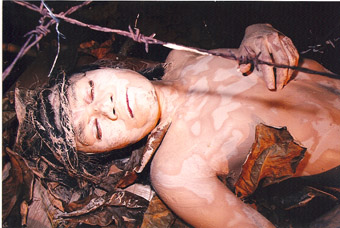
Bandung-based artist Kuncoro from JAKER, an underground art network ‘performing suffering’ at a community protest, Lampung, Sumatra Dec 2000
THE PAST IS A PERFORMANCE IN THE NOW (AND HISTORY THE STRUGGLE OF MEMORY AGAINST FORGETTING). THE PERFORMANCE WORK OF CONTEMPORARY INDONESIAN ARTISTS REQUIRES A TIGHT GRASP ON THE PAST, AND A LOOSE SENSE OF THE TERM ‘INDONESIA’ TO ALLOW FOR CENTURIES OF COLONISATION, CONFLICT AND CONTRADICTION. IN LIEU OF BEING ABLE TO TRAVEL BACK IN TIME, THE FOLLOWING OFFERS A FRAGMENTARY AND ANECDOTAL CHART OF WHERE CONTEMPORARY ‘INDONESIAN’ PERFORMANCE PRACTICE MAY BE RESIDING AND/OR HIDING.
In December last year I decided to ‘pulang kampung’, and journey back to the island of Java to gain a fresh understanding of performance and contemporary arts practice in this newly ‘democratic’ country. It has been 11 years since the overthrow of the dictator Suharto and less than a year since his death, a day celebrated by many of the country’s 220 million people. I embark armed with barely three weeks and a familiar wary sense of the Indonesian culture of jam karet (where time is relative to the elastic length of a piece of string).
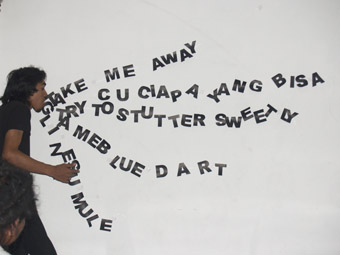
Mukmin Soge Ahmad (Indonesia) performing at Birds Migration Dec 2006, National Gallery, Jakarta
Yogyakarta is a good place to start and I am fortunate to land myself in the close-knit quarters of Nitipuranm an area populated by many artists, both foreign and local. I am given the directions to find Fitri Setyaningsih who lives not far from my friend Hestu. He draws me a map marking out along the way Sangkring (an artist-run gallery) and Rumah Panggung (a performance/rehearsal space). It should be straightforward except that there are two houses on the same street with the same number—urban planning in Indonesia is not well known for adhering to any system of order, least of all an order of numbers.
When I finally arrive at Fitri’s house I am greeted by seven dogs, all barking furiously, and all appearing to share a genetic line descending from the Alaskan Malamute. For a tropical climate and a predominantly Muslim nation, this is most unusual—though it is in keeping with the quietly unorthodox Fitri Setyaningsih. A contemporary dancer with a background in classical Javanese movement, Fitri works with objects and collaborates with a writer, Afrizal Malna, named in 2008 as Writer of the Year by Jakarta’s equivalent to Time Magazine.
Over cups of sweet Javanese tea, our conversation travels around the edges of contemporary performance culture in Indonesia, and finally settles on the situation for collective devising across art forms. The frustration expressed by Fitri and Afrizal arises from the lack of models for collaboration when working outside conventional art forms. How does a dancer work with a sculptor, a designer or a writer? Where are the local expressions and models for artist residencies and art form development and dramaturgy for contemporary performance practice emerging? Afrizal’s performance texts seem naturally to have inhered alongside the development of Fitri’s spatial performance idioms, more easily since they are also partnered off stage. Models for artform boundary crossing appear to have been more readily pursued in underground quarters where a rejection of the canon fused with a rejection of the new world order, catalysing a growth in ‘happening art’, ‘seni pertunjukan’, and laying the seed bed for emerging live art discourses.
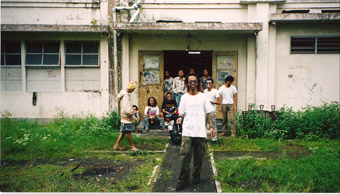
Old Indonesian Institute of the Arts
courtesy Rebecca Conroy
Old Indonesian Institute of the Arts
During my time in the late 1990s and early 2000s researching and squatting in the abandoned ISI (Indonesian Institute of the Arts), ‘performance’ seemed the answer to every occasion whether it was a protest, an art exhibition opening or a dinner party. These occasions blurred the easy lines drawn in the Western world between the estates of theatre, music and art. The common purpose was liberating art-making from the commodifying universe of the art market.
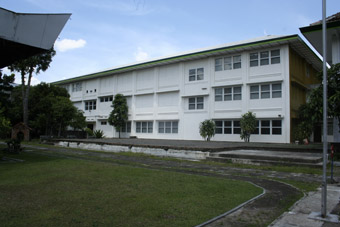
New Indonesian Institute of the Arts
courtesy Rebecca Conroy
New Indonesian Institute of the Arts
Now as I wander through the old squat, newly crowned the Jogja National Museum and run by the fresh Prince Nico (son-in-law to the sultan of Yogya), I am battling a surreal fog. The Prince, in casual slacks and polo shirt, invites me in for a drink to a room upstairs with a large flat screen TV, barely metres from the room that was once my bedroom shared with a number of other dreadlocked, tattooed romantic revolutionaries. The walls once heavily decorated with graffiti and poetry have been sanitised with a fresh coat of white with just one mural remaining in the downstairs lobby, a memorial gesture to a moment in time now reserved for the history books. Prince Nico pours me a Johnny Walker, Red Label. It is barely 11am. Not wanting to offend, and to prove his assumptions about my wild Western ways, I thank him and raise my glass. “To the revolution!”, my fading punk friend Yustoni Volunteero proffers. Typically of course, Toni is rarely serious.
It is a perfect irony that ISI, the once hotbed of radicalism suspected by the Suharto regime, became home to a ragtag collective of artist activists peddling a home-grown version of anarchist community politics, some real life international permaculture action and an uber cool street punk aesthetic which managed to catch the eye of many a visiting foreigner, myself included. They were the days of ‘seni untuk rakyat’ (art for the people). Now it seems that at least in this part of the Yogya art scene, having been bucketed by several waves in the boom crash opera of the international art market, many of my once starving artist friends have been able to purchase houses and, in at least one instance, expensive DJ equipment. The scene may be growing up, or at least their army of small children is.
There is still some nostalgia for the past world, the bit in-between, before the crest of the wave that dumped everyone on this strange new democratic island quickly followed by a succession of failed presidents. But some good things emerged as a result of the three decades of military repression. For one thing it could be said that it gave birth to a contemporary live art scene, spawned from a genetic line of art traced imperfectly from street performance to happening art to performance art to a version of what one could accuse the art institutions of accelerating before its time—Live Art. With ties to the blinded oligarchies of postcolonial fashions, truncated intercultural exchanges and the short-sighted international circuit training of biennales and festivals, Live Art in this country is grafting itself to the domestic scene in rather interesting ways.
When performance took to the streets in 1997 it did so out of a desire to overtly challenge the Suharto regime, which strictly forbade gatherings of people in public spaces that the military interpreted as “spreading hatred against the government.” Political critique had long since silently disappeared into the subtextual lines of the theatre estate, where the plays of WS Rendra, (who recently passed away), Nano Rianatiaro of Teater Koma and the poetry of Widji Thukul (‘disappeared’ in 1998) were frequently banned and their creators arrested. Street performances usually took the form of passionate orations, a ‘performance of suffering’, typically on street corners and most often during a mass mobilisation of students, peasants or factory workers. The script of the performance frequently invoked the hand of justice to intervene in the fate of the ‘wong cilik’ (little people), with frantic gestures demanding the whereabouts of justice or, with eyes averted, intimating the ignorance of the masses suffering under the weight of a brutal regime.
During this period hundreds of performance groups mushroomed, many of them germinated on university campus grounds, developing standard repertoires which they would perform at frequent interludes during mass assemblies of demonstrators. In the years after the events of May 1998, street performance or ‘happening art’ as it was frequently referred to by the underground scene, gathered a critical mass, while performance art, also emerging as a distinct practice within the counter culture gallery scene, started to gain international attention along with artworks of an explicit political flavour.
Three performance art/live art events in the past few years have been driven by persons and groups characteristic of three different threads or streams in the contemporary art scene. Perfurbance [see articles in RT73 & RT79] in its fourth incarnation in April 2008, is nurtured by performance artist Iwan Wijono and the Performance Klub based in Yogyakarta and largely connected internationally through a counter culture scene. Birds Migration in 2006 was an event which had its genesis in the Jakarta and Bandung gallery world and connected heavily to an international scene through the art market. Undisclosed Territory held three times since 2007 exhibits elements of the other two, driven by gallery-based performance and live art practioners but situated in Solo, Central Java, it also has strong links to an international, mainly European circuit of live art, and is directed by well-known performance artists Melati and Suprapto Suryodarmo.
Common to all these streams is the working outwards and against a prevailing domination of artforms aligned to the theatre, dance and visual arts estates in both the traditional and contemporary realm. Distinguishing between them is often harder, although it’s superficially done through geography and the political economy of art scenes. Generally, the further one approaches the centre, the closer one gets a sense of the awkward and imposing influence of the international art world and the gaps in local knowledge and appropriation. The further out one moves, in particular off the island of Java, the deeper one moves towards a more nuanced hybridity grounded less in the desire to ascend the discursive ladder and more in a desire to make meaning out of the everyday contemporary experience and rebuild a critical culture recovering from three decades of the New Order regime.
Along the periphery reside clusters of collective action, enveloped by the surge in DIY aesthetics driven in part by necessity and increasingly by the international style market and disposable cultures aping capitalism’s desire for the surface, including zine culture, easy access to technology and piracy’s easy access to everything else. Artist-led spaces and organisations, such as the internationally fettered and adored Ruangrupa (Jakarta), have for a long time understood the communion and commerce between such things, and pioneered fresh thinking, which has finally infiltrated the Biennale arena. In Yogyakarta, the discursive terrain is similarly taken up through project based groups and collectives such as MES56, Kunci and Taring Padi.
This October more than 30 Australian artists are descending on Yogyakarta for the South Project and in a nearby town, Salatiga, for Festival Mata Air, in the interests of creative exchange and collaboration across artforms. Both of these projects bear witness to the very real and active fascination Australian artists have for our nearest neighbour. Perhaps bound by a common desire for something grounded, live art and creative exchange is paving the way for a common past to be reimagined in the here and now.
Rebecca Conroy visited Yogyakarta in January 2009 on behalf of Performance Space, Sydney, where she works as Associate Director.
RealTime issue #93 Oct-Nov 2009 pg. 5
© Rebecca Conroy; for permission to reproduce apply to realtime@realtimearts.net
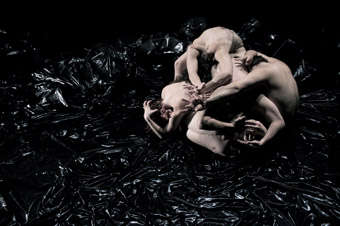
Black Marrow, Chunky Move
photo Alexandra Mein
Black Marrow, Chunky Move
THERE IS A SLICK OF MELTED BLACK PLASTIC SEEPING ONTO THE TARKETT IN THE CHUNKY MOVE STUDIO. ON ONE SIDE, THE WALL IS PLASTERED WITH BROODING IMAGES OF SKULLS, SHADOWY FIGURES AND DESOLATE LANDSCAPES. ON THE OTHER, A CLUSTER OF MOULDED PLASTIC HORSE SKULLS NESTLES AGAINST A PILE OF PLUSH DINOSAURS AND A TWISTED BLACK PLASTIC BACKBONE.
In the middle of this macabre scene, four barely clad dancers toil and sweat, contorting themselves into strange headless unions, sidling, scuttling, lumbering across the floor. French-Belgian choreographer Damien Jalet looks on. Icelandic choreographer Erna Omarsdottir works behind him with the actors Julian Crotti and Paulo Castro, observing them scuffle and clamber clumsily over each other’s back. The disparity in their heights makes for strange couplings; sometimes they are figures from myth or legend, at others they are bar room brawlers. A CD player quietly emits high pitched yips and grunts in Omarsdottir’s voice, mixed with squeaky, squelchy sounds and the noise of wind and water.
I am at a rehearsal for Chunky Move’s Melbourne International Arts Festival production, Black Marrow. Belgian fashion and set designer Alexandra Mein has just arrived with a suitcase full of black plastic and the Australian lighting and sound designers are due to join the team in a few weeks. This commission by Gideon Obarzanek, on sabbatical from making work on his Melbourne based-company, marks yet another left-field move from this unpredictable artistic director.
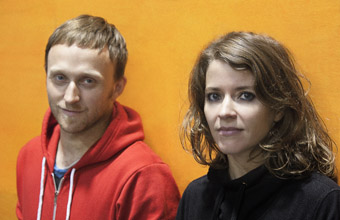
Damien Jalet, Erna Omarsdottir
photo Byron Perry
Damien Jalet, Erna Omarsdottir
Whilst Jalet and Omarsdottir have long been seen on stage together with companies such as Les Ballets C de la B and both have significant independent careers as dance makers, they are a relatively new choreographic team, having made just one film and two full productions together. Obarzanek was impressed by their first piece together Ofaett (Unborn) and the short film The Unclear Age, both created in 2005. He invited them to run a Choreolab professional development workshop at Chunky Move in June 2006. Discussions about a commission began immediately, but the pair’s busy schedules prevented them from even being able to come together to create another work in Europe for three years. In 2009 they created transaquania, a one off performance in Iceland’s blue lagoon for the Iceland Dance Company. The collaborators on this project were visual artists Gabriella Fridriksdottir and Raven, who worked on Ofaett, and Iceland-based Australian composer Ben Frost, who is part of the creative team for Black Marrow and who also composed for Chunky Move’s Glow and Mortal Engine.
“The Icelandic piece is related to this one”, Jalet tells me as we talk during a break in rehearsals. “If you stuck a stick through the Earth, you would connect Iceland and Australia”, Ormasdottir says. ”There is something untamed in both countries. You feel the power of nature, a moving energy, something very overwhelming. Of course there are a lot of differences too. Iceland is a young country. You can feel the earth moving under your feet. Australia is more ancient. But in both countries, people live on the periphery of a desert. The glaciers in Iceland are a kind of desert. It’s humbling. You feel how small you are as a human being. The earth could eat you up any minute. In both countries you can feel the origins of life. A lot of Iceland is a sort of primal soup. Here people still find huge dinosaur fossils scattered across the desert.”
These images of early life are visible in the choreography I observe both in the studio and in archival footage of their previous collaborations. There is a gravitational pull on bodies, a sense of the ground swallowing up limbs and forcing heads downwards, with a constant dragging force. There are a lot of mutant bodies, seemingly in transition from one species to another, sometimes part bird, lizard or fish. Dancers Carlee Mellow and Sara Black writhe together like starfish, all flailing arms and groping feet. “Keep your fingers alive”, mutters Jalet as he watches Black’s arms encircle Mellow’s waist in a parasitical embrace.
“We are exploring a kind of struggle for life”, Jalet says of the choreography. “Sometimes it looks like a primal conflict—deers butting…The bodies are defining themselves.” Alisdair Macindoe and James Shannon are locked in a deathly embrace, their vertebrae jutting as they bend their backs into impossible arcs. The combination of strength and precision required looks exhausting. Jalet and Omarsdottir are impressed by the Australian dancers, praising their hard work and commitment to this new vocabulary. The rehearsal days are long and the lead-up to the premiere at Malthouse’s Merlyn Theatre is unrelenting. Once Mein has started work in her studio, the performers will be creating the choreography in moulded plastic masks and costumes. A close look at the horse skull headpieces she has delivered, suggests the dancers will have to summon all their dedication to create in such suffocating apparel. I ask Omarsdottir whether the actors are contributing anything distinct to the work. She demurs. Whilst the choreographers have worked with Paulo Castro previously, they chose all the performers from auditions and are excited about the expressive range of the group.
We talk about the darkness of the imagery which inspires the production and both choreographers are eloquent in their concerns for the health of the planet. “In the last decade it’s incredible how fast we have destroyed nature. Every generation has this feeling of doom I am sure”, says Jalet, “but we are really sucking all the resources out of the earth. Oil, coal, ash and lava are the blood of the earth with oil at the end of the cycle. There is an energy of death in all of this.” “This is our fantasy of the end”, says Omarsdottir. “We are creating our mythology of apocalypse, our own rituals out of our fears and paranoia.” Whilst this all sounds extremely gloomy, both choreographers insist there is humour in the piece, and poetry. “We are not provoking for the sake of provoking. We are interested in creating something beautiful out of this horror, maybe not aesthetic, but beautiful in its own way.”
The way the artists finish each other’s sentences testifies to the bond they recognised as soon as they began to work together. “We are like brother and sister”, says Jalet. “We started to work on the material for this piece during Foi [a 2003 production by Les Ballets C de la B].” They share a highly theatrical and coherent vision for the work, which even in rehearsal focuses intensely upon visual detail. Omarsdottir has worked with artist Matthew Barney and fellow Icelander Björk. Jalet has worked with fashion photographer Nick Knight and designer Bernhard Willhelm. Despite these red hot collaborations, I suggest to the artists that their virtuosic work must leave them somewhere on the margins of contemporary trends in dance in Europe. “There are lots of taboos in dance it seems”, says Jalet, “People are less scared of feeling in music and visual arts. But we think that physical engagement is very important. Work can be conceptual and smart and physically and emotionally engaging. I like to be taken to a dark place in order to feel something and return to recognise the things I have all the more strongly.”
What Melbourne audiences will think of the dark place Jalet and Omarsdottir are taking them to remains to be seen, but from the moment the curtain rises on the post-apocalyptic setting of Black Marrow to the moment it falls upon the tangled bodies of the performers there will be no escape.
–
Melbourne International Arts Festival, Chunky Move, Black Marrow, CUB Malthouse, Melbourne, Oct 20-24
RealTime issue #93 Oct-Nov 2009 pg. 6
© Sophie Travers; for permission to reproduce apply to realtime@realtimearts.net
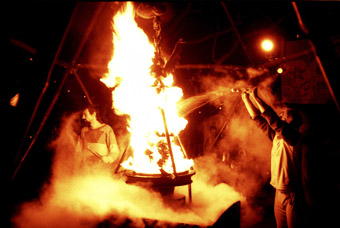
ACME/Splinters, Faust – The Heat of Knowledge, 1996
photo ‘pling
ACME/Splinters, Faust – The Heat of Knowledge, 1996
“YOU CAN’T HAVE THE WILDLIFE WITHOUT THE JUNGLE”, SAID BRUCE KELLER. FOR A FEW DAZZLING YEARS IN THE 1990s MANY EYES IN THE AUSTRALIAN THEATRE, DANCE AND PERFORMANCE WORLDS WERE TURNING TO CANBERRA.
The centre of attention was a brash young company called Splinters, recommended to us at The Performance Space by the late Bruce Keller who had been working in Canberra with theatre-in-education company Jigsaw. In 1992 I quit my plum PS job with no promise of anything other than a chance to be a part of the dark magic this company was to weave in Cathedral of Flesh at the Adelaide Fringe Festival.
That landmark work, voted Best Promenade Theatre of the 1992 Festival (mainstream as well as Fringe) by the notoriously prickly Adelaide Advertiser critics, marked the arrival of Splinters to a position of eminence and influence on the national scene. It was during one of these performances that a member of the audience was heard to exclaim, “How can something like this come from Canberra?” to which another replied, “It’s like this because it’s from Canberra!”
What I found in Canberra was an artistic landscape unlike anything I had imagined. Everyone knew each other and went to the same places and saw each other’s work: a real of sense artistic community impossible in as large and diverse a city as Sydney. As well as Splinters, there were three professional performing arts troupes the equal in their fields of any in the country: the Meryl Tankard Company, Kailash Dance and Skylark Puppet Theatre, as well as a thriving milieu of smaller companies and individual artists whose work was respected nationally. Most importantly, there was a real sense of engagement with and by the wider community. These companies and artists really mattered to a lot of people, and people mattered to them.
Yet by 1998 these companies were gone, and nothing remotely approaching their stature has ever arisen to take their place. Canberra is nowadays very well-ordered artistically, full of well-appointed arts facilities, attended by well-mannered patrons. There is some fine work being made, but the creative community that made Canberra for a few years the engine room of cutting edge work has dispersed, perhaps forever.
There are serious questions to be asked and there are lessons to be learned. In the intervening years, having given up my part in such doings, I have often wondered if what occurred was a unique product of the combination of people, place and time, or whether there is a deeper knowledge to be drawn out and used by others. If anything, in our lives as artists we have posed more questions than any of us can any longer make use of. At some point we have to answer to ourselves.
It is the loss of such artistic power that makes it important to examine why and how Canberra gave rise to such a flourishing: what were the conditions that supported it? Could such conditions be created again? And the dark side: where has this power gone? What has changed that might prevent it arising again? In a second RealTime article to follow, I will argue that while there were unique factors that made that period so brilliant, the prevalent structure of arts bureaucracies and peer-assessment funding has reached a stage of institutional sclerosis where it stifles the very thing it is supposed to support. Finally I will explore what has occurred in Canberra more recently and what prospects there are for the future.
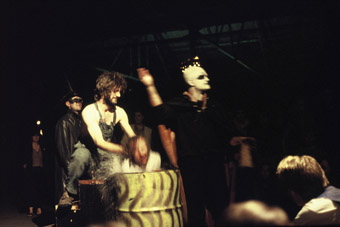
Ross Cameron, Stewart Vaskess, Anne-Marie Sinclair, Patrick Troy, Flowers of Gold, Bezerkii Carnival, Old Kingston Bus Depot, Canberra (1993)
photo Katherine Pepper
Ross Cameron, Stewart Vaskess, Anne-Marie Sinclair, Patrick Troy, Flowers of Gold, Bezerkii Carnival, Old Kingston Bus Depot, Canberra (1993)
It’s impossible to convey in a few words what Splinters was about, or to capture the essence of its many performances. In its heyday the company became known as Splinters Theatre of Spectacle, which highlights its trademark—seducing and overwhelming the audience through bravado, trickery, enticement and sheer audio-visual power. Examples: over the three nights of Guardians of the Concourse, commissioned by Robyn Archer for the 1993 National Festival of Australian Theatre, an army of marshalls wearing yellow raincoats and armed with light wands rounded up some 10-15,000 shoppers and passersby who ended up having huge gouts of flame shot over their heads from a giant motorised flamethrower, the Triclops. The effect was so powerful that the ACT Government was moved to install a commemorative monument several years later. Even more astonishing was the idea that Splinters could be commissioned with $20,000 to produce a one-off work in front of an audience of many thousands at that most bogan of events, the Summernats National Street Machine Exhibition, just a few months before being invited to produce a work for the opening of the 1994 exhibition 25 Years of Performance Art in Australia in the rarefied air of Sydney’s Ivan Dougherty Gallery.
Splinters’ work was underpinned by a distinctive open-ended theoretical framework that drew on the theatre of Grotowski, Artaud and Peter Brook, which led to the evolution of the company as a vehicle for immersive experience both for performer and audience. Even in its heyday, however, the massive major works were interspersed with performance in an intimate mode informed by the visual arts tradition. Several key members of Splinters were trained at the Canberra School of Art, where the presence of artist-performers such as Gordon Bull and the late Neil Roberts encouraged the crossing of genre boundaries and fostered the notion that all and any modes of creative expression could be used to create theatre.
The company was formed in 1985 by a group of former school friends David Branson, Patrick Troy, John Utans and Ross Cameron, with the aim of creating site-specific performance. I like to think of them as young Dragons, that being the Chinese year in which they were born, archetypally the sign of the free spirit: energetic, gifted, magnetic and full of grand plans. Troy, the principal writer and a key performer, says that the original inspiration came from their history teacher at high school who directed the creation of a Roman Carnival day for the whole school. The idea that a large group could be simultaneously audience and performers took hold.
To trace the environment of the time, I shared a few beers with the formidable Joe Woodward. Woodward has for many years refused to have anything to do with the arts establishment, preferring to teach drama in schools and run his own unfunded and uncompromising Artaud-flavoured company, Shadowhouse PITS. In 1981 Woodward and David Bates founded PITS (Pie In The Sky), a cabaret theatre-restaurant at the Canberra Rex Hotel, producing commercially-oriented shows to subsidise their experimental work. The Rex, of course, is famous for hosting visiting politicians and dignitaries such as US President Lyndon Johnson and then Vice-President George Bush Snr. The hotel is also notorious for the regular trysts many famous politicians had there, taking full advantage of Canberra’s thriving and later legalised sex trade, which PITS explored in George’s Peepshow, one of several productions that earned the company regular threats and abuse. PITS was a magnet for the likes of Troy and Branson, who Woodward remembers sneaking in to see shows while still under legal age.
Prior to this, the amazing Carol Woodrow had founded Canberra Youth Theatre in the early 1970s, Reid House Theatre Workshop, Jigsaw and then Fools’ Gallery, a touring vehicle for powerful feminist theatre in the mid 1980s that produced a number of significant theatre practitioners. These companies fostered local talent and brought many young theatre workers to Canberra, including physical theatre maestro Stephen Champion and Renald Navilly, both of whom later collaborated significantly with Splinters.
Alongside these are names from before my time, like performance groups Grotesqui Monkey Choir and Red Weather, and Don Asker’s Human Veins Dance Theatre, later to become Meryl Tankard’s company. These companies (I am told) produced distinctive, visceral and intelligent work. The intellectual aspect of the Canberra scene is perhaps epitomised by Boris Kelly and Monica Barone’s People Next Door, which also worked extensively with Neil Roberts to explore the boundaries between the visual arts and theatrical traditions. Barone had started out in Canberra Youth Theatre, as had Roland Manderson who later directed the company 1991-97 and was director of the Festival of Contemporary Arts in 1999.
In those carefree days when artists could live on the dole with the tacit blessing of the CES, public liability was a term perhaps used to describe a former lover, and economic rationalism was a demon child festering in John Howard’s basement, great things were being made in Canberra and elsewhere which spoke to the broader community. Where did it go and how can we work to make it happen again?
Gavin Findlay worked for many years as a professional musician and administrator (Tasmanian Symphony Orchestra, The Performance Space, Splinters, Australian Choreographic Centre, Canberra Youth Music) before he grew up and got a proper job, which he kinda regrets.
RealTime issue #93 Oct-Nov 2009 pg. 8
© Gavin Findlay; for permission to reproduce apply to realtime@realtimearts.net
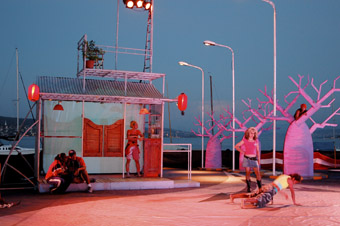
Burning Dayight in Zurich 2007, Marrugeku
photo Christian Altorfer
Burning Dayight in Zurich 2007, Marrugeku
BURNING DAYLIGHT, A MAJOR DANCE THEATRE WORK FROM INTERCULTURAL PERFORMANCE COMPANY MARRUGEKU, HAS HAD A VERY LONG GESTATION, INCLUDING A COUPLE OF PREMATURE APPEARANCES, OR “AVANT PREMIERES”, AS ARTISTIC DIRECTOR RACHAEL SWAIN CALLS THEM, ALONGSIDE HER OWN VENTURE INTO MOTHERHOOD AND THE DEVELOPMENT OF NEW WORKS—FOR BOTH MARRUGEKU AND STALKER, OF WHICH SWAIN IS ALSO AN ARTISTIC DIRECTOR.
Not surprisingly, when I phone Swain, she describes her current state as “crazy.” 2009 has been a year of working “on the floor”, she explains, while “2008 was at the desk”, organising tours and doing preparatory work for 2009. “That’s how it works now”, Swain declares with just a hint of ambivalence, “some years on the floor, some not.” This is not surprising given the scale and international ambitions of her productions.
Burning Daylight will achieve its apotheosis in Broome in late October and then tour to Perth, Melbourne, Sydney and Hobart in November. Before that Swain is developing Shanghai Lady Killer for Stalker, with film director Tony Ayres among her collaborators, and pulling off Marrugeku’s first International Indigenous Choreographic Workshop in partnership with Sydney’s Critical Path choreographic laboratory.
Swain established the Marrugeku Company in 1994 with the particular aim of engaging with both Australian Indigenous culture and an enlarged vision of performance entailing dance and multimedia. Mimi (1996) and then Crying Baby (2001) were developed with traditional Aboriginal communities in the Northern Territory and successfully performed there, around Australia and overseas. For Stalker, Swain directed Incognita (2003) and was commissioned by the European Capital of Culture to create Sugar, an intercultural dance project, in the cities of Marseilles and Liverpool in 2006-07.
Since I saw an early work-in-progess version of Burning Daylight in 2005, the work has had two more developments in Broome, including the shooting of three short films (by Warwick Thornton, director of Samson and Delilah), which are integrated into the work. An ‘avant premiere’ was staged for the 2006 Shinju Matsuri Festival in Broome and a documentary on the making of the work was screened on ABC TV. Burning Daylight would have been fully realised earlier than late 2009, says Swain, but for a shift in funding timelines in WA and the collapse of plans to tour Europe in 2007. Nonetheless, it was performed in the ‘avant premiere’ version at the last of Maria Magdalena Schwaeggerman’s Zurich Theatre Spektakls where it was well received. The final realisation of the work has been aided by the West Australian Government’s Department of Culture and the Arts’ new Major Production Fund, Ignite.
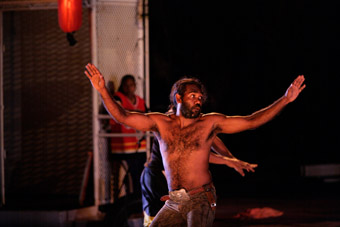
Trevor Jamieson, Burning Dayight in Broome, Marrugeku
photo Rod Hartvigsen
Trevor Jamieson, Burning Dayight in Broome, Marrugeku
Swain describes Burning Daylight as having three main stories. “Set outside a karaoke bar the show reflects the first story, the contemporary reality of the young in Broome, late night Thursday or Friday or Saturday on the streets. The karaoke video screen reveals a second story, the history of the town, with the onstage characters portraying their grandparents—a world of the White Australia Policy and forced removals.” The third story, she says, “emerges between street and screen…a ghostly present.” She felt this ghostliness as palpable during the development of Burning Daylight in Broome where “the shadow of the testing of a Native Title land claim had a big effect on the community, and on the storytelling and dance in the show. It meant that we were not allowed to work with the traditional stories of the Indigenous community. So, the ghosts came out, an implicit dialogue about what haunts Indigenous people when land and story are lost.” She says this can be felt strongly when Trevor Jamieson and Yumi Umiumare perform the Ikebana Tango while the screen reveals their grandparent lovers: a stockman and a geisha (Japanese pearl divers have played a significant part in Broome’s history).
Swain says that alongside modern Broome, Burning Daylight evokes the older town, once regarded as “an Asian wild west”, and characterises Thornton’s contributions as “karaoke noodle western videos.” The contemporary aspect will be heightened with music by MC Dazastah of Perth-based hip hop crew Downsyde. As well as Trevor Jamieson (of Ngapartji Ngapartji) and butoh dance performer Yumi Umiumare, the cast includes Sydney dancer Kathy Cogill, Sermsah Bin Saad (Suri), a So You Think You Can Dance finalist, and Broome-born dancer Antonia Djiagween.
Compared with its antecedents, Burning Daylight has become, like Broome itself, a more cosmopolitan mix of collaborating artists. I asked Swain how this came about. After the tours of Mimi and Crying Baby, Swain explained, she found herself wondering about European expectations of Aboriginal dance, particularly in northern Europe where there was “a lot of hype around traditional dance. I wanted to make something more playful and diverse, to say, ‘this is contemporary aboriginality, cosmopolitan and global, but with a deep connection to the land’.” To break from stylistic constraints, Swain invited West African artist Serge Amié Coulibaly (founder and Artistic Director of Faso Danse Theatre, based in Ouagadougou, Burkina Faso and a collaborator with Belgium’s Les Ballets C de la B) to “workshop a new way for Marrugeku”, with what was essentially a new company in a different community, Broome, “to join the dots between Aboriginal dance and contemporary performance.” It was an opportunity “to reconceive the intercultural process. It took Dalisa Pigram and I two years just to get our heads around the piece and how to realise it in the much more hybrid context of Broome. It took a long time and was like learning a whole new language. It felt like a beginning, a new beginning for Marrugeku.” Pigram, a performer and founding member of Marrugeku comes from the Yawuru people of the Kimberley, and is co-choreographer of Burning Daylight with Coulibaly.
In RealTime 92, Bangarra Dance Theatre’s director Stephen Page asked where were the other dance opportunities for Indigenous artists outside his company. Marrugeku is addressing the issue in several ways: in its own productions, through a dance laboratory and in a training workshop for 10-20 year olds culminating in a production, Buru. The International Indigenous Choreographic Laboratory is a three-year project that Swain considers a logical extension of Burning Daylight. Curated by Swain and Pigram it’s inspired by an “empowering West African-European model that embodies resonance and difference.” Serge Amié Coulibaly will lead the first workshop in October, which includes Indigenous Australian and Maori participants.
Buru will be a new Marrugeku production in 2010 coming out of training workshops for 10-20 year old Indigenous participants gathering across their school holidays. There’s also a solo work for Dalisa Pigram in development and Swain is hoping a new Marrugeku work for adults might emerge from this year’s Choreolab to be worked on in 2010.
As for Burning Daylight after its Australian tour, Swain says, “It’s difficult to know in a global economic recession. US festivals are keen but often don’t know their budgets until very late.” In the meantime, development and diversification are firmly on the agenda. She welcomes the prospect of having a smaller work like Pigram’s in development, given “the enormous amount of time and the expense of working in remote communities on the big projects. We need a broader portfolio.”
Swain’s personal life, sometimes “a big juggling act”, she says, but inseparable from her art, has changed significantly since the earliest incarnation of Burning Daylight. Two weeks before the first ‘avant premiere’ of the show she gave birth to a daughter, Jade Jet, who arrived on schedule and, four days later, Swain was back in rehearsal. Resonating with the show’s local culture cosmopolitanism, the child’s grandfather, of Chinese descent, was born in Broome and her great grandfather had lived there too.
Marrugeku, Burning Daylight, Mobile States tour: Goolarri Outdoor Venue, Broome, Oct 28-31; PICA, Russell Square, Northbridge, Perth, Nov 4-7; CarriageWorks, Sydney, Nov 11-14; Arts House, Meat Market, Melbourne, Nov 18-21; Princes Wharf, Hobart, Nov 25-28; Performing Lines, www.performinglineswa.org.au
RealTime issue #93 Oct-Nov 2009 pg. 10
© Keith Gallasch; for permission to reproduce apply to realtime@realtimearts.net
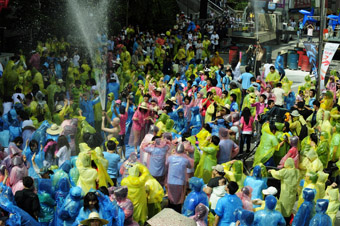
Opening Ceremony
photo courtesy Chuncheon International Mime Festival
Opening Ceremony
THE VERY EXISTENCE OF THE CHUNCHEON INTERNATIONAL MIME FESTIVAL AND ITS HUNDREDS OF PARTICIPANT PERFORMERS, MOSTLY FROM ACROSS EASTERN ASIA, IS AMPLE IF SURPRISING EVIDENCE (TO AN AUSTRALIAN LIKE ME) THAT MIME IS STILL ALIVE AND WELL. BUT ALTHOUGH THERE WERE EXAMPLES OF THE FINE ART FROM MARCEL MARCEAU-TRAINED EXPONENTS, HYBRIDITY ABOUNDED—MIMES WORKING WITH MAGIC, CLOWNING, JUGGLING, DANCE, RITUAL—AND NOT A FEW WORKS SIMPLY PASSED AS FINELY HONED MOVEMENT-BASED CONTEMPORARY PERFORMANCE.
Chuncheon’s mime festival is famous for the many acts that populate the small regional city’s streets for over a week, climaxing in an all-nighter. Unfortunately, the suicide of a beloved former Prime Minister required the cancellation of the street performances and the redirection of visiting performers into workshops. Over four days I managed to experience a variety of work. I had to leave before the all-nighter but with a strong desire to see a complete festival, on the streets, in the near future.
A city of modest size, ringed by high hills and lakes, Chuncheon is a couple of hours north-east of Seoul. The centre of this year’s festival was a small, new shopping plaza, open to the weather and complete with restaurants and cinema. The cinema foyer was the ideal location for Australian artist Jordana Maisie’s magical human scale kaleidoscope, The RealThing, passersby puzzling at and ‘dancing’ to their multiplying refracted selves (RT 87, p33).
A stage at the centre of the plaza was the site for a number of free performances enjoyed by inquisitive families. The highlights in the session I saw were provided by two Japanese artists.
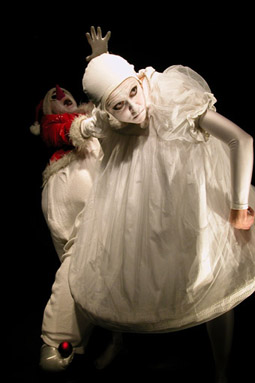
Astronomy for Insects 70, blackSKY white
photo courtesy Chuncheon International Mime Festival
Astronomy for Insects 70, blackSKY white
Jidai’s Witch Clown, a stooped, hooded European medieval character with a very long nose, a big wart to one side, is calculatedly ingratiating, countering her mocking of the audience with moments of comic self-deprecation and an ironic attitude to the art of mime. First, in a facile display of power, she stages a savage battle between her familiars, a pig and a lizard, both toys. She then attempts to fly on her broomstick but it weighs a ton, until a small balloon gives it a short-lived lift. Later, while miming a scary, seductive feminine self she’s shocked to find she has no breasts (Jidai is male) and then loses her nose. The dynamic in the swings between smug condescension and moments of failure and panic is deftly sustained in this half-hour performance.
The other Japanese performer, Chiemi Kyomoto, opens her performance as one of those appalling living statues, seen too often in public places. She’s a silver-masked, puppet-like woman who wears a rose that goes limp, has a hand that falls off and finds herself trapped in another mask beneath the first. Removing it, she then ‘cleans’ the fourth wall and is surprised to see us. Now she transforms into a ballerina-cum-balloon-sculptor, parodically dancing a dying swan while dextrously sculpting a balloon version of the bird. In a third phase, she uses a life-size male dummy to create a wish-fulfilment love story for herself that turns comically bad. Underpinned by mime, dance and modest skills in illusion, Chiemi Kyomoto’s clowning is refreshingly idiosyncratic.
The opening event was on a vastly different scale from these intimate showings, running some three to four hours on a warm Saturday afternoon in front of a new department store on a street adjoining the festival plaza. At one end of the street a female trio from a French aerialist company, Compagnie Retouramont, with the assistance of a huge crane, hoisted themselves on high, engaging in lyrical solo swings and rolls and then interlocking trios to the instruments of the air (recordings of flute, didjeridu, accordion), all very slow motion and low on dynamism, like watching spiders doggedly moving about a web. The tone was about to change at the other end of the street as the crowd swelled. Atop the fully extended ladders of two large fire engines were mythical figures, gods of fire and water (I assumed), wearing large head pieces and flowing robes and issuing roaring challenges and declarations via head microphones.
On the road below was a dancing Japanese performance artist, Oikado Ichiro, who, after discarding his long white robes, ignited a two-metre wide roller which he pulled after him. A gang of young men burst through the crowd with extinguishers and dowsed the flaming roller and then the crowd before heading back to the site worked by the aerialists. There, a tuxedoed conductor directed an orchestra of sweepers and carriers who sloshed the street and shop facades with water, the brooms scratching their way towards the gods on their fire engines.
A surprising addition at this point was the appearance of two giant two-metre-tall baby dolls (created by Hamish Fletcher of Australia’s Men of Steel) who wobbled their way down the huge sheet of an undulating blue plastic ‘river.’ There was no holding back the crowd eager to touch and photograph the babies close-up. Swept into the fray I was saved by a water spray from a fire hose on top of a nearby building and then, from other roof tops, by a shower of hundreds of plastic, yellow, pink and blue raincoats—diverting the crowd from the babies before more water flooded from above. Soon the street was a riot of colour and moisture and fumes.
From an underground carpark an army of young people carrying two long timber rafts, waving banners and pounding drums stormed onto the street. Riding the high rearing rafts in a sustained ritual war of words and provocative moves were the two gods. Then in the late afternoon, the crowd, still excited, danced with the drummers before drifting away. The festival had begun: comic, epic, diverse and participatory.
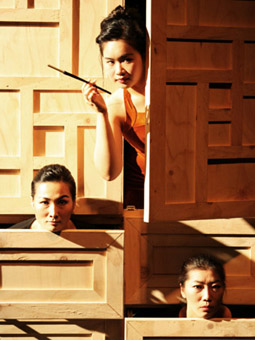
The Maids, Sadari Movement Laboratory
photo courtesy Chuncheon International Mime Festival
The Maids, Sadari Movement Laboratory
The variety in the program’s evening peformances further amplified the sense of the festival’s diversified focus on mime. In the Bomnae Theatre complex, a co-production between Korea’s Sadari Movement Laboratory (their production of Buchner’s Woyzeck is in Adelaide’s 2009 OzAsia Festival) and the Macao Cultural Centre yielded an intriguing rendition of Jean Genet’s The Maids. A cupboard (“a closet that symbolises the space that confines [the maids’] egos”; program note) stands mute centrestage. A drawer slides open, the head of a maid appears; from another drawer, the other maid. Later they open the cupboard doors to reveal Madame, their youthful employer. At one point, they dance beneath her dress, turning her momentarily into the doll-like puppet of their fantasies. Later they undress her to reveal sagging old age. The limited space heightens the play’s already claustrophobic intensity while the truncated appearances of the performers lends them the fatalistic air, for all of their machinations, of manipulated puppets. When one of the maids is locked out of the cupboard the panic is palpable. The performers’ dexterity at working extremely constricted spaces was truly impressive.
Japan’s Imuro Naoki Mime Company, who apparently trained with the late Marcel Marceau, performed Follow the Arrows, a tightly choreographed, whimsical tale of lost opportunities for love, rich in comic coincidence. Simple props—newspapers, arrow shapes—became magical and bodies swirled and tumbled about evoking a great range of locations and states of being. My initial resistance to the sometimes endemic cuteness of this kind of classically informed mime gave way to admiration for the production’s inventiveness and rich sense of humour.
Close to midnight, as I was about to leave the Bonmae Theater, I was whisked into a small, darkened, packed studio to witness a female shaman, elaborately costumed in flowing silks, reeling about, snatching paper money and tugging resisting female associates, while three traditional musicians generated a hypnotic pulse from flute, drum and cymbal. The Seoul Jinogee Gut ritual is apparently an exorcism ritual focused on the relationship between the living and the dead as they are separated and the passage of the dead to the otherworld.
In the second part of the ritual, before a table loaded with fruit and vegetables, the shaman’s associates unfurled a long strand of gauzy material and held it taut at chest height while the shaman pushed, shearing through its length, collecting the paper money resting on it and tucking it into her headband and clothing. She then appeared to ‘become herself’, speaking fluently and distributing the offerings on the table to the audience. A naive witness, I was taken by the raw theatricality, beauty and unpredictability of the ritual.
A contemporary, shaman-inspired performance followed, titled Hyang (Incense). Four musicians established a sonorous percussive hum in the dark while a small, blurred circle of red light danced on high and then down at our feet. A soft stage light revealed the source as a bundle of glowing incense before which sat a woman in prayer. Behind her, emerging from the dark, two hands danced from the wrist with increasing speed and acute articulation only to disappear and be replaced with the soles of two feet that moved with a similarly remarkable if more lyrical fluency. When the performer (revealed to be the festival’s director Jin-Gyu Yu) stood, he and the woman reached for the incense as the stage light cut out. What ensued was an entrancing dance in the dark of expiring incense sticks, long red lines sketched and evaporating across the black as our sense of height and distance dissolved amidst the enveloping music.
A festival highlight was the Moscow-based blackSKYwhite’s Astronomy for Insects 70, a nightmarish epic (only an hour, but in dream time), directed by Dimitri Ariupin. It’s wordless and almost impossible to describe let alone interpret—an episodic, discontinous fantasy (to an apocalyptic surround sound score) framed by 10 tall internally lit columns and a huge mutating door, collectively evoking a temple or sci-fi palace. A woman in a wheelchair managed by two bald, wide-eared giants in squarish white suits is wheeled on. This disabled figure, a recurrent image in the work, is helpless but also vigorously rejects massage and manipulation, especially in a late episode where she turns viciously on an eccentric Santa Claus who has given her legs. In between, among others, there’s a protracted scene with another kind of woundedness, a soldier in a state of psychological and physical dissolution (his weakening legs an elaborate dance of death), the music evocative of early 20th century conflict between Germany and Russia. There’s no literal mime involved, but the evocation of crippled being, physical decay and a recurrent motif of delicate bird-like movement are evidence of advanced skills of mimicry. The London Times aptly wrote of “diabolically pixilated human animation” when the work was presented at the London International Mime Festival.
Australia’s Men of Steel, working on a relatively tiny scale, presented a fantastical, intimate adventure experienced by two ‘puppeteered’ gingerbread men cookie cutters. In encounters by turns vicious and comic, the men grapple with fruit, doughy selves and bloody sprays of tomato sauce, enter a broccoli forest and are Star Trekked into outer space by a portable gas cooker. The company battled bravely with a huge venue, the Chuncheon Puppet Theatre, and restless hordes of the tiniest of tots, but never faltered. Men of Steel, Jordana Maisie and Strange Fruit comprised the Australian component of the festival, part of a larger program of artists, including Snuff Puppets, in Korea in May with the support of the Australia Council for the Arts and with more visits on the way.
A forum in the festival addressed “Activating Critical Writing for Interdisciplinary Arts and Building a Network.” The brainchild of Kyu Choi, the festival’s deputy artistic director, it brought together organisations feeling a need for joint action to raise the level of critical commentary and build audiences for the hybrid arts. Visiting Australia for Time_Place_Space in Brisbane earlier this year, Kyu Choi was taken by RealTime as a possible model for promoting interdisciplinary practices and so invited me to come to Chuncheon to talk about the magazine’s evolution and functioning. Attending the forum were In Ja Im (Marginal Theatre Festival), Sung-Hee Kim (Festival Bom), Baek-Gi Kim (Korea Experimental Arts Festival, run by KoPAS, Korea Performance Art Spirit), Jung-Ja Bae (Physical Theatre Festival), Doo-Eun Choi (Nabi Arts Center, a new media arts organisation with an international, collaborative program), So-Yeon Kim, a theatre and interdisciplinary arts critic (one of the few apparently), and from Arts Council Korea, Hae-Young Jung. Also present were Bo Young Lim from the Australian Embassy, Erik Kuong, Macau’s first independent producer and associate of the Macau City Fringe, and Catherine Lau, administrator of the Hong Kong Fringe Club.
Each of the festival directors spoke about the challenges they faced as their artforms hybridised, audience expectations changed, reviewers failed to connect and works went undocumented. The forum represented a first step in identifying shared needs and discussing the possibility of action. It certainly gave me some insight into the organisations and a desire to see them at work, not least those like Nabi Arts Center and the intriguing Korea Experimental Arts Festival that have Australian connections. The opportunities for exchange, collaboration and co-production have great potential. Thanks to a Chuncheon Mime Festival initiative, Jordana Maisie has been part of the Korea Arts Council-funded Moving Space Project, working on Time Slices with Young-Ah Noh (aerial and physical theatre artist, Korea) and Matthias Erian (sound designer, Austria).
Although I only saw a portion of the 2009 Chuncheon International Mime Festival, I was struck by its intimacy, intensity, inventiveness and collaborative spirit. The festival’s friendly staff and the huge army of amiable, efficient volunteers, many of them arts students from across the country, made the visit additionally pleasurable, as did the town’s relaxed mood, lively markets and new food experiences. Mime is alive and well in this festival, if adapting and evolving and eager for a matching critical responsiveness.
Keith Gallasch was a guest of the Chuncheon International Mime Festival. Thanks especially to Deputy Artistic Director Kyu Choi.
Chuncheon International Mime Festival, Korea, May 24-31, www.mimefestival.com
RealTime issue #93 Oct-Nov 2009 pg.
© Keith Gallasch; for permission to reproduce apply to realtime@realtimearts.net
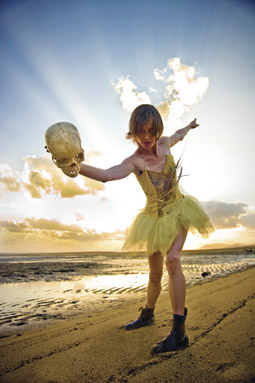
Rebecca Youdell, Bonemap
photo Russell Milledge
Rebecca Youdell, Bonemap
THE 2009 ON EDGE PERFORMANCE FESTIVAL INCLUDED NEW WORKS FROM BONEMAP AND ZANE SAUNDERS, A DANCE EVENT, STREET PERFORMANCES, GALLERY SHOWS, LIQUID ARCHITECTURE AND AN INDUCE WORKSHOP PROGRAM WHICH INCLUDED ARTIST MENTORING, A REALTIME WRITING WORKSHOP AND A WELL-ATTENDED FORUM ON HYBRID ARTS PRACTICES WITH GUEST SPEAKERS DAVID WILLIAMS OF VERSION 1.0, MEDIA ARTIST AND CURATOR JENNY FRASER AND JACKSON CASTIGLIONE OF PERTH’S PVI.
The festival highlight was Cairns performance group Bonemap’s Whispering Limbs, a collaboration with the members of Brisbane-based Polytoxic (Lisa Fa’alafi, Efeso Fa’anana, Leah Shelton) and Aboriginal dancer Earl Rosas who has worked with Chunky Move, Aboriginal Dance Theatre and the Australian Ballet. His was a powerful presence that framed the work, carrying a fish in a large glass bowl on his head, doubtless representing the fragility of our relationship with nature and the Aboriginal guardianship that has been for so long ignored and denied. Other images were ironic: a raincoated trio copiously leaking valuable water; a man dragging a ‘For Sale’ chunk of lawn, which he meagrely waters before giving away a precious slice to a member of the audience; and Rebecca Youdell’s memorable ballet brat in tutu and Blundstones—culture with Australian affront and a bouquet of dead weeds. Moments when all the performers come together are particularly strong and underline the collective power of the work which is reinforced by Russell Milledge’s sweeping diorama projections that reveal the performers in an almost gothic natural world, and by Steven Campbell’s percussive electronic score, mixed live. This was a work I saw twice, admiring its cogency, dynamism and the Bonemap-Polytoxic merger, and hoping Whispering Limbs would have another life beyond the festival.
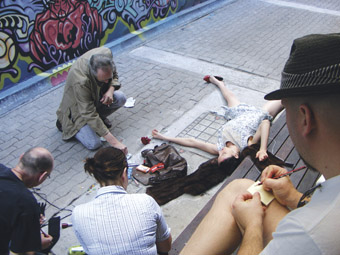
LAPS (Live Art In Public Space)
courtesy On Edge
LAPS (Live Art In Public Space)
One of the midday street performances (LAPS, Live Art in Public Space) was set up like a movie shoot in a narrow lane with two ‘dead bodies’ and potential clues littered about. The audience attached post-it notes to the objects and the bodies, on which they wrote, with a mix of wit and TV-informed savvy, the likely meanings of the forensic evidence.
The other major festival work was local artist Zane Saunders’ performative installation, Blueprint. It was strongly sculptural, as you’d expect of Saunders, presented with a live art informality and included some vigorous dancing as well as delicate moments when Saunders’ quiet presence took centrestage. An evolving work created with extremely limited rehearsal time, Blueprints generated strong if elusive images that spoke even more strongly than Whispering Limbs of the necessary guardianship of the land, in this case by fire management.
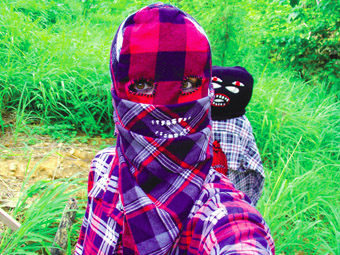
Combat Drag (video still), 2008, Jemima Wyman
images courtesy the artist and Milani Gallery Brisbane 2009.
Combat Drag (video still), 2008, Jemima Wyman
Striking video works by Jemima Wyman were on show at the KickArts gallery, alarming some of the locals (if the guest book was to be believed) with eerie images of masked figures—young men playing ‘terrorists’ in the bush in balaclavas and with sticks for guns, and on another screen sinister glove puppet figures. Victoria Carless wrote about the show in the RealTime writing workshop: “This work disconcerts by skewing the familiar. Cultural symbols, ideas about identity and images of extremism trip over each other” .
Jenny Fraser’s Big Eye Animation program (RT 91, p26) was on show at Mofo Gallery, William Duckworth & Nora Farrell’s (US) wi-fi Media Garden featured at KickArts (when you could connect), and video images from Beth Shorter’s Peripheral impressed at the eccentric Digital is the new Analogue show at Crate59 gallery where Liquid Architecture artists vibrated the corrugated iron roof until rusty fragments fell lightly.
It was a pleasure to experience On Edge, to meet artists we rarely see and to enjoy the intense discussions about the works in the festival and where they fit in the bigger arts picture. The Induce program, organised by Nicholas Mills, formalised and heightened the sense of exchange of ideas and information that comes with a festival. On Edge continues to be an admirable rarity, an Australian festival of contemporary performance and media arts.
Bonemap and The House of Falcon, On Edge, Contemporary Media + Performance, Cairns, July 3-18
RealTime issue #93 Oct-Nov 2009 pg. 14
© Keith Gallasch; for permission to reproduce apply to realtime@realtimearts.net
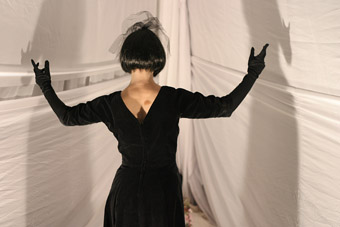
Leaky Heaven
photo Tim Matheson
Leaky Heaven
THIS ARTICLE SHOULD HAVE BEEN A CELEBRATION BUT I FEAR IT WILL BE MORE OF A EULOGY. SHORTLY AFTER WINNING RE-ELECTION IN MAY 2009, THE GOVERNMENT OF BRITISH COLUMBIA SLASHED FUNDS TO THE BC ARTS COUNCIL (BCAC) BY 40%. THEY FOLLOWED THIS UP IN AUGUST BY WITHDRAWING ALL FUNDING TO ARTS AND CULTURAL ORGANISATION DISTRIBUTED THROUGH THE DIRECT ACCESS PROGRAM, WHICH USES REVENUES GENERATED FROM GAMBLING TO SUPPORT GOOD CAUSES. POPULARLY KNOWN AS “GAMING”, ITS CONTRIBUTION TO THE ARTS SECTOR FAR OUTSTRIPPED THE TOTAL BUDGET OF BCAC AND WAS, INDEED, THE LARGEST ARTS FUNDER IN THE PROVINCE.
Saved from the axe were a small percentage of companies with three-year funding commitments, although the Government originally wanted to pull the plug on them as well. The news gets worse: if the government follows through with plans outlined in their recent draft budget, provincial funding for the arts is projected to be down to $2.2 million by 2010/11. $2.2 million for culture in one of the richest provinces in the country, with a population of approximately 4.5 million.
The history of Vancouver theatre is ultimately defined by funding. While this might sound like a self-evident truth, I do believe that the traditionally meagre subsidy and the way it was delivered supported a unique flowering of creativity and risk-taking in Vancouver theatre. This flowering was, I suggest, wholly unexpected given the circumstances—and a credit to the individuals responsible—but like an exotic bloom it was vulnerable to changes in conditions and we may have just seen it pulled up by the roots.
I should be clear. The arts have always been starving in Vancouver. While the city prides itself as being home to the largest percentage of “cultural workers” in the country (it also has the largest homelessness problem, but it’s not clear if those two things are somehow linked), cultural assets have always taken a back seat to parks and community centres. It is a city that prides itself on inclusion rather than excellence and as a consequence has never made the same critical investment in cultural infrastructure that cities such as Montreal and Toronto have. Toronto, for example, made a decision to invest in its theatre infrastructure in the 1970s, a decision still paying dividends not just in the level of activity but also the place that theatre occupies on the cultural landscape. Toronto is a theatre city because a decision was made that it should become one. Indeed, it could be argued that Vancouver lags behind other major Canadian cities, including Calgary. When that city hosted the Olympics in 1988, a new performing arts centre was built. When Vancouver—a city with twice the population—hosts the Olympics (which take place in 2010) not a single cultural asset will have been created.
In Toronto, there is a network of mid-sized theatres able to support and train new and emerging artists through mentorship programs and the sharing of resources and space. There is no equivalent in Vancouver. What is termed ‘independent’ theatre—that is everything below the two major ‘regional’ companies, the Vancouver Playhouse and the Arts Club—are without venues. I would like to stress this: some of the most accomplished, professional theatre companies not just in Vancouver but in Canada do not have dedicated theatre spaces. This includes companies such as Touchstone, The Electric Company, Neworld, Green Thumb, Pi, Boca de Lupo and Ruby Slippers. Not one of them owns or operates a venue. Instead they are forced to compete with one another to rent from a tiny stock of venues, none of which is dedicated to theatre.
I think it’s fair to say that in the public imagination, theatre is associated with specific buildings; buildings that act as reservoirs of memory and provide what I call a sacred space for performance. It doesn’t matter how shabby the conditions, it is a space given over to performance as opposed to any other form of activity. In Vancouver those spaces can and are also used for Pilates and kick-boxing. Indeed, by way of a personal example, in trying to book a space for a theatre event next summer one of the prime locations in the city wasn’t available for the weekends because it was booked for weddings. Monday and Tuesday evenings were free. As Ivan Habel, General Manager of Green Thumb, told me in an interview last year, “We’re so poor in Vancouver that we don’t even realise the level of our poverty.”
So what happens in a city where theatre is almost invisible? Well the most obvious answer is you turn to found locations. Site-specific theatre has become one of the forms for which the city is now most widely recognised. I think it’s fair to say that in reality very few theatre companies explore location as a rigorous part of their process; Radix is the one exception that springs to mind—their work genuinely comes out of the locations they work in—but for most of the others, location is a sort of backdrop to production. Perhaps the best example would be Boca del Lupo who ran an annual summer show in Stanley Park which involved performers abseiling from trees (until a wind storm a couple of years ago laid waste to the trees). Another example is Other Freds, a production created by Only Animal, which took place on Granville Island and used False Creek as a backdrop. Other Freds, like the Boca shows, was not specifically about that particular place and time, rather it was held outdoors and could best be termed adventure theatre. These shows were very popular and the usual justification provided is that this sort of large-scale, outdoor theatre is somehow in tune with the city’s adventurous spirit. While there may be an element of truth to this, in a city where it rains for eight months of the year it seems unlikely that we crave the outdoors as much as we like to pretend.
And this brings me back to funding and the flowering of theatre in unpromising soil. Over the last decade Vancouver has seen an explosion of theatre activity and a proliferation of small and micro theatre companies. Given the lack of infrastructure and the meagre funding available, this may appear baffling. It is my contention that it was actually these very restrictions that caused the proliferation and through this proliferation an explosion of creativity (if not always quality).
On a practical level, with no formalized system of support, emerging theatre artists were left with little choice but to “do it for themselves” and start a company in order to get their work produced. This push to form a company was further compounded by the fact that to qualify for Gaming funding, groups had to formally constitute themselves as non-profit organisations with all the requirements that entails. In other words, what in other cities might have been an informal collective of artists in Vancouver became legal entities. It is also worth noting that there were no artistic standard requirements attached to securing funds through Gaming. To receive the funding you just had to prove certain levels of activity and community engagement. As long as you were doing what you said you would do it didn’t matter if it was any good. This situation was then further compounded when BCAC adopted a policy—perhaps in the face of so many companies requesting funds—of handing out smaller grants to more companies. This ‘scattergun’ approach meant that over the last 10 years Vancouver has been home to dozens of tiny theatre companies all surviving on micro budgets (and hundreds of hours of unpaid labour). Under these conditions, it was quite possible for a micro theatre company to be able, within a couple of years, to legitimately compete with established companies that had 30 years experience.
The downside of this situation: companies were thrown into competition with one another over scarce resources and there was fragmentation within the community. The upside: with no formal mentorship to guide practice and no major funders asking for accountability, Vancouver enjoyed over 10 years of theatre experimentation and risk-taking. When no one really cares, you can pretty much do what you want.
Although many theatre artists in Vancouver would reject this assertion, I do believe that a sort of Vancouver school came out of this period; a school with an aesthetic style very different from the cool sophistication of Toronto. The work had a much more anarchic ‘in the moment’ feel of experimentation that put one in mind more of the visual arts. Often, the work would focus on the experience itself—either in a circus tent (Leaky Heaven), walking through Stanley Park (Boca del Lupo’s summer shows), sitting in your car or wandering through IKEA (in two of Radix’s more famous pieces), being in a warehouse (The Electric Company), a nightclub (Screaming Weenie) or a rave (Upintheair Theatre). Linked to this, the work was often conceptual in nature, for example Theatre Replacement’s Clark and I Somewhere in Conneticut, which was constructed around the idea of performer/co-creator James Long finding a suitcase of photographs (see review). Indeed, it often felt as if Vancouver shows could be reduced to a Hollywood style pitch: drive-in theatre, the show set in the trees, a show based on a suitcase of photos.
And like Hollywood, narrative and storytelling were frequently lost in the service of the visual or the experience. Many of our leading companies have a strong visual style—perhaps most obviously Electric Company, Leaky Heaven and Boca del Lupo. These visuals almost always derive from a mixture of high and low technology. Good examples are Boca’s My Dad, My Dog (see review) which had puppets mixed with projections and anything by the Electric Company (see review). This influence can be seen in the work of companies which are notionally text-based such as Rumble, Touchstone and Ruby Slipper who produce work with a high sense of visual style.
The generation of theatre artists I’m talking about are now in their thirties and forties and have arrived as mid-career artists with impressive track-records as creators and producers of work. An attempt to bring the community together was spearheaded by Kim Collier of the Electric Company with an initiative called Progress Lab. Made up of 11 of the largest independent—and for the most part creation-based—companies in the city, the original purpose of Progress Lab was to share resources and knowledge, in effect to make up for the lack of infrastructure. As Collier explained to me, there was a generation of theatre artists working in the city of whom she knew very little, despite being of similar ages and having similar career paths.
The success of Progress Lab has been demonstrated by the recent opening of a dedicated rehearsal and administrative centre shared by four of the companies. In terms of public perception, the real breakthrough came with an event called HIVE. A three day affair, the concept of HIVE was of a central hub—a bar—with 11 a la carte short performances going on simultaneously in different rooms. Taking place in a converted funeral parlour in the Downtown Eastside, HIVE was a tremendous success—a sort of coming out party for the city’s independent theatre sector. It was such a success that when our national English Language Theatre Festival—Magnetic North—was hosted here in 2009, the programming included HIVE2. Although the number of companies remained consistent, HIVE2 was bigger in every way, the venue was now an old factory warehouse and the companies were given more money to create more elaborate work.
The change of location dramatically altered the experience. Where the focus of the first HIVE was as much on the collective experience of being at the event (ie it was enough to just hang out), HIVE2 was much more about creating a frame in which to present 11 separate productions. The increased space allowed the companies to exercise far greater control over the environment and many of them, including the Electric Company and Leaky Heaven, actually built their own mini-performance spaces. Another interesting aspect was the way that companies were borrowing from one another. The Only Animal’s piece in HIVE2 had a clear echo of the show Radix made in the first HIVE and both were deeply affecting and honest works.
Now, as part of the Cultural Olympiad—attached to the 2010 Olympics—we have HIVE 3. In theory, the work of Vancouver’s independent theatre sector is about to be presented to an international audience. But just as the companies prepare themselves, they learn that the precarious funding system that created the circumstances for HIVE to exist—the culture of risk-taking and adventure, the lack of oversight—has been ruthlessly cut away.
For their part, the federal government provides substantial cultural funding to the theatre scene here through the Canada Council for the Arts and to a lesser degree Heritage Canada. The holy grail of federal funding for theatre companies is a Canada Council operating grant which covers three years of activity. Many of the larger independents will be on operating grants but by no means all of them. Companies not on these are forced to compete for project funding annually with no guarantee of subsidy from one year to the next.
If all the proposed cuts to arts funding in BC are carried out over the next two years, those on Canada Council operating grants should be able to continue but in reduced circumstances, although it is unclear what will happen without the BC contribution given the requirement of securing mixed sources of funding. Those applying for project funding will be in a more precarious position.
This is the second of a series of articles on the performing arts in Vancouver. The first, by Alex Ferguson looked at the relationship between theatre and community in the city, and the third will survey the dynamic dance scene. Coverage of the 2008 and 2009 PuSh International Festivals of Performing Arts can be found in RT83 and 90.
RealTime issue #93 Oct-Nov 2009 pg. 16
© Andrew Templeton; for permission to reproduce apply to realtime@realtimearts.net
IN 2008, CHRIS MEAD, ARTISTIC DIRECTOR OF PLAYWRITING AUSTRALIA, CONTRIBUTED AN ESSAY (WHAT IS AN AUSTRALIAN PLAY; HAVE WE FAILED OUR ETHNIC WRITERS?) TO CURRENCY HOUSE’S PLATFORM PAPERS CHALLENGING THEATRE COMPANIES TO SEEK AND NURTURE WRITERS FROM DIVERSE CULTURAL BACKGROUNDS, ARGUING NOT ONLY FOR IMPROVED OPPORTUNITY BUT THE ENRICHMENT AND RELEVANCE OF AUSTRALIAN THEATRE. SCHEMES HE’D LOOKED INTO IN NEW ZEALAND AND ESPECIALLY THE UK CONVINCED HIM THAT THESE GOALS WERE FEASIBLE. HE AGITATED FOR ACTION, BUT MORE SIGNIFICANTLY HE DECIDED THAT PLAYWRITING AUSTRALIA ITSELF NEEDED TO ACT.
A common response from theatre companies to his essay, said Mead, was “Our door is always open.” That’s fine, Mead thought, “but people don’t just walk into cultural temples.” He had argued for the importance of finding young writers, so he was surprised to hear that “‘Young people don’t like plays, they want to skateboard, they want to listen to their iPods.’ It struck me as a rather odd argument. If you’re an artist you usually don’t know what you’re going to do when you’re young. You use whatever’s accessible and playwriting seems incredibly inaccessible.”
He also encountered disappointment in the arts community that nothing much had come of “the huge movement in the late 80s and into the 90s of migrants writing about their parents’ experience or their own dislocation or disempowerment or re-awakening, a new kind of distillation of what it was to be Australian.” Then there were people overseas who expect of Australia’s famed multiculturalism a rich mix of plays: “In trying to explain it you sound like a white South African from 20 years ago—’It’s very complicated…. You wouldn’t understand’.”
Mead and I discussed the growing success of Australian Aboriginal film, its careful nurturing over two decades (http://realtimearts.net/feature/Archive_Highlights/9558) and recent, well-received feature films about being young and Lebanese in Western Sydney (Cedar Boys; The Combination). Mead is impressed by the work and amused, “Well the fun part about that is that it’s given us a kickstart. People can read about it, talk about it, wave it at us. Of course, everyone makes a lot of noise about wanting to do it; colleagues in theatre sit around and talk about it. But the exciting part is that Playwriting Australia is rushing off and doing it. We want to build a model that’s relatively flexible and we don’t want to do it everywhere. We want to trial something and then see people pick it up. So we’re working across a number of venues in Western Sydney. We’ve just started training people we’re calling “cultural leaders.” Playwriting Australia has selected a group of eight people including actors to be deployed in different places to start ‘building capacity.’ The model is fairly straightforward.”
Playwriting Australia has determined that its initial focus will largely be on young people through arts and cultural centres in different parts of Australia, “working with infrastructures who know their populations well and kids who’ve self-identified as wanting to be artists. If we start with, say, 150 participants over a series of small half-day sessions, we’ll be happy to get five writers out of that.” Mead see these sessions as “principally looking to interest people in the whole idea of theatre or how to you tell a story. Some might end up as cinematographers or visual artists, we don’t care as long as we can start the conversation.”
Mead elaborated on the structure of the program: “It’s in four parts starting with a half-day ‘taster’ workshop with perhaps two actors, a writer-director and a translator if necessary. Stories are told, scenes acted. If the participants show interest we invite them back for, say, five days or five Saturdays and work deeper and deeper into whatever we make together. Then there’ll be a 10-week course and, beyond that, a six-month mentoring.”
The first trial workshop was held at Fairfield Intensive English Language Centre in Sydney’s west. “The group was half Iraqi and half Cambodian-Chinese. One of the Iraqi kids who’s 19 and with no proper schooling since he was ten, said ‘No-one’s ever asked me to use my imagination before.’ The group was excited and keen for us to come back. At base, we look at what elements make a story and move that into the theatrical realm and show the tools you can use. We want to excite them with the idea of what’s possible—just that infectious thing of being around amazing actors and, especially, having your work taken seriously from the earliest moment. We’re also clear that we have to steer it away from the English Class structure. For a lot of people, drama is something you do in school or something you do because you need to be able to understand grammar, but it’s about voice and expressing that and what tools you can make that work to keep an audience entertained in real time. At the end of the five-day course, we’re hoping they’ll have created a scene.”
The response has been really positive so far, says Mead. “It’s a long-term strategy and it’s quite expensive, so we’ve had to be quite explicit about the model. We’ve just got the thumbs-up from the Australia Council for a project in Broome, a two-year course which will have to continually replenish itself. It was really encouraging talking to Dot West who runs Goolarri Media in Broome. She was very straightforward that people need to understand the industrial conditions, that ultimately they have to deliver on time and to particular criteria. She really wants people to write comedies because audiences coming in from communities are nervous about seeing depressing black stuff, although they’ve turned up in droves to see Samson and Delilah.”
Mead is well aware that much of the significant performance that has developed in Sydney’s west, in works by Urban Theatre Projects and various youth companies, has often been image-based and not conventionally narrative, despite the strong storytelling traditions of the many cultures in the region. Perhaps this kind of work has been especially attractive because its language demands are not always onerous. However, Claudia Chidiac of Powerhouse Youth Theatre told Mead of young people she works with who are keen to write plays, as is Samoan performer Leo Tanoi, one of the performers Mead worked with on The Riot Act at Campbelltown Arts Centre (RT92, p38). Tanoi and Latai Tauoepeau, also in Riot Act, have become ‘cultural leaders’ for Playwriting Australia’s workshops. “It’s really exciting, this groundswell of interest, rather than us saying, ‘Write a play. It’s important. It’s culturally worthy!’” Some of the more able emerging writers, Mead says,”are ready to jump into the Professional Playwrights’ Course, which is the 10-week component working with a professional writer.” But overall, he sees the project as comprising trialling and “tiny steps”, seeking out partners and finding participants.
This exciting Playwriting Australia initiative sits side by side with the organisation’s ‘core business’, inherited from the Australian National Playwrights Centre (and its annual conference) and Playworks (National Centre for Women Performance Writers). “We’ve just passed our one-thousandth submission. We’ve got to 1,016 over three years: that’s 454 writers who have submitted their plays to us. We decided to break the conference into two segments, one to allow creative people development time, the National Script Workshop, and the other to showcase work. The National Play Festival is held at the beginning of each year. Of the eight plays we featured in 2008, six will have gone into production by the end of this year. And a number of other plays we’ve supported have also got up.”
At a time when theatre companies read fewer and fewer submitted plays, Playwriting Australia has developed Post Script. Mead explains that “people send plays to us and we send them to colleagues who actually program in theatre companies. We’ve got about 40 signatories to it from big to little companies. They write a very brief report which is then available on a database. At the very least, people’s plays get read.”
At the marketplace end of the spectrum, as well as the National Play Festival there are a number of strategies in place to further the careers of Australian playwrights. Susanna Dowling is the organisation’s International and Community Development Officer. “She’s Irish”, says Mead, “and grew up in theatre but has been working in advertising and marketing. Half of Susanna’s work is to go overseas and talk to companies about Australian work. We now work from before the play is written through to international promotion. Last year she visited a number of theatre companies in the States with a CD-ROM list of plays and we pitch very clearly what we think they might be interested in. Susanna created a list of works that have sold well in Australia, that have had good reviews.”
Of the 1500 entries to the 2009 Summer Play Festival in New York, seven were selected, controverisally two of them Australian—Nicki Bloom’s Tender and Rick Viede’s Whore. Meade reports that Dowling has “been able to get a couple of commissions up in Ireland for Lally Katz and Angela Betzien. This international approach came out of a devolved initiative of the Australia Council which we’ve delivered and now we’re making it part of what we do.”
Playwriting Australia has also initiated a Graduate Program “supported by the Potter Foundation and in partnership with as many universities as we can, looking for graduates with potential as dramaturgs, directors and writers.”
Playwriting Australia has also been negotiating relationships between theatre companies and commissioned playwrights; offering financial support for people to travel so they can work together; supporting cross-artform collaborations (for example Tasmanian playwright Finnegan Kruckemeyer working with Sydney choreographer Rowan Marchingo) and plays already with creative teams; and is always aware, Mead asserts, that “we need to sell plays and playwrights need to get produced and we’re about income generation for writers. So the work needs to get on.” Co-commissioning with theatre companies is also under consideration. Looking further into the future, Mead would like to encourage the development of a playwrights-in-residence program in schools given that the English and Drama courses have great potential to yield new writers.
Playwriting Australia is clearly a busy organistation working from a very practical market base, the developing and selling of Australian plays here and overseas, but with an expansive vision of who the writers might be—in secondary schools, just out of universities and training institutions and, not least from the diverse cultural mix that is Australia.
As to how the organisation copes, Mead is cheerful and, as ever, has his eye on the future: “There are three of us—we’ll be fine! We’ve just finished our first triennium and looking to expand a bit next year. We’re an enabler. But we want to look at our relationship with the industry and what it means. We’ve emerged from an old-fashioned framework where the ANPC and Playworks largely gave their work away for free. We’ve also made a commitment to make it free for writers at entry level because we don’t want to tax people who are just starting out. But when they make money, we might want to recoup some of that investment we’ve made, but not from the writers. We’ve started talking to film people about how they structure that but also to film funding bodies because it seems so strange to me, in such a small artworld, that we don’t talk more often. Their core business is new work. Surely we have skills to share.”
Chris Mead, What is an Australian Play; Have we failed our ethnic writers?, Platform Papers No 17, July 2008,Currency House, Sydney; Playwriting Australia, www.pwa.org.au
RealTime issue #93 Oct-Nov 2009 pg. 18
© Keith Gallasch; for permission to reproduce apply to realtime@realtimearts.net
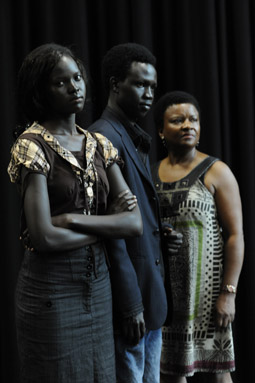
Awuol Deng, Awek Akech, Claudette Clarke, My Name is Sud
photo Adam Hollingworth
Awuol Deng, Awek Akech, Claudette Clarke, My Name is Sud
my name is sud
My Name is Sud, pronounced ‘soo-d’ (and meaning ‘black’) is a theatre work developed by members of the African community and premiering at Blacktown Arts Centre in Sydney’s west. The 2006 Australian Census counted almost 2,500 families from Sudan, Liberia and Sierra Leone, many of them refugees, who had settled in Blacktown. In response to the tensions that have arisen from a such a large influx of migrants, Blacktown Arts Centre committed to a three-year project that would give the African community a voice and an audience an opportunity to listen.
Written by an ensemble of first time Sudanese writers, Yuol Yuol, Akoi Majak, Monica Kualba and John Garang, My Name is Sud “follows the story of a family who have escaped the conflicts of war in Sudan and now face the conflicts of freedom in Sydney. Daughter Akoi dreams of being a writer. Her brother Machar struggles for a new identity. Their mother Kuei fears losing her son to the ‘streets of Blacktown’ and to his Australian girlfriend.”
Drawing on the strong traditions of storytelling and performance in these communities, South African director and writer, Robert Colman, has mentored writers and actors while resident artist at Blacktown Arts Centre.
Blacktown Arts Centre, Sydney, Nov 19-28, bookings: 9839 6558; Forum Nov 28 10.30am
wayfarer v 2: urban agents, melbourne
Media artist Kate Richards and performer Martyn Coutts are taking their locative, multiplayer media game, Wayfarer, to Melbourne after successfully premiering version 1 for Performance Space at Sydney’s CarriageWorks (see review). Version 1 was played by audiences tracking and directing a group of performers. In version 2, this time on the streets, the audience who sign on become the performers.
In the artists’ words, “teams of urban agents armed with mobile phones…will create and enact socially responsible experiences—large or small, planned or improvised including art projects, urban renewal, improvisation and drifting, liminal explorations, parkour and skate, gifting, green living/carbon neutrality/light footprint, flash mobs—anyway and anywhere they want to engage ethically and positively in the city. Videos of the experiences are streamed from players’ mobile phones directly to the Wayfarer website. Here web visitors, futurists and expert commentators in the field of social media will view, discuss and vote on the videos and drive a broader discussion about social responsibility.” For information and to register to play, go to www.wayfarer.net.au or info@ wayfarer.net.au; Arts Centre, Melbourne, Oct 26-31, Nov 2-7
real time collaborators: saskia falls
A group of Adelaide performers who have cheekily titled themselves Real Time (but with respectful spacing) are being hosted by Adelaide’s Vitalstatistix as part of that company’s Incubator program. Emma Beech, Sarah John and Holly Owen subject a returning traveller, Saskia, to existential fundamentals around the concept of home. An audience of 25 is invited to meet Saskia in real time, face to face: “You will have the chance to be curious, to be nosy while you explore the gallery of a life. Look at Saskia’s pictures, listen to her phone calls, touch her things and move through her space. It’s up to you how much you find out.” Saskia Falls, Waterside, Port Adelaide, Oct 7-18; www.vitalstatistix.com.au
craig walsh, artefact h10515
Australian media artist Craig Walsh’s magical large scale installations have appeared over the years on RealTime covers and in our pages. He’s filled Martin Place bank windows with (projected) fish and the Art Gallery of NSW portico ceiling with giant cockroaches. Now he’s created Artefact H10515: “Living within a large museum-like showcase, Artefact H10515 is highly responsive; moving and breathing within its physical boundaries and feeding on digital sources supplied via the web. Feed it your favourite objects.” Put more precisely, “Artefact H10515 prowls around feeding on content from a variety of sources from across the internet including the Powerhouse Museum’s own collection to present a constantly changing organism.” Anyone can contribute.
The work is the result of a collaboration with Powerhouse Museum, programmer and 3-D animator Steven Thomasson and composer and sound designer Lawrence English. http://artefact.powerhousemuseum.com.
danielle freakley, quote generator
Performance artist Danielle Freakley’s epic project has taken her to many countries. She’s in New York now and soon will be in Adelaide as part of the Experimental Art Foundation’s series, gone in no time (gone in no time). The series “proposes the EAF exhibition space as a site for making and being, as opposed to its usual function as a space containing objects and actions made or devised elsewhere. Eight artists have been invited to occupy the 25 by 10 metre space for a period of two weeks each and engage in their particular determination of creative action.” For most of the series, two artists at a time will occupy the space each fortnight. Freakley will be partnered by Austrian artist Margit Brünner, October 13-24.
Freakley has bravely committed herself to collecting, documenting and recalling statements of many kinds from daily life and then delivering them back to the world. The effect, on screen, is amusing and slightly alarming when quotes roll off her tongue, suggesting a human who might just be programmed. Freakley herself is The Quote Generator, “read[ing] aloud the quote in its ordinary speaking voice, not in character. The quote is always followed by a spoken reference.” She says of her performance at www.thequotegenerator.com, “The Quote Generator is absorption of unoriginality. The Quote Generator is a regurgitation library to live by. The Quote Generator is a frustrating constant acknowledgement of ever-present, inescapable mimesis.” Experimental Art Foundation, Adelaide, www.eaf.asn.au
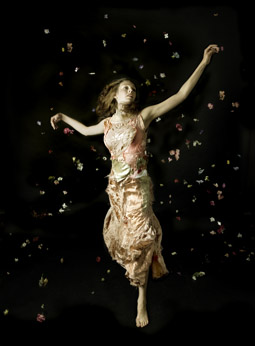
Quindell Orton, The Garden, Jambird
image Eva Fernandez
Quindell Orton, The Garden, Jambird
new dance: launceston, hobart, perth
Tasdance is premiering works from the idiosyncratic talents of Frances Rings (who has danced and choreographed for Bangarra) and Anton (ADT, Tanja Liedtke’s Twelfth Floor etc) at the Earl Arts Centre, Launceston,?Oct 16-24 and Theatre Royal Hobart, October 30-31.
In the 2009 Fremantle Festival, hybrid performance company Jambird (Chrissie Parrott, Jonathan Mustard) present The Garden, which “will transform the entire Moores Building Contemporary Art Gallery into a dark secret garden, filled with the sound of one hundred music boxes…altered and adorned by some of WA’s top visual artists.” The six galleries in the building will house immersive installations created in collaboration with artists from theatre, dance and music as well as the visual arts in a work Parrott describes as “more like performance art than a regular dance work.” Performances: Moores Building Contemporary Art Gallery, Fremantle Nov 4-15, 8pm; installation: daily 10am-5pm; producer Performing Lines.
Strut, Perth’s support organisation for independent dance, is going ambitiously mainstage with Counter Point at His Majesty’s Theatre. The program features French choreographer Didier Theron’s Harakiri, “a highly physical and emotive exploration of notions of self-sacrifice”, Jo Pollitt’s Re-Render in which Chrissie Parrott? performs revealing aspects of her dance career, and Soul Searching from WA Ballet dancer Cass Mortimer Eipper. His Majesty’s Theatre, Perth, Nov 13-14, www.strutdance.org.au
RealTime issue #93 Oct-Nov 2009 pg. 20
© RealTime ; for permission to reproduce apply to realtime@realtimearts.net
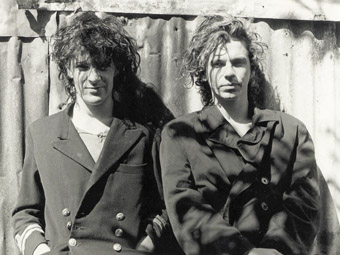
Sam Sejavka and Michael Hutchence on the set of Dogs in Space (1986)
image courtesy of Ghost Pictures Pty Ltd
Sam Sejavka and Michael Hutchence on the set of Dogs in Space (1986)
THE PROSPECT OF A DOCUMENTARY FILM ABOUT THE PUNK AND POST-PUNK ERA IN MELBOURNE WAS ALWAYS ASSURED A BUMPER OPENING NIGHT. WHEN THE FILM IS MADE BY THE DIRECTOR OF DOGS IN SPACE (1986), A CULT FEATURE FILM ABOUT THE SAME PERIOD, YOU CAN EXPECT THE JOINT TO REALLY ROCK.
And it did. There was something uncannily familiar about the queue that wound its way up two flights of stairs all the way from the cold Federation Square palazzo outside. All it needed was sleeping bags, deck chairs and a few fires burning in 44 gallon drums and it would be not so far removed from the establishing shots of the film the ACMI crowd were about to see.
We’re Livin’ on Dog Food begins with behind the scenes footage of the opening sequence of Dogs in Space, which recreates another legendary queue from 1978, when fans camped out for two weeks at the MCG for David Bowie tickets. These images immediately convey a sense of reflection, of one film in dialogue with another, teasing out different perspectives on events depicted in Dogs in Space with the benefit of 25 years hindsight.
We’re Livin’ on Dog Food is an extension or consequence of Richard Lowenstein’s longstanding desire to re-release a restored Dogs in Space on DVD. “I discovered a number of boxes of 16mm film and audio tapes of ‘behind the scenes’ interviews with Michael Hutchence and some of the other cast and crew so the overall package of a DVD and ‘Extras’ was looking pretty good.” Those “extras”, like so many punks ingloriously littering the MCG footpath, would eventually find their place in the first comprehensive documentary of what has been referred to as the “blank generation.” Music journalist Clinton Walker’s commitment to documenting the indie, punk and ‘Little Bands’ scene in his Inner City Sound (1982) and accompanying CDs has been for too long the only systematic account of the incredible diversity and creative energy of the period, the time of The Slugfuckers, Equal Local, The Boys Next Door, Essendon Airport and The Young Charlatans, among many others. On the heels of two compilation CDs of Australian post-punk music released by Chapter Music in 2001 and 2007, as well as a series of post-punk videos at the Melbourne International Film Festival this year, We’re Livin’ on Dog Food adds another dimension to a music scene in which being despised was the ultimate accolade.
For a long time this period has remained underground, but for all the wrong reasons. Invisible and absent from the official social and cultural histories of Marvellous Melbourne, it shares affinities with another crew elbowing its way back into popular consciousness, the sharpies of the 1970s. Dogs in Space begins with the decline of one subculture and the ascendency of another, as a bunch of agro sharps and boneheads are given a hiding by strung out and doped up punks waiting in that long queue (a changing of the guard also announced at the end of Michelle Moo’s 2004 novel, Glory This). In a weird coincidence, the significance of this moment accounts for the very fact that We’re Livin’ on Dog Food has appeared at a time when independent Adelaide-based filmmaker Paul Nassari is making a documentary about the Melbourne sharpie scene. And not before time, too. In a remark made to me a number of years ago by a former Thomastown sharp, one Mark Brandon Read, the sharpies are a “neglected part of Australian history.”
At the time documented in the film, however, the very concept of punk was hostile to memorialisation and longevity, to making history. As Lowenstein has suggested, “no-one in the ‘scene’ ever went on to occupy any serious position in the media or the ‘establishment’.” The Punk scene was about smack, fast music, having a good time and, well, as Iggy famously put it, “livin’ on dog food, so what!” A common theme in the film is that for the punk sensibility food was a non-essential item. As The Ears’ Tim McLaughlan suggests, if push came to shove Gravox eaten off newspaper is more than sufficient sustenance for a big night out. As a legacy of the Whitlam Government the dole was good back then and living the punk dream amounted to, in the words of Primitive Calculators’ Denise Hilton, a Government sponsored arts grant.
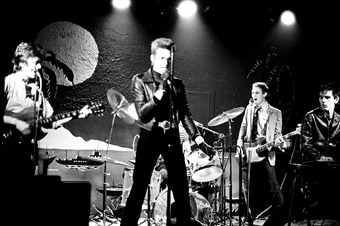
JAB featuring Bohdan X as lead singer during a live performance
image courtesy of Ghost Pictures Pty Ltd
JAB featuring Bohdan X as lead singer during a live performance
The faded glory of the old George Hotel in Fitzroy Street St Kilda, with its raffish street cred of the drug and sex trade, was an ideal, downbeat venue for the centre of the punk vortex. For the bands that played at the Seaview and later Crystal Ballrooms at the George, as well as the crowds that went to hear them, having a good time was about here and now. But consistent with the film-about-a-film-about-a-period vibe, We’re Livin’ on Dog Food is a vital, necessary and timely account of a largely unrecognised subculture that, as Lowenstein asserts, “seems to have become officially summarised and condensed into the life and times of Nick Cave as if nothing else and no-one else actually existed.” The use of footage from Tony Stevens’ and Sue Davis’ 1980 film Punkline, depicting crowds of nameless suburban youths at the Seaview Ballroom, reveals how Melbourne’s punk scene borrowed influences from the UK and US then kicked them into shape with the distinctively Australian vernacular of hard pub rock and all that went with it.
The narrative concerns of the film are carried by lively, astute and at times hysterical reflections by various band members, personalities and decisive figures of the punk demi-monde (Alannah Hill, Bruce Milne, Dolores San Miguel, Rowland S Howard, Stuart Grant, Sam Sejavka, Ollie Olsen, Clinton Walker, Philip Brophy). Combining personal reminiscence and “therapeutic purging” with plain factual details on what went down and where, these talking heads counterpoint the gritty, often rare footage of the streets, venues and squats so vividly brought to life in Dogs in Space.
Lowenstein reflects that the “punk scene was an embarrassment to the Australian music industry back then. In a similar way, Dogs in Space was a total embarrassment to the Australian film industry because it preferred and knew how to handle innocuous candy-coated fare, like The Man from Snowy River.” Not one to shy away from avidly embracing such ignominy, Tsk-tsk-tsk founder and resident bill-poster artist of the Melbourne punk scene, Philip Brophy has the last word as the credits roll. As a film about “a bunch of nobodies in a Richmond squat”, Dogs in Space, he asserts, is a “punk moment” in the history of Australian cinema. We’re Livin’ on Dog Food joyfully and democratically asserts that as far as the Melbourne punk and post-punk scene was concerned, everybody was a nobody who could do stuff until it hurt.
We’re Livin’ on Dog Food, director, editor Richard Lowenstein, director of photography Andrew De Groot, sound Rob McKenzie, producers Richard Lowenstein, Andrew De Groot, Lynn-Maree Milburn, 94 minutes, Ghost Pictures, 2009. Distributor Umbrella Entertainment. Premiere: Melbourne International Film Festival, Aug 2
RealTime issue #93 Oct-Nov 2009 pg. 21
© Darren Tofts; for permission to reproduce apply to realtime@realtimearts.net
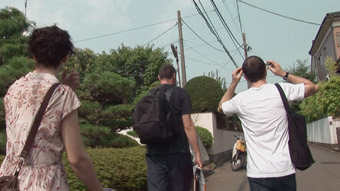
Three Hams in a Can
THREE HAMS IN A CAN IS AN UNASSUMING FILM ABOUT AN UNEVENTFUL TOUR OF TOKYO BY THREE EXPERIMENTAL MUSICIANS FROM PERTH: CHRIS COBILIS, PREDRAG DELIBASICH AND STINA THOMAS. WE FIRST MEET THEM AS THEY SIT IN SEPARATE ROWS ON THE NIGHT FLIGHT AND THEN FOLLOW THEM, SHAKEY HANDHELD-CAMERA-STYLE, OVER THE NEXT WEEK THROUGH THE STREETS OF MID-SUMMER TOKYO AS THEY SIGHT-SEE, VISIT PEOPLE AND MAKE A LITTLE MUSIC.
Despite being about musicians on tour, the film’s director, Kenta McGrath, chooses not to make their adventures in the experimental music scene his focus, opting for what he argues is a film that is “universal and accessible to those who don’t care less about the music these people were playing” [Director’s Statement]. It is hard not to question the logic. Not to focus on the underground music scene of Tokyo and the artists’ engagement with it is surely to waste a valuable opportunity, and as McGrath does not specifically select another angle, his film teeters on the brink of bland travel doco.
On the other hand, it is the uneventfulness of the film that provides its charm. The three musicians don’t have a lot to say to each other, at least not on camera anyway. But as the film progresses (and a few beers are sunk), we see them open up, particularly in two key scenes which involve interaction with Japanese people. In an extended sequence (which begs serious editing) the gang visit a Japanese family to whom Delibasich, a tall Serbian-Australian, seems somehow related (by marriage one suspects from reading the credits). They are treated to an afternoon of Japanese hospitality, including bbq-ing and playing with a spoiled West Highland Terrier, finishing with the inevitable family photo session. With minimal shared language, the polite strain is evident but so too is a sense of warmth and generosity. The idea of bonding beyond language is driven home in the following scene between a tipsy Delibasich and a sodden Japanese train driver. They sit in a gutter late at night, sharing cans of beer and drunken philosophising, repeating themselves and gesturing goodwill. It’s a moving scene saved from sentimentality by the robustness of the personalities.
At 79 minutes, Three Hams in a Can over extends itself. Perhaps a 50-minute work may have prevented some of the ennui that I experienced watching it (strange given Tokyo is such an exciting city). The hand-held doco style limits the cinematographic palette somewhat, with music performances in clubs filmed from dull angles, or shots of objects blocking vision in tedious ways. And there are simply too many shots following the backs of the musicians as they trudge through the excessive humidity. McGrath’s camera, for the most part is completely passive, lacking a sense of commentary or intention. This may have been an attempt to banish ego, but if so the visual content needed to be more charged to provide greater insights. There are a few moments in which the sequence of events creates its own poetry, such as the walk through the Meji Jingu gardens, where we witness mating butterflies and then a traditional Japanese wedding procession. The final scene where Delibasich and McGrath board a peak hour commuter train, filling beyond capacity, forcing the camera into backpacks and armpits provides one of the film’s more interesting moments.
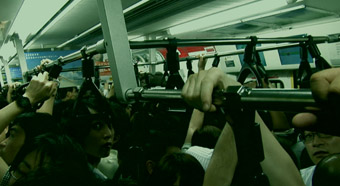
Three Hams in a Can
In his intention to avoid making a ‘music film’, McGrath missed an opportunity for more innovative use of the artists’ music as his score. The possibilities are glimpsed in a scene of swirling turtles which uses some of Delibasich’s frenetic guitar in parallel with the image, or the sequences with the barking dog and in the packed commuter train where we hear sweet piano pieces by Thomas in intriguing juxtaposition. The concert footage is sometimes informative, showing a range of Japanese artists with styles from rock noise assault to intricate acoustic improvisation. Whether intentional or not, what is revealed about these international gigs, so sought after by Australian musicians in the quest for profile, is that they are quite low-key, humble affairs—just like home. The Australian live set segments are too brief to really show the artists at their best, however the accompanying CD, Smell You Later, with five tracks each from the artists, demonstrates their work to better effect.
Co-incidentally, I was in Tokyo in August 2008 when the film was shot, so I was filled with nostalgia, seeing the gang wander the streets past the same mysterious posters, mopping sweat, marvelling at the swarming turtles and hearing the screaming semi (cicadas). Perhaps the strength of the film is its authenticity and its avoidance of ‘Lost in Translation’ clichés. I wonder if its understated charm is as universal for those who have not been to Tokyo in mid-summer. Three Hams in a Can is an interesting film, just one that I wished had explored its subjects and its form more thoroughly.
Three Hams in a Can, director Kenta McGrath, featuring Chris Cobilis, Predrag Delibasich, Stina Thomas, Little Boy Pictures/Heartless Robot Productions; www.threehamsinacan.com
Three Hams in a Can premiered at the 2009 Revelation Film Festival
RealTime issue #93 Oct-Nov 2009 pg. 22
© Gail Priest; for permission to reproduce apply to realtime@realtimearts.net
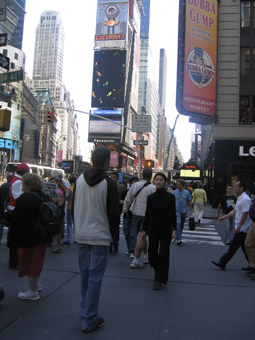
Hye Yeon Nam, from Wonderland (video), Screengrab
courtesy the artist
Hye Yeon Nam, from Wonderland (video), Screengrab
“THE MOTIVATION FOR SCREENGRAB WAS TO BRING THE WORLD HERE—TO BRING NEW MEDIA ARTS INTO THIS SPACE FOR STUDENTS TO SEE WHAT PEOPLE ARE PRODUCING, TO SEE THE POTENTIAL FOR THEIR OWN WORK, AND FOR THE PUBLIC TO UNDERSTAND AND INTERPRET NEW MEDIA ART.”
Mitch Goodwin is a lecturer at James Cook University’s School of Creative Arts in Townsville, and a member of the team convening eMerge Media Space, along with Elly Murrell, Richard Gillespie and, in Cairns, Russell Milledge.
The appellation ‘new’ can be applied to almost everything within reach of the conversation. SoCA is a recent convergence of the university’s various visual arts, theatre and music strands under a creative arts umbrella. It is physically housed in a striking cluster of buildings barely a year old, and the inaugural Screengrab exhibition and prize celebrates the establishment of the eMerge Media Space, while flying the flag for SoCA’s new direction: “A statement of intent”, says Goodwin. “People think we’ve stopped making art, and we are debunking that myth.”
Screengrab’s theme, “Intervention”, gave digital practitioners a broad concept to work with. “[It] can be a bit political and edgy, a word and concept relevant to 21st-century life. It can address issues like government control, but also the technological, social and personal. It’s a standardisation of how we look to control things”, Goodwin explains.
The selection panel considered 70 low-res entries from around the world, and narrowed the field to 15 finalists for the exhibition. “A whole range of people responded. Some entrants were very web savvy, others not at all; video artists for whom the computer is a secondary consideration, a tool for editing and dissemination.” Goodwin’s catalogue essay notes that, “Artists and programmers tackled the theme from a number of positions; some were technological interventions of the medium itself, while others placed notions of communication and exchange formats at the centre of their critique while others pursued directly the politically mediated currents of our time.”
tank man tango
The winner of the open award, Deborah Kelly (Sydney, Australia) addressed intervention and every sub-theme of “place/identity/space/community” with her poignant Tank Man Tango: A Tiananmen Memorial (2009) [see photo feature]. This two-screen work drew on the ubiquitous original footage of the unknown man with the plastic shopping bags stopping the tanks in Tiananmen Square, Beijing, when the Chinese army crushed the student uprising on June 4, 1989. Kelly notes that “he became a global symbol of courage—except in China, where the past has been erased and memory outlawed.”
Kelly distilled the man’s tank-blocking tactics into a simple choreography, disseminated these instructions in a number of languages via YouTube and urged people to “forget to forget” by performing the piece wherever they were on June 4, 2009. All this is documented on the first screen, while the second screen shows stills and videos of small and large groups of people clutching their plastic bags and silently performing the Tank Man Tango in public spaces everywhere from Warrnambool to Barcelona, and even in front of the Chinese Embassy in Brussels.
The whole work is engaging to watch, its simplicity belying the emotional response it elicits in viewers, even those not old enough to remember feeling equal parts hope and horror as Tiananmen played out in 1989. The demonstration of the choreography, performed by an Asian man under a spotlight as the narrator counts the time, the only music the rustling of the plastic bags raised and lowered, is poetic. The work’s clever basis in an unforgettable image cannot undermine Kelly’s sincerity in creating a piece featuring tiers of intervention and fulfilling her intent to make us feel, remember and act.
wonderland
A simple but effective premise also underpins Wonderland (2008), Hye Yeon Nam’s evocation of the migrant experience, and winner of the Focal Press Tertiary New Media Arts Prize. The Korean artist, now studying in Atlanta, USA, appears in her video walking tentatively through the streets of that city, while those around her are rushing past, backwards. Of course the video has been reversed—she is walking backwards along the crowded sidewalk, which explains her slightly awkward gait and air of vulnerability—she can’t see what lies ahead of her, only behind. “I understand space as the sum of cultural and social forces that act on me. Through the space, my body feels all changes around me instantly and intimately. When I moved from Korea to the United States, my body became a gauge that felt my displacement”, explains Hye’s catalogue entry. The sense of isolation is made palpable by her movement against the stream and the fact that no-one in the crowds in the video seems to take the slightest notice of her odd behaviour. www.hynam.org
twins
The sound for almost all of the works in the exhibition is supplied through headphones (necessary to fully utilise the gallery, which comfortably housed the 15 works, but isn’t huge) with two exceptions. Ambient music emanated from Alison Locke’s Twins (2009, Sydney), while the big screen work dominated one end of the darkened gallery, creating a laidback feel with its swirling translucent lava-lamp forms. The mesmerising, warm visuals resembled a slow dance of jelly blobs and rippling silk, and I was surprised to find on reading Locke’s catalogue entry that the work is about medical intervention in childbirth, meant to convey anxiety as well as mystery.
one two three. five
In complete contrast, the other audible track was a series of periodic sharp claps from One Two Three. Five (2009) a video work by Tomoyuki Yago (Japan) which deals with the “negotiation between index time and subjective time.” He filmed many people separately, each silently counting to 123.5 seconds after hearing a metronome for three seconds. When they think they have reached 123.5 seconds, the subjects clap their hands and disappear from the screen. When the screen is blank, another group appears and the cycle begins again. This strangely compelling work had me counting along and wondering who would negate their existence first, but an index time is not given—it is not a competition, just a quirky reflection on individual perception of time units.
Sharon Lenger (Israel) is “peering into windows to feel a bit at home…” in her subtitled, sweetly voyeuristic video work To Be There (2008), set to a soundtrack of street noise, footsteps, distant music and snatches of conversation. Clint Enns’ (USA) offering, putting yourself out there (2009) is also voyeuristic in the online sphere, showing random chatroom addicts on a pixelated small screen—twitching, scoping eyes and fingers in mouths. The accompanying song wistfully intones, “I wrote the book on how to be lonely.” Do they know they’re being observed?
Most entries were video works, with only a few interactive pieces, among them Jason Nelson’s I made this, you play this, we are enemies (2008, Gold Coast) and Matthew Randall’s The Digital Harmonograph (2009, UK) in which sine waves are manipulated to form complex patterns.
With artists from Australia, USA, Germany, Czech Republic, Japan, Israel, UK and India among the finalists of the inaugural Screengrab, eMerge is planning an expanded version next year, fulfilling its mission to bring a world of new media arts to an unlikely corner of regional Australia.
Screengrab, Intervention Place/Identity/Space/Community, School of Creative Arts New Media Arts Prize, Focal Press Tertiary Prize, eMerge Media Space, SoCA, James Cook University, Townsville, Aug 7–21
RealTime issue #93 Oct-Nov 2009 pg. 23
© Bernadette Ashley; for permission to reproduce apply to realtime@realtimearts.net
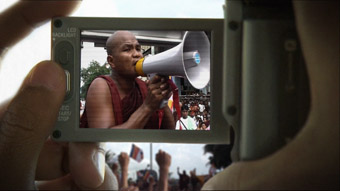
Burma VJ; image courtesy of Distributors, First Hand Films; www.firsthandfilms.com
ISSUES OF LANGUAGE AND CULTURAL REPRESENTATION IN AUSTRALIAN DOCUMENTARY FILMMAKING HAVE BEEN BROUGHT INTO THE LIMELIGHT. STOLEN, SCREENED AT THE SYDNEY FILM FESTIVAL, PROPOSED THAT THERE IS SLAVERY IN THE POLISARIO REFUGEE CAMPS IN THE WESTERN SAHARA. BUT TRUTH WAS A STUMBLING POINT FOR THIS DOCUMENTARY WHEN ABC TV’S 7:30 REPORT REVEALED MISTRANSLATIONS OF SCENES THAT APPARENTLY REVERSED THE MEANING OF THE CONVERSATIONS TAKING PLACE.
stolen
For Stolen’s second main outing, at the Melbourne International Film Festival (MIFF), the film was recut by the filmmakers with corrected subtitles. The filmmakers maintain these corrections have not changed the meaning of the scenes. The trouble is, how can anyone living in Australia really know who to believe here?
Other than Melbourne film writer David Tiley (Barista is his blog), the documentary community has been muted in its reaction. Privately though, there has been a bizarrely George Bush style ‘You’re either with us or against us’ view of film. To be with the film is to believe there is slavery in Polisario camps, to be against it is to side with Polisario wholeheartedly. Surely you can be for or against a film for a number of different reasons, some of which have nothing to do with its central argument? For instance, after watching the first version I think that there is complex cultural inequality in the camps, and that the filmmakers got carried away with the black and whiteness of slave and master (or this case mistress) as labels. They had ‘story creep’, and chased the story of slavery rather than focusing on how a society that has recently de-legalised slavery functions.
But what worries me is not whether or not you can call it ‘slavery’, but whether or not the filmmakers broke the bond between filmmaker and audience through mistranslation. In documentary, if you break that, what is left? Exotic pictures and a piece of fiction? No doubt the filmmakers suffered the constraints of a small budget, but the Stolen story is a lesson in how not to organise your translation pathway in post-production. The maker’s defence of their film can be read at www.unitednotionsfilm.com/Index.htm.
10 conditions of love
In Melbourne, 10 Conditions of Love stole the limelight at MIFF. Jeff Daniels’ film went from lacklustre ticket sales to the hottest film of the festival. Even the star festival guest, Quentin Tarantino, was being asked what he thought about the controversy.
10 Conditions of Love is a film about an exiled Uyghur businesswoman and her struggle for Uyghur rights in East Turkestan. The film’s rise from rags to riches was generated by the Chinese Consul’s attempt to shut down the screening and cancel the principal subject’s visit to Melbourne. According to the Chinese, Kadeer is a Muslim terrorist; according to the filmmakers she is a Uyghur rights activist. The battle over 10 Conditions of Love centred on this labelling of Kadeer. The Chinese pumped their own propaganda machine into action to discredit her and in doing so, brought the film and the issues explored in it a larger audience. Polisario’s attempts to discredit Stolen by challenging the veracity of the translations was a cleverer tactic. 10 Conditions of Love also dealt with content spoken in an uncommon language, but unlike Stolen, it did not lose access to its subjects or principal locations. This meant Jeff Daniels could run the translations by Rebiya Kadeer to check they were correct. Even if the Chinese wanted to follow Polisario’s lead, it would have been very difficult.
However, neither of the juggernaut films, 10 Conditions of Love or Stolen, challenged film language or ways of perceiving. For new and exciting ways of looking at ‘other’ cultures there were two lesser known works: the Danish film, Burma VJ and, from Australia, Intangible Asset No. 82. Neither was made by a filmmaker from within the culture observed, but both broke down 21st century perceptions of the ‘other.’
intangible asset no. 82
In Intangible Asset No. 82 Emma Franz follows jazz drummer Simon Barker to Korea in search of a musical shaman. Barker’s guide on the journey is Korean musician Kim Dong-won. The structure follows the classic hero’s journey. We hear Barker’s thought track as we watch him in the observational footage. So far, all normal narrative fare. However, fairly early in the documentary we leave the subject’s inner musings and enter the head of his guide, Kim Dong-won. Suddenly the ‘other’ character, the Korean, is also central to the storytelling. We hear what he thinks about Barker and the journey. This is done through non-sync audio from interviews with Kim Dong-won laid over the observational footage. Franz has skilfully combined the two perspectives of into a multi-narrative, multi-perspective on a journey. She is doing for documentary what Robert Altman did for fiction film. It is a ground-breaking and exciting shift in the usually mono perspective of the hero’s journey. Franz is a former jazz singer, and this may have influenced her decision to include parallel narrative lines in her story.
burma vj
The Danish film, Burma VJ, is promoted as an activist documentary, with the oh-so-familiar accompanying website on how you can save the world. So it was a great surprise when it turned out to be the most amazing documentary I’ve seen since Bastardy (2008; see review RT91), or maybe even since Darwin’s Nightmare (2004). Just when I thought I’d seen everything that film language had to offer, along comes Burma VJ.
The film is constructed from footage recorded by a group of underground video reporters who filmed the 2007 uprising by monks in Burma. Amateur filmmakers with handicams hidden in bags create a strategy of how to film in a society in which those they film could be watching them. The counter-gaze can have deadly consequences. They turn the camera on in a safe quiet place, leave it running inside the bag, unzip at key moments and quickly rezip after the moment has passed and escape to a getaway car. The camera darts about and captures an impression of the camera person’s own fears as well as the emotions of the people around them. They often inadvertently provide a running commentary on what they are filming because they are constantly on their mobile phones to HQ explaining what they are getting, where the action is heading, and receiving instructions about what to film next. Each camera person is one of many strategically placed around any given space to ensure that at least one will capture the moment and not get arrested.
The footage these amateurs capture is simultaneously epic and deeply personal. You can’t help but be moved to tears. It is the artistic culmination of the early 21st century proliferation of image capturing devices in the hands of the amateur. The ultimate ‘user-driven’ footage. We are literally watching events unfold through their eyes.
Director Anders Østergaard has allowed the unique POV of these Burmese guerrilla filmmakers to completely envelop the documentary. Even the voice over, provided by one of the former camera people, contains just the right mix of subjective and analytical—the kind of voice over you’d expect from an Agnes Varda film.
If Østergaard had taken his own camera into the 2007 uprising he could never have got this footage, precisely because he would have been an ‘other’ in relation to the culture and the events. These anonymous Burmese camera-people have created a unique film language. Burma VJ was gripping, I wouldn’t be surprised if we see more of this kind of filmmaking generated at future uprisings around the world.
Melbourne International Film Festival: Stolen, directors, writers, photography Violeta Ayala, Dan Fallshaw, producers Tom Zubrycki, Violeta Ayala, Dan Fallshaw, Deborah Dickson, music John McDowell, United Notions Films; 10 conditions, director Jeff Daniels, directors of photography John Lewis, Dennis Smith , sound Jeff Daniels, WS TVF International; Intangible Asset no 82, writer, director, producer, photography Emma Franz, editor Daniel Kerr, sound Matthew Ferris, sound mix Michael Gissing, Andrew McGrath; Burma VJ, director Anders Østergaard, writers Anders Østergaard, Jan Krogsgaard, directors of photography Simon Plum, The Burmese VJs, editors Janus Billeskov-Jansen, Thomas Papapetros, producer Lise-Lense Møller, producers WG Film, Mediamente, Kamoli Films; MIAF, July 24-Aug 9
RealTime issue #93 Oct-Nov 2009 pg. 24
© Catherine Gough-Brady; for permission to reproduce apply to realtime@realtimearts.net
{$slideshow} WITH JOHN HUGHES, NOTHING WOULD SURPRISE ME. HE IS NOT A DOCUMENTARY FILMMAKER WHO CAN BE UNDERSTOOD ON A SURFACE LEVEL, AND NEITHER CAN HIS FILMS. THERE ARE LAYERS AND CROSS LAYERS OF IMAGES, TEXT AND VOICE.
Hughes is respected as Australia’s foremost exponent of the ‘essay’ style documentary. He has been experimenting with this style since the 1970s. In the brilliant All That is Solid (1988), he hands objects, eg a snow dome, to the interviewees, and the film is constructed from their responses. The ‘essay’ of the film is the fragmentation of meaning and the absence of any shared vision. Hughes modestly says of this film, “Yeah, that’s mad.”
These earlier films do not employ Hughes’ trademark layered screen design. This came later, as a response to problems presented by conveying complex ideas in a scene. “When Uri [Mizrahi] and I did One Way Street [1993], we had this fantastic little sequence to do about Freud’s idea of the slip of the tongue, the accidental moment that produces the flash of insight. If read critically, that idea has got a lot of content…but we had to do it [with separate] rolls of video. But it was possible for the first time, in 1992, because we had digital videotape, so you could have layers without losing generations. Now you can just simply do it on a screen.”
Hughes also talks about his layered screen design as a Dadaist technique. Once you know this you can see how the idea expressed itself in different ways in his earlier work and has shifted in response to the rapid changes in film technology. In his earlier films the Dadaist experience was created through the use of actors or objects, or both as in the snow dome in All That is Solid.
Hughes’ use of a complex screen design has not completely replaced his earlier fascination with objects as metaphors. In his latest film, Joris Ivens: Indonesia Calling, he filmed street mime artists performing with a glass ball. His focus on the ball can be read as symbolising the elusive relationship of filmmaker to light and image. As in his earlier works, the layers of meaning come from the various readings of the object within the film’s montage, rather than the layering of images on top of each other.
Hughes says, “It’s often about using found material and building collages with them so you have the capacity to engage a spectator in a temporal way. You build one idea and one image in relation to the next—illustrating or enhancing or playing with whatever material that you are delivering in an audio track. But you have also got the capacity to build those montages in the form of a collage. It gives it a denser complexity. And it theoretically [he laughs] generates a spectator experience which is more active.” When asked why he would want to create that sense of distance or alienation between the audience and the material, Hughes says, “Because you favour a critical mode of spectatorship over a consuming one.”
With his mix of the anti-logic of a Dada screen design and the logical formality inherent in an essay film, Hughes finds “the essay form often allows more creative originality and more editorial freedom. In some way the term ‘essay film’ is quite close to what IDFA [International Documentary Film Festival Amsterdam] and Toronto’s Hot Docs like to call the ‘creative documentary’ as distinguished from ‘specialist factual’, for example, science programs, or history programs like the ABC has been doing with their ‘dramatic re-enactments’ and so on. [It has parallels with] the essay form in literature, as distinct from reportage, current affairs, or other modes of journalism. It can be more subjective, more speculative, more discursive, more ‘authored’, if you like…”
It may be more authored, but with Hughes’ films it will not be more personal. The two are not the same for Hughes. For instance, in his latest film Joris Ivens: Indonesia Calling, preference is given to understanding Ivens’ filmwork over understanding the man.
Hughes doesn’t use anecdotes or biography in the construction of his films. This creative decision influences not only the stories included in his films, but also the use of elements within the film, for instance, the narrator. He says, “In my work I like to recess the narrator as much as possible in favour of the material itself. That’s consistent with me not liking um… biography-based articles, or interviews in general!”
Joris Ivens: Indonesia Calling completes a trilogy of films concerning the interface of filmmaking and Communism in Australia during the mid-20th century. This has been a subject that spans Hughes’ working life. The first part of the trilogy is Film Work (1981), which rediscovers the work of the Waterside Workers’ Federation Film Unit. The second is The Archive Project (2006; RT72, p17), where Hughes rediscovers the work of the Melbourne Realist Film Unit. In a break with his usual style he cast himself in this film as the filmmaker narrator delving into suitcases full of old rolls and written records. The final part of the trilogy is his latest documentary, which looks at events surrounding the mysterious creation of the film Indonesia Calling.
At a surface level the last part of the trilogy can be seen as a semi-biographical work. There is something about the film that evokes the spirit of Hughes. Possibly this is because the theme has been one that he has returned to throughout his life, perhaps because at first glance there seem to be similarities between Hughes and activist filmmaker Ivens. In the Howardian late 90s Hughes’ film work moved away from his examination of meaning to look at issues of the day. “Richard Frankland rang me up and said I had to make a film about the amendments to the Native Title Act…After Mabo [1998]. And that took two years…Then, while I was doing that, someone said I had to do a film about the dam in Broome. They were trying to dam the Fitzroy River [River of Dreams, 1999]. So I had to do that.” In the 2000s Hughes also became part of the Time to Go John group of filmmakers.
But when you delve into the layers of John Hughes filmmaker and Joris Ivens: Indonesia Calling, it becomes clearer that the similarity between Ivens and Hughes is not an activist filmmaking style: Hughes is too contemplative for that. For instance, his film for Time to Go John took footage from one of his earlier ‘activist films’ and closely examined the meaning and consequences of Howard’s use of the word “blemish.” Activist filmmakers find the links between real world entities; Hughes finds the links between the real world and meaning.
On closer viewing it becomes apparent that the evocation of Hughes in this film is a complex one. Joris Ivens forms an avatar for the ideas behind Hughes’ trilogy on filmmaking and politics in the mid-20th century, embodying the themes in the films and the reason Hughes made them. Ivens was spurned and harassed throughout his life for ‘red’ ideas, his works marginalised and lost, but near the end he was ‘rediscovered’ and only then was it accepted that in amongst the art was insight, and amongst the insight, art.
Joris Ivens: Indonesia Calling, writer, director John Hughes,?editor, graphics, design Uri Mizrahi, music Brett Aplin, producers John Hughes, Andrea Foxworthy.
?editor, graphics, design Uri Mizrahi, music Brett Aplin, producers John Hughes, Andrea Foxworthy.
RealTime issue #93 Oct-Nov 2009 pg. 25
© Catherine Gough-Brady; for permission to reproduce apply to realtime@realtimearts.net
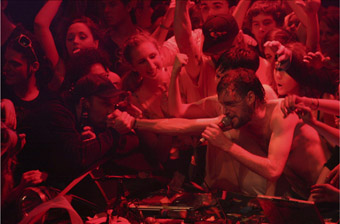
RiP: A Remix Manifesto, Brett Gaylor with Girl Talk at Concert in Montreal, Nov 13, 2008
photo Kat Baulu, copyright National Film Board of Canada
RiP: A Remix Manifesto, Brett Gaylor with Girl Talk at Concert in Montreal, Nov 13, 2008
VIDEO IS EVERYWHERE ON THE WEB THESE DAYS. THE PROBLEM IS THAT WHILE VIDEO IS ARGUABLY THE MOST INFLUENTIAL MEDIUM, IT’S ALSO THE MOST “CLOSED” ONLINE MEDIUM—THE CODECS AND SITES WE USE TO SHARE MANY OF OUR VIDEOS ARE MOSTLY OWNED BY GLOBAL CORPORATIONS (THINK ADOBE’S FLASH, APPLE’S QUICKTIME, OR THE COMMERCIALLY SUPPORTED VIDEO STREAMING SITE HULU).
While Google-scale entities like YouTube have grown to become the default state of online video, many critics, artists and activists are now wary of the proprietary systems that underlie their operations. As large corporations stake out more and more of the technological platforms needed to deliver video online, critics ask whether there is a danger that the ubiquitous, “free” and interoperable characteristics we find in email, wikis and blogs will also apply to online video. Many fear the worst.
Earlier this year in New York, a coalition of organisations and individuals met to discuss the dilemmas faced by many developers and content creators who have an interest in the newly emerging marriage of the open web and online video culture. Organised by the Open Video Alliance, the event brought together a wide range of people interested in creating and promoting free and open technologies, policies, and practices in online video (ongoing information can be found at their website http://openvideoalliance.org).
According to many of the presenters and participants, we have reached an important fork in the road. In the long-tail economy of the digital era, web-delivered video could easily become a glorified TV-on-demand service, and a central component of a permissions-based culture. Each time we want to exchange, upload or download a video file, we need to ask permission to use the codecs and protocols that allow us to share the video.
That’s why many of the independent producers and activists gathered at this event suggested that the values of transparency, interoperability and decentralisation in online video must be seriously considered if we are to avoid a hyper-commercialised hijacking of the web’s participatory culture.
Well-known figures such as Yochai Benkler and Jonathan Zittrain (from Harvard’s Berkman Center), Xeni Jardin (co-editor of Boing Boing) and Brett Gaylor (director of RiP: A Remix Manifesto) were among the presenters arguing for a more open and transparent online video culture. Benklers’ well-known work on participatory culture, distributed innovation and distributed creativity also finds its way into this emerging concept of open video. Citing mashup artists like Blacklantern, (www.theblacklantern.com), popular videos such as Let’s Bomb Iran and Jonathan Coulton’s Code Monkey as instances of decentralised human capability, Benkler’s exemplars also point to the inescapable contradictions: none of these works could have existed without YouTube.
But they could just as easily exist in other more open platforms. Michael Dale, a senior developer from the open source online video platform Kaltura, has been working on just such a project, entitled Metavid. It’s a wiki-based community archive project that hosts public domain legislative footage from the US Congress, and allows users to access metadata (such as transcripts) in order to reuse the footage in mashups or for political research. While it started as a small project by artists, it soon became a massively popular repository of political video.
Dale sees the Kaltura project as “the Apache of open video.” And that says a lot to many from the burgeoning online video community. (Apache is one of the leading open source foundations, run on a collaborative, consensus based development process. It offers an open and pragmatic software licence for high quality software that is collectively produced.)
Based on Wikimedia principles, Kaltura is a big proponent of the push towards non-Flash video standards. Dale reminded us that Wikipedia’s enormous success is largely due to its simple browser-based editing, which has removed the barriers to participation. The new HTML5 specification (which is the next major revision of the core mark-up language of the web) similarly allows open source codecs (such as OGG Theora) to play natively within the browser and to be accessible to anyone without having to use proprietary codes and players.
While this may not seem like much of a big deal, it means the world to many in the emergent open video community. One of the aims of open video is to decouple the video from the player, which is now possible with HTML5. In other words, why do we need to ask Adobe’s permission to download their Flash player or Apple for Quicktime to watch a movie on the web, when HTML 5 and OGG can do it for “free”?
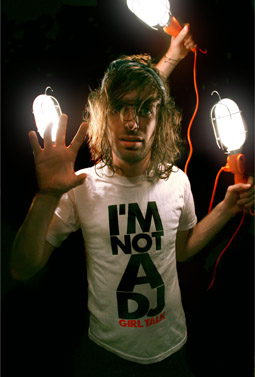
Greg Gillis aka Girl Talk
photo Andrew Strasser, copyright EyeSteelFilm
Greg Gillis aka Girl Talk
Some view this open source approach as a little utopian, even evangelical at times. For people working in public institutions or archives that need to guarantee broad ‘universal’ access to their digital collections, non-proprietary open video standards are essential. But there’s also a business case to be made. Open standards (like HTML) can drive innovation and build markets. They also add public value, as the more open video becomes, the more social value is created.
Perhaps most importantly, open video raises questions about who will control and define the social and economic spaces that are emerging around online video. Will we see a repeat of the major structure of corporate television on the web, or can we shape the world ourselves, and insist on openness at every level?
The following projects represent the beginnings of this nascent movement:
Xiph, www.xiph.org, a non-profit corporation dedicated to protecting the foundations of internet multimedia from control by private interests.
Kaltura, http://corp.kaltura.com, an open source online video platform.
Miro, www.getmiro.com/blog, an on-profit video player and podcast client built on open source principles.
Opencast, www.opencastproject.org, an initiative driven by higher education institutions to empower them to make informed choices about capture, processing, and distribution infrastructure for audio/video.
MythTV, www.mythtv.org, a free open source digital video recorder (DVR) project distributed under the terms of the GNU GPL.
Metavid, http://metavid.org/blog, Abram Stern and Michael Dale’s open video archive of US Congress footage.
Utagit, http://utag.it, a free software web service that provides spontaneous, rich, multi-dimensional tagging of media streams.
Metabroadcast, http://metabroadcast.com, a London-based start-up that develops video distribution software.
OpenImages, www.ohloh.net/p/openimages, a platform to upload, edit and publish video, audio and images.
TransmissionCC, www.transmission.cc, a network of citizen journalists, video makers, artists, researchers, programmers and web producers who are developing online video distribution tools for social justice and media democracy.
Open Video Conference, New York, Vanderbilt Hall, NYU Law, June 19-20; http://openvideoalliance.org/blog
RealTime issue #93 Oct-Nov 2009 pg. 26
© Ross Harley; for permission to reproduce apply to realtime@realtimearts.net
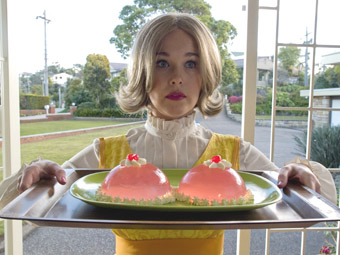
fOUR
SIL-NYIN CAMERON, DIRECTOR OF THE WORLD OF WOMEN FILM (WOW) FESTIVAL IS KEEN TO GET THE WORD OUT—WOW’S GOAL OF “GIVING THE OPPORTUNITY FOR INDEPENDENT, USUALLY LOWER BUDGET FILMS TO HAVE PUBLIC EXHIBITION—IT’S UNLIKELY THAT THE FILMS WILL GET WIDE RELEASE UNLESS THEY ARE ‘NOTICED’ PERHAPS AT OUR FESTIVAL. OUR AIM IS TO GIVE PUBLIC EXHIBITION TO MAINLY SHORT FILMS WITH KEY CREATIVE INPUT BY WOMEN—AND THIS CAN HELP FILMMAKERS FURTHER THEIR CAREERS.”
Each year, filmmakers are invited to enter works in the categories of Fiction, Documentary, Animation, Music Videos and Student films of less than 55 minutes duration. New this year is a prize for the best Vodule. A growing arena for women producers of digital media content, Vodules make use of the emerging market of mobile technology and internet distribution.
Says Cameron, “The festival promotes and awards the talents of women directors, producers, writers, editors and cinematographers in the Australian film industry and in Oceania. It is a unique festival that offers emerging and established filmmakers the opportunity to screen short works giving a thematic perspective of ‘seeing the world through the eyes of women’.”
Director of last year’s hit feature The Black Balloon and this year’s festival patron, Elissa Down, acknowledges WOW as an important part of her career trajectory. In 1991, the festival screened and toured her short, HMAS Unicorn, presenting the film to a broad audience and Down was on her way up.
Among the films screening this year are Four of a Kind, the debut feature from Melbourne-based Fiona Cochrane, a director with an extensive filmography of award-winning documentaries, music videos and producer credits to her name, not to mention a medical degree which might account for the forensic feel of her film. Though showing signs of its beginnings as a stage play, Helen Collins’ script is sustained by some intriguing plot turns and good performances on the whole. The film premiered last year at the Montreal World Film Festival and was nominated Best Feature at the 2009 ReelHeART Film Festival in Toronto and Best Feature at 2009 SkyFest Film & Script Festival, USA.
I Wish I Were Stephanie V, produced by Laura Sivis, directed by Jon Cohen and written by Chloe Traicos, who also stars in the film, combines immigrant experience, teenage angst and tennis in what is described as “a vibrant romance, comedy and drama in the My Big Fat Greek Wedding and Bend It Like Beckham mode.” Meanwhile, in fOUR directed and written by AFTRS student Erin White, “it’s 1974 and two couples with troubled marriages meet in a quiet Australian suburb and suddenly find themselves embroiled in a sexual revolution.” fOUR won best short film at the 2008 IF Awards.
Misconnect, directed and written by Aloura Charles from the USA, was filmed in Sydney and Los Angeles: “A mis-dialed phone call connects Mei, a Chinese woman with Will, a boy in Sydney, each isolated and trapped in different ways.” Charles will be a guest at the WOW Film Festival and will introduce her film on the festival’s Opening Night. She’ll also take part in the Filmmakers Forum, “Director’s Vision Through the Cinematographer’s Lens” with her cinematographer, Ming D’Arcy, on Sunday October 18 at the AFTRS Theatre.
Among the documentaries are the wonderful Maverick Mother produced, written and directed by Janet Merewether who, in her fiercely honest film, turns the camera on her own perilous journey into solo motherhood.
Experienced Canberra-based filmmaker Lara Van Raay offers what sounds like a a curious feature-documentary in her Palestine, Beer & Oktoberfest: Under Occupation: “Meet the father and daughter team who created Palestine’s first brewery…Filmed at the Oktoberfest in the Christian town of Taybeh on Palestine’s West Bank.”
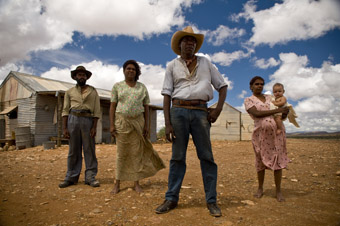
Jacob
The shorts program includes the animation, Huriyya & Her Sisters made by a group of young Muslim women in Western Sydney working with director Paula Abood. Jacob is a promising new indigenous drama set in the 1940s produced by Rhea Stephenson for Blackfella Films and directed by Dena Curtis with some lush cinematography by Murray Lui. This one has the makings of a more substantial feature. There’s also the cleverly succinct Be My Brother by Genevieve Clay (Best Film, Tropfest 2009).
As well as these and many more screenings, there’ll be Q&As, chance meetings and all the celebration that comes with events like WOW that offer a diverse group of filmmakers and their audience the chance to share, for a time, the intensity of immersion in mulitple female views of the world.
16th WOW Festival, Chauvel Cinema, Paddington, Sydney Oct 14-18; www.nsw.wift.org/wow. For updates go to the WOW blog: http://wowfilmfestival.wordpress.com
RealTime issue #93 Oct-Nov 2009 pg. 27
© Virginia Baxter; for permission to reproduce apply to realtime@realtimearts.net

Blessed
FROM HER FIRST SHORT FEATURE, ONLY THE BRAVE (WHICH SCREENED IN VENICE AND WENT ON TO WIN AFI AWARDS FOR BEST SHORT FICTION, BEST SCREENPLAY AND BEST PERFORMANCE) TO HEAD ON (ONE OF THE BEST AUSTRALIAN FILMS OF THE 90S) AND HER RECENT THE BOOK OF REVELATION, ANA KOKKINOS HAS ALWAYS MADE CONFRONTING AND EXCITING CINEMA.
Her new feature Blessed continues this trajectory, extending the themes explored in the Melbourne Workers’ Theatre play, Who’s Afraid of the Working Class (1997), with the same writers who produced the play (including Andrew Bovell and then newbie Christos Tsolkias), fine-tuning the screenplay, which has become more an ensemble piece about children and mothers, submission and subjugation, how we judge and are judged.
Like the dynamic Head On, Blessed takes place over 24 hours but employs an unusual structure to examine the lives of children and mothers about to topple over the edge. Split into two parts, the first focuses on the perspectives of the children, the difficult terrain they are forced to negotiate; the second half returns to the start of the day, flipping the coin to fill in the gaps, exploring the mothers’ lives and how they’re implicated in the children’s often dangerous behaviour. The repetition of images, like a visual refrain, brings a poignant reminder of what they all share: we are introduced to each character as they sleep, in peace, with the dawn light on their faces; we farewell them as they look towards the sun in that magic hour of dusk where the light is just beginning to fade.
Christos Tsolkias, in his award-winning novel The Slap (and, earlier, Loaded), proved a talent for capturing contemporary Australian culture in all its goddamned complexity, particularly the heart and soul of Greek immigrants. Here all the characters are strong but the standouts are best friends Katrina (Sophie Lowe) and Trisha (Anastasia Baboussouras). Lowe proves she is more than just ‘Beautiful Kate’ (see review) with wonderful comic timing and that right mix of vulnerability and sophistication girls her age possess. Newcomer Baboussouras is both tough and brittle. The dialogue between the two hits the mark, capturing the seeming banality of the girl’s smart-arse banter while exploring darker issues underneath: “You don’t cut yourself because you’re fat…I’ve seen heaps of fat Goths.”
There’s also the tragedy of young kids who don’t see the full picture, forced to deal with unexpected consequences, often too much to bear. In one of the film’s best scenes, Daniel (Harrison Gilberson) breaks into an old terrace looking to steal some money (as his parents Tanya (Deborra-Lee Furness) and Peter (William McInnes) have falsely accused him of pinching from their room) and accidentally injures an elderly woman. As he looks at the bookshelves, filled with the writings of Marx and Steinbeck, Daniel comes across Laurel (Monica Maughan) who, rather than being confronted or intimidated, tries to befriend him. When he demands money she says, “Take what you need…you’re lovely…There must be something I can give you” and he becomes indignant; this isn’t the script he has in his head. As she gains his confidence he tells her about his mother and, sensitive to the boy’s plight, she replies: “It’s hard for mums when sons reach a certain age. You’re not sure how to love them anymore.” But as she asks him in desperation to repeat “I love you mum”, we realise that she is not just benign but also using him, seeing him as a replacement for her own absent, adopted son. Her tenuous relationship with James (Wayne Blair) is explored later when she is haunted by the ghost of a memory: his Aboriginal mother appearing at the door with gifts that she hides.
The dynamic between younger kids is perfectly explored. Orton (Reef Ireland) and Stacey (Eva Lazzara) are sleeping in a charity clothing bin to escape their edgy mum Rhonda (Frances O’Connor), whose “whole life is just one big assessment” and is pregnant to the latest abuser after a string of boyfriends have assaulted Stacey. Playing in the sand with blood on her dress (she has just got her period but doesn’t know what to do), Stacey is under-resourced and ‘not all there’ with a blunt naivete that makes Orton protective. When she sees prostitutes get into a client’s car she asks, “What do they do?” On hearing Orton’s response she says, “It’s like Nathan. But he doesn’t give me any money.” O’Connor is all sinewy gristle and seething resentment in her gutsy portrayal of a mother having to deal with the unendurable, and the film’s final scene is a ripper. Pregnant and adrift, Rhonda dances alone at the local club in complete desolation, reminding me of Claire Denis’ final bar scene in her majestic Beau travail (1999): characters obliterating the pain with bodies in movement. But it only lasts for so long; they know the pain returns with daylight.
With the current trend in Australian cinema (and probably the same goes in our cinematic history) being for films about crises in masculinity (Three Blind Mice, The Square, West, Ten Empty, Cedar Boys, The Last Ride) it’s wonderful to see a film based around an ensemble of women and their roles in families and community—with an emphasis on motherhood. Often under-utilised performers like Miranda Otto and Frances O’Connor (who’ve had success recently on US television together in Cashmere Mafia) and Deborra-Lee Furness seize these meaty roles with relish. As with the intricate entanglements of Lantana (that Bovell wrote), all the characters and relationships in Blessed are enigmatic and interesting enough to carry off an entire feature on their own. It’s a good sign when you leave the cinema wishing you could follow them further.
Blessed is screening nationally after being selected for the Toronto International Film Festival in the Contemporary World Cinema program and the official competition of the San Sebastian International Film Festival. The writers recently won an AWGIE for Best Adapted Feature Film.
Blessed, director Ana Kokkinos, producer Al Clark, writers Andrew Bovell, Melissa Reeves, Patricia Cornelius, Christos Tsolkias, editor Jill Bilcock, production designer Simon McCutcheon, DOP Geoff Burton, composer Cezary Skubiszewski
RealTime issue #93 Oct-Nov 2009 pg. 27
© Kirsten Krauth; for permission to reproduce apply to realtime@realtimearts.net
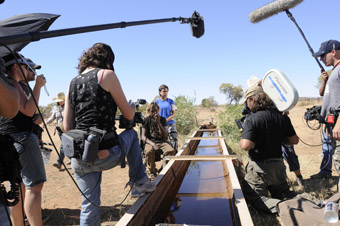
Beck Cole and team; R: Warwick Thornton and team, The Making of Samson and Delilah
photo April Goodman
Beck Cole and team; R: Warwick Thornton and team, The Making of Samson and Delilah
WARWICK THORNTON’S SAMSON AND DELILAH, CAMERA D’OR WINNER AT THE 2009 CANNES FILM FESTIVAL, IS A GRUELLING IF FINALLY UPLIFTING EXPERIENCE BLESSED WITH RARE BUT REVEALING FLASHES OF HUMOUR. BECK COLE’S THE MAKING OF SAMSON AND DELILAH IS QUITE THE OPPOSITE, A FREQUENTLY FUNNY DOCUMENTARY WITH MOMENTS OF PAIN AND FRUSTRATION AS IT SHOWS THE PRESSURE OF FILMMAKING ON ITS YOUNG, UNTRAINED PRINCIPAL ACTORS AND, IN TURN, ON ITS DIRECTOR.
“Making of…” documentaries have become a necessary add-on in the age of the DVD, but rarely do they achieve notable artform status and most are simply promotional tools. Exceptions include Fax Bahr and George Hickenlooper’s feature length Hearts of Darkness: A Filmmaker’s Apocalypse (1991) documenting the making of Francis Ford Coppola’s Apocalypse Now (1979). But that film was made well after the event, drawing on Eleanor Coppola’s footage from the original shoot. More modest ventures, like James Thomas’ 2001 35-minute account of the making of Phil Noyce’s Rabbit Proof Fence, made for Channel 9’s Sunday program, can be illuminating, in this case revealing challenges inherent in directing non-professional child actors and, most chillingly, the stress for the Indigenous performers involved in the reenactment of the child abduction scene.
Beck Cole, a formidable filmmaker of short dramas (Plains Empty, Flat) and documentaries (The Lore of Love; Wirriya—Small Boy; First Australians), followed the filming of Samson and Delilah with camera in hand and an ear for detail and circumstance that allowed the finished documentary not so much to stand on its own as to provide a dynamic counterpoint to Thornton’s film; together they make a great pairing.
Cole follows the chronology of the making of the feature film from the auditioning of young adolescents for the principal roles to the shooting of some of the key scenes and, finally, the win in Cannes. Much to his astonishment, Thornton finds his Samson (Rowan MacNamara) very quickly, though wonders “will he last” the challenge of the filming. Asked later if he’s happy about being cast by Thornton, Rowan smiles, “I like the bit where he said ‘famous’.”
Finding a Delilah proves more elusive. Among the painfully shy 13,14 and 15 year-olds are faces for a camera to fall in love with. “Can someone be too beautiful?”, asks Thornton when reviewing the audition of one youngster. Producer Kath Shelper suspects the delicate relationship at the film’s centre might then become “about lust, not love.” They’re finally attracted to Marissa Gibson, young but with a certain air of maturity and not conventionally pretty. But to secure her, Thornton, Shelper and translator and casting assistant Peter Bartlett have to travel the long distance by road to Papunya, suffer a flat tyre on the way, and convince the girl’s family. It’s worth the effort, as the first reading reveals; they’ve found a “grounded Delilah.”
Parading in a string of briskly edited costume tryouts, Rowan reveals a throwaway sense of presence—a quick oscillation between self-consciousness and proud self-possession. Thornton meanwhile is not planning to shape the actors, he’ll let them be the characters: “they own this already…I’m not going to fill their heads with Samson and Delilah back stories.” In a glimpse of an informal workshop he simply asks Rowan to sneak a sideway look at Marissa. It’s a telling and apt look.
But before filming can commence, Rowan has to face people from whom he stole and seek to be released from associated legal obligations. Soon we see him performing for the camera, Thornton instructing off-camera, like a silent movie director for a film largely without dialogue. It’s exciting to witness the filming of the pivotal scene where Samson dances—the suddenness of the shift into focused performance is gripping. Later, there’ll be sulky reserve and resistance, but at this stage Thornton can confidently assert, “We’re going to have the best six weeks of our lives.” He’s relieved, “These two can act!”
The filmmakers take over a deserted fringe town near Alice Springs where they are joined by Mitjili (Nana in Thorntons’ short, sharp comedy of the same name and also in Cole’s Lore of Love). Cole cuts away to an exhibition about the woman’s life and family. It’s revealed that as one of three wives to one man she is related to Marissa as a grandmother. Back on location, in the filming of the funny scene where Delilah’s grandmother encourages the girl to form a relationship with Samson (“He’s your skin”), Mitjili is focused on the reality of the scene, not the fiction. Encouragement and intepreting ensue and, suddenly, she’s got it.
It’s fascinating to watch the filmmaking team at work, good humoured, alert and often funny. Kath Shelper’s laughter and good sense is contagious and translator Peter Bartlett quietly ubiquitous—responsible, as the company website puts it for “casting, acting, organising, animal wrangling, driving, translating, and snake-removal…”
Despite a short break for Rowan to travel to be with his family and attend church, his mood is darkening and he’s not happy to be documented, fleeing the camera as soon as he can. Marissa’s rare moment of dissension comes when she has to cut her hair after the death of Delilah’s grandmother. Cole focuses tightly on successive stages of despair, barely restrained tearfulness and, then, Marissa’s quiet pleasure in her new look.
Cole’s documenting of the supermarket shoplifting scene (the actors overhelmed by “too shame”at having to enact such behaviour with people witnessing it) and a key late scene in a petrol station reveal the range of pressures on both director and actors. (It’s amazing that the latter scene works given Rowan’s behaviour and the lack of connection at this stage with Marissa.) Thornton’s disappointment with Rowan is more evident in his face than in words, although they’re strong enough.
But the success of Samson and Delilah at Cannes lifts us out of momentary gloom. And in between we’ve had the pleasure of meeting Thornton’s brother, Scott who plays Gonzo, a homeless alcoholic. Scott explains that, at Thornton’s insistence, he had to “go into re-hab” to get the role, and is grateful for it. Like the feature film, The Making of Samson and Delilah too has its moments of redemption and miracles large and small. As for its own making, the documentary’s informality, humour and insistence are virtues that subtly belie the significance of what it has to say about the very difficult art of filmmaking, not least where the director has fashioned his own rules for making and is working within, and beyond, the limits of his own culture.
Beck Cole is to direct her first feature film, The Place Between, in 2010 from her own screenplay. The Making of Samson and Delilah premiered at the Melbourne International Film Festival, screened at Wellington in the New Zealand Film Festival and will be seen on ABC TV in late November.
–
The Making of Samson and Delilah, director, camera Beck Cole, producers Kath Shelper, Beck Cole, editor Karryn De Cinque, sound recordists Ray McGinnes, Vance Glynn, music Cliff Bradley, sound design Liam Egan; Scarlett Pictures 2009, 55 minutes.
See interview with Warwick Thornton and review of Samson & Delilah in RT90
RealTime issue #93 Oct-Nov 2009 pg. 28
© Keith Gallasch; for permission to reproduce apply to realtime@realtimearts.net
![Bios [Bible], robotlab](https://www.realtime.org.au/wp-content/uploads/art/29/2960_crosby_ars_bible.jpg)
Bios [Bible], robotlab
photo Alex Davies
Bios [Bible], robotlab
I EXIT THE ALL DAY SYMPOSIUM ON CLOUD ACTIVISM A LITTLE CONFUSED. MY EYES ARE STILL FLICKERING FROM TRYING TO KEEP UP WITH THE THREE SIMULTANEOUS PROJECTIONS: THE ‘TWEETSCREEN’ (STREAM OF RELATED TWITTER FEEDS), THE LIVE IMAGE OF THE PRESENTERS AND THE SLIDES OF MAPS AND DATA. ALTHOUGH IT FEELS AS IF THE DISCUSSIONS HAVE BEEN AROUND ACTIVIST USES OF THE INTERNET, THE APPARENT CONCLUSION IS THAT ALL OF US NOW LIVE AND WORK IN A ‘CLOUD.’
Outside the Brucknerhaus auditorium, still thinking of clouds, I look up to see three vacuum-sealed figures suspended in large freestanding frames. This is Lawrence Malstaf’s performance, Shrink (see cover image). The physicality of these performances, staged three times a day during the festival, is a constant reminder of the sensitive relationship between our bodies and the insulating qualities of technological developments, whether we term them clouds, networks or some other metaphor.
The History Lounge downstairs in the Brucknerhaus celebrated the 30-year anniversary of Ars Electronica with a comprehensive retrospective of the festival including fantastic pieces such as Lifewriter (2006), by Christa Sommerer and Laurent Mignonneau. [You can see this act of typing unleashing a flood of creatures on YouTube. Eds] The works here have stood the test of time and remained poignant as society faces new issues, a difficult task in the dynamic world of electronic arts. Also exhibited here is a complete collection of the festival posters, reflecting how the event has branded itself with three decades of progressive themes, daring typography and curious imagery.
There was also plenty of exciting new work in the Prix CyberArts show at the OK Center for Contemporary Art. The strongest category was Hybrid Arts. Three very interesting and very different works received awards of distinction: Bios [Bible], EarthStar and the New York Times Special Edition. All point to the instability of social systems, namely religion, science and the media.
Bios [Bible] by the German group robotlab is an industrial robot that transcribes the Bible on scrolls of paper, producing the whole book over seven months. The precise movement of the calligraphic pen nib is mesmerising to watch, inviting us to consider how something produced ‘by hand’ could have such continuing impact on humanity. Australian artists David Haines and Joyce Hinterding present Earthstar as an exploration of the sun’s elemental and mythical qualities [see article RT88; see article RT89]. In a world dominated by images, their work aims to bring to our attention the unseen, using sound and scent, reintroducing the possibilities of sensory experiences to science. The New York Times Special Edition, by Steve Lambert and a herd of collaborators, was released on November 12, 2008, one week after the election of Barack Obama. The paper was distributed across the streets of New York City, Boston, Los Angeles and San Francisco with the headline “Iraq War Ends” and stories on a maximum wage, a new national public transit system and other hopeful prophecies. The aim of the authors was to suspend the disbelief of readers for at least 15 seconds in order to collectively imagine the idea of peace.
80+1/A Journey Around the World was an Ars Electronica project for the 2009 European Capital of Culture. The general idea was to exhibit several technologically driven approaches to the globalised future. Sound a little too wide-ranging and optimistic? The exhibition housed a very strange project called WIAWIA, Water in Africa, Water in Austria. In this work, a public toilet was installed, purportedly to be linked to an African village’s well via the internet. The water usage data gathered would be transmitted in real time and drive the flushing of the Linz toilet with the same amount of water being used in the village. It turns out the exchange is completely fictitious, as is the artist, Melissa Fatoumata Touré. In fact, it is an intriguing ‘creative hacking’ by German artist Niklas Roy looking at how arts festivals are desperate to include content from the underdeveloped world. If their global research radar was a little wider, I am sure Ars would not only have realised this earlier, but could have found some very interesting and genuinely African projects to exhibit. However, the choice to go ahead with the installation even after it was exposed as a hoax is a courageous one. It shows that even after 30 years, the festival still has the capacity to be self-reflexive. On the other hand, perhaps it was simply too late to cancel.
While the installation does encourage valuable skepticism of ‘feel good’ virtual collaboration, it is also intensely problematic. Firstly, the true nature of the project was revealed only in the festival display in the Brucknerhaus, complete with Photoshop images of the imaginary African village and stills from skype conversations with a digitally ‘blackened’ white German person wearing an Afro wig. The other display, in the main square of Linz, where the actual toilet is installed, has few hints to expose its illegitimacy. This exhibition has been open to Austria’s public for months, and has undoubtedly attracted a far bigger audience than the Ars Electronica Festival. So, is it fair game, even ‘subversive’, to dupe the general public as long as you let your fellow artists in on the joke? The second major issue is the representation by the artist himself as an African woman. He employs a series of racist stereotypes in the form of crude English language and naive imagery and we are left with nothing but another Eurocentric view of Africa, albeit an ironic one. I can’t help thinking such a project would never go down in Australia, Canada or the US, let alone, and perhaps most importantly, in Africa.
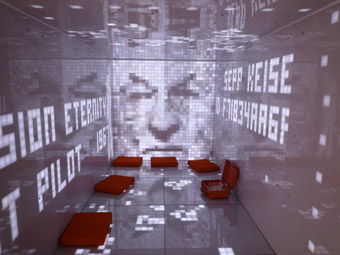
M∞ Sarcophagus, etoy.CORPORATION
photo Alexandra Crosby
M∞ Sarcophagus, etoy.CORPORATION
This year is the first time that the newly built Ars Electronica Centre has hosted the festival, and the four storey permanent exhibition takes a whole day to get through. Most impressive here is a temporary installation, unfortunately up some stairs and rather off the beaten track, of etoy’s fabulous M∞ Sarcophagus, part of the ongoing project, Mission Eternity. The ambitious aim of this work is to create a cult that can explore life after death in the digital age and “forever after.” The etoy.CORPORATION, most famous for their victory in the ‘toywar’ in the late 90s, defines the work as “a metaphysical adventure: an arcane network of computers, mortal remains, emotions, cargo containers, scientists, artists and hackers.” To view the process, we enter an immaculately designed shipping container. Inside are the digital and physical remains of pioneers of the information age who fit the criteria to be test pilots. So far there are two pilots: LSD guru and cyber writer Timothy Leary and Sepp Keiser, who broke new ground in microfilm and photocopying technologies in Switzerland. Keiser, in fact, is not yet deceased, but his contract with etoy ensures that when the time comes, his ashes will be cemented into the container’s pixel display. His digital portrait will be perpetually created, as fragments of safeguarded data are transmitted by thousands of ‘angels’ around the world.
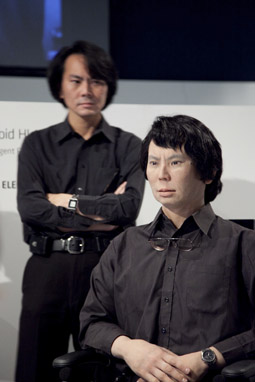
Geminoid Hl-1, Hiroshi Ishiguro
photo Alex Davies
Geminoid Hl-1, Hiroshi Ishiguro
More than 300 events were packed into this year’s Ars Electronica. One of the stars of the week was Hiroshi Ishiguro’s clone of himself, Geminoid Hl-1, which can be operated remotely using complex network and sensor technology. Perhaps with my own Geminoid, I could have made it to all the performances, forums, and symposia during the festival, but without robotic assistance, I had to contend with the limits of human nature.
Ars Electronica 2009, Festival for Art, Technology and Society; Linz, Austria, Sept 3-8
For more images and information on Lawrence Malstaf’s Shrink see www.360cities.net/image/shrink-performance-ars-electronica-linz;
www.fortlaan17.com/artists/lawrence-malstaf
RealTime issue #93 Oct-Nov 2009 pg. 30
© Alexandra Crosby; for permission to reproduce apply to realtime@realtimearts.net
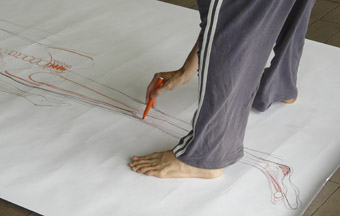
Thinking Through The Body, workshop, Bundanon Trust
photo Catherine Truman
Thinking Through The Body, workshop, Bundanon Trust
THE BODY OBSERVED IS A KEY TO OUR CULTURE. THE BODY AS TEMPLE PERMEATES PARTS OF THAT CULTURE IN WAYS THAT ARE REGARDED WITH CURIOSITY. THE TEMPLE OF KNOWLEDGE IS ANOTHER APPROACH TO THE BODY, UNDERSTANDING OUR EXPERIENCE OF THE WORLD THROUGH REFLECTIVE PRACTICE AND EXPERIMENTATION WITH TOUCH, MOVEMENT AND THE SENSE OF ONE’S POSITION AND VOLUME IN SPACE—PROPRIOCEPTION. THINKING THROUGH THE BODY (TTTB) IS A NSW-BASED INTERDISCIPLINARY RESEARCH PROJECT EXPLORING THE USE AND POTENTIAL OF THE BODY IN INTERACTIVE ART PRACTICES.
While for the past five decades research around the potential of the body in contemporary culture has developed exponentially, from philosophy and sociology, to contemporary arts, healthcare and human-computer interaction design, including haptic displays, bio-metrics, robotics etc, the lived experience of the body-as-subject has remained largely unexamined.
The project began over two years ago in response to the Australia Council for the Arts Inter-Arts Office ArtLab 2008 initiative, that set out to fund up to $75,000 development projects “with an artistic process that demands a very high degree of risk-taking from all involved.” Artists would be expected to experiment with “radical creative processes and be flexible to outcomes that cannot be predicted in advance.” The industry partners with TTTB in this process included Campbelltown Arts Centre, Bundanon Trust and Performance Space, who provided quite different spaces in which the work could proceed.
Without a doubt all the parties involved took risks, launching into unknown territories both as individuals, groups and organisations; no neat outcome could be assuredly predicted. TTTB demonstrated the need for focused research applied to interdisciplinary practice—many of us often seek material contexts for achieving this—but how are we now situated using the knowledge gained through the series of events pursued by this group of collaborators?
One of the project’s initiators, Lizzie Muller, framed some initial conclusions about what has happened as “an experiment in exchanging knowledge and also an experiment in making.” As a curator and recent researcher in the area of interactive media arts, she had previously worked with George Khut on the Cardiomorphologies project through the Creativity & Cognition Studios at UTS and Beta_space at the Powerhouse Museum (RT72, p10). Carefully developed approaches to observing and understanding audience experience of the bio-feedback gained through interaction with the Cardiomorphologies installation led Khut towards recognising the need “to spend some time thinking about connections that I was very interested in between interactive art and somatic bodywork practice. The practice is essentially about a way of re-experiencing the organisation of yourself—of your muscles and skeleton and the movement patterns that you’ve learnt through your life from infancy…Comparable forms of somatic bodywork might be the Feldenkrais Method, the Alexander Technique, things like Body-Mind Centering from Bonnie Bainbridge Cohen…”
The eight TTTB collaborators included Catherine Truman, an artist and certified Feldenkrais practitioner and another Adelaide-based trainer in the discipline, Maggie Slattery; Jonathan Duckworth, artist and interaction designer from Melbourne; Garth Paine artist and academic researcher at the University of Western Sydney’s VIPRe Studios; Lian Loke, artist and Interaction researcher at UTS Human Centred Technology Design group; and media artist and writer Somaya Langley.
Initially, when the group assembled at Campbelltown for the first residency in mid-2008, the differences for Slattery were palpable: “I’ll never forget the first time we had a meeting and everybody but me sat with a laptop on their lap; and I felt naked because I didn’t have a belly that was a screen where I could play my work…The emergence of interactive art began to make sense to me, as somebody outside of a generation who has grown up with technology. One of the things I picked up on was where the word interface is about a relational point between technology and self”, a difference amplified later by Langley: “most of the work that I do is in front of a laptop, so my brain’s out there, the laptop’s my entire interface to what I’m doing.”
Reflections about the initial shared space continued on the TTTB website leading on to the residency six months later at the Bundanon Trust on the Shoalhaven River in rural NSW. Muller observes that, “we were all abducted by aliens, which sounds extreme, but as a metaphor for what an intense experience we’d had it conveys a sense of it to other people.” The Feldenkrais practitioners took a lead, with Truman working through a series of awareness-through-movement lessons interspersed with workshops based on drawing the body; then moulding the body from clay, repeated both sighted and unsighted. “I’m finding each person in this workshop through my philosophy, I guess, and I’m trying to say, what is it you’re asking in your work? Or what is it that interests you? I think it’s really that simple. Rather than what’s out here, what does this technology do, I’m just trying to get people to—and it’s a question I ask myself, it’s my learning, my questions, things I need to know—why is it so important that I need to ask this of somebody else?”
For Khut the outcomes from Bundanon were about establishing a shared language and working through questions as they arose. “So we’re not making art from Feldenkrais or making Feldenkrais from art, it was something else, an understanding. It was about trying to identify these shared approaches and shared sets of questions that these two areas had and how they could enrich each other…[W]e had a session where we brought in some different interactive systems that made sounds from movement or light, or you would hear things in relation to a landscape and we were able to reflect on that in combination with the two workshops that Catherine [Truman] did; and then the workshop that Jonathan [Duckworth] did, which was about being in the landscape and how that connects to an experience of embodiment.“
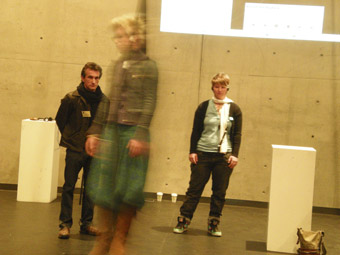
participant in pendulum piece, Jonathan Duckworth, Sensorium Gymnasium, Performance Space
photo Alejandra Mery Keitel
participant in pendulum piece, Jonathan Duckworth, Sensorium Gymnasium, Performance Space
Duckworth works professionally with patients who have suffered traumatic brain injury and as a result their body self-image is fragmented, resulting in difficulty moving and coordinating a number of motor functions. “So this workshop has helped me realise that the sensing required to become aware of your own body was in much finer detail than the way that I’d been exploring previously.”
At Sensorium Gymnasium, a day-long opportunity for visitors to engage with TTTB’s experiments, Garth Paine’s installation was constructed to demonstrate some provisional conclusions: “I’ve been recording motion capture data [gathered from] subtle Feldenkrais manipulation and it does have incredibly fine nuance which is something I can take away and continue to work with and share…I’m sonifying data at the moment and might also generate some visualisations. So there could be an experiential space that becomes a real-time sonification and visualisation of motion capture data in the space.”
Lian Loke’s understanding of the body comes from dance. The design approach to working with motion-sensing technologies has encouraged her to map relationships between the languages and vocabularies of other disciplines for her use as a designer, to negotiate the different perspectives afforded. The experience has been “about skilling up in that way so I can actually come from a more established foundation myself when designing things.”
Lizzie Muller in describing the “profound gift” of the experience concludes that, “Working in this way with these people has helped me to understand what it is that draws me to art. It is to do with the way it transforms our ability to understand the world.” George Khut has concluded “what motivates me is a desire to create systems and situations that support us to become more alive to the worlds around us and within us; and to be able to experience and engage with this aliveness with a sense of grace, delight and care.”
Thinking Through The Body: Campbelltown Arts Centre, Bundanon Trust, Performance Space, http://thinkingthroughthebody.net/; Sensorium Gymnasium, Performance Space, CarriageWorks, Sydney, Aug 3
RealTime issue #93 Oct-Nov 2009 pg. 31
© Mike Leggett; for permission to reproduce apply to realtime@realtimearts.net
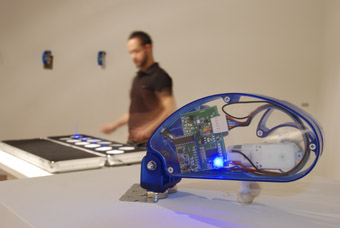
Eugene Ughetti and Radiobot
photo Matthew Gardiner
Eugene Ughetti and Radiobot
“WAS THAT THING FROM PREDATOR?” TWO SHEPPARTON TEENAGERS AMBLING AWAY FROM MATTHEW GARDINER’S NEW SHOW RADIOBOTS WOULD MISTAKE THE WORK’S CENTRAL INTERACTIVE CONSOLE, WITH A SERIES OF SEQUENTIAL INSIGNIAS, AS BASED ON THE EXPLOSIVE DEVICE ON THE ARM OF THE 1980S ACTION FILM’S ALIEN. OF THE WEIRD CONNECTIONS ONE CAN MAKE WHILE OPERATING RADIOBOTS, IT MAY NOT BE SO INCONGRUOUS TO ASSUME OF THEM AN OTHERWORLDLY ORIGIN.
The work is presented as a contraption in the truest sense; a short slideshow loop plays on a screen across the gallery, detailing the design and construction process. The Rabiobots themselves are meticulously constructed objects, looking somewhat like products of a marriage between a stapler and a cockroach. Inside their blue carapace, radio receivers are connected to a simple mechanism that makes them loudly tap a sinister pair of proboscises against the surface to which they are attached. Inside the front rooms of the Shepparton Art Gallery, they are affixed to plinths of various heights, to walls, to ceilings. One, most satisfyingly, is on a strip of metal, looking all the world like a caterpillar with a leaf to itself. To signal each of them to act, visitors approach the console and tap on hexagonal plastic drum pads.
While surly teenagers and roaring children are happy to experiment with hardcore death metal speed-drumming and group concertos, the noise that the contraption produces with a single tap is just as vital. Percussive art practices have often found silence as pliant and malleable as clay. Yet the quietude of the Shepparton Art Gallery, apart from anything else, is manifestly different, not the least reason being the phantasmagorical surprise of the Radiobots’ clack-clack when you are elsewhere in the gallery. The sonic force reverberates around the rooms and halls to symbiotic effect—what seems like an infestation of the alien quickly becomes a polyvocal chorus of the environment. The gallery grows itself a tongue with which to clack.
Gardiner recapitulated this impulse by performing a series of Radiobots workshops and performances with collaborators, percussionist Eugene Ughetti and Aphids’ director David Young. With a residency with Ars Electronica in Austria, Gardiner has positioned this generation of Radiobots as a nursery for future percussive installations internationally while attenuating the exhibit to the local environment. His work has concentrated on hybrid practices for many years; the Oribotics sequence from 2004-2008 also invoked a range of concerns to do with local environments and the swarming memories of people interfacing with his artworks. Shepparton, then, demands that it uses the gallery’s tongue as well. 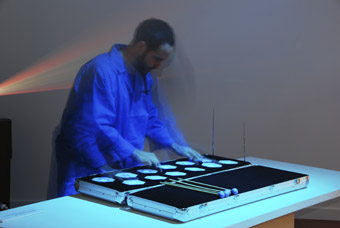
Eugene Ughetti, Radiobots
photo Matthew Gardiner
Eugene Ughetti, Radiobots
With a diverse range of gallery programs growing and changing in the vast Australia outside the capital cities, it becomes harder to dismiss regional galleries as provincial. Shepparton’s upstairs pottery collection, was one of the best places to experience Gardiner’s installation. Through the peculiarities of sonic accrual, it was possible to sense the Radiobots sending a disturbance in the air, and in the vibrations coming up through the ground, it was like listening to sealife converse underneath a sheet of ice. There, generations of handicrafts posed for ornament and historicity emanated slight hollow echoes each time a pad downstairs was pushed. Just a few feet away, Rita Lazauskas’s melancholic daily sketches and drawings were similarly altered, as the distinction between the heaviness of her images from home and the lightness of those made during travel were punctuated and made more pronounced by the aural hammering.
A quick visitor to the gallery, however, might see a more inchoate and disconnected form of life, perhaps parasitic in the best tradition rather than romantically symbiotic or expressive. The work is, despite the cool and clinical construction, also an agent of purest bedlam. The percussive effects swarm around the rooms as the pads are struck in sequence, while the work is arranged in such a way that they likewise fold behind the front desk and its staff, who also become agents in this unusual biosphere.
All sound art is also about the spaces and volumes in which the sound lives. In a sense, the teenagers were right, the Radiobots are predatory after all. If you do not stay to inhabit the space yourself, the work dominates. The future installations and generations of Radiobots promise Ars Electronica in Linz as a site of infestation, alongside bridges and public objects—more localities in which to grow tongues, and new audiences to speak in them.
Radiobots, artist Matthew Gardiner, ?technical designer Ray Gardiner?, composer David Young, ?percussionist Eugene Ughetti?, producer Aphids in association with Shepparton Art Gallery and Riverlink, Shepparton Art Gallery, Victoria, Sept 1-20
RealTime issue #93 Oct-Nov 2009 pg. 32
© Christian McCrae; for permission to reproduce apply to realtime@realtimearts.net
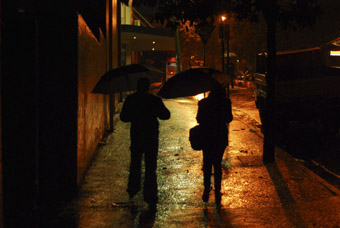
Razorhurst participants
photo courtesy d/Lux/MediaArts
Razorhurst participants
IN BARCELONA, A SMALL PLAZA IN THE MOSTLY GENTRIFIED BARRIO GOTHICA HAS BEEN LEFT PURPOSELY UNRENOVATED. THE STONE WALLS ARE HEAVILY POCKMARKED BY GUNSHOTS FROM A FAMOUS BATTLE BETWEEN LOYALISTS AND REPUBLICANS. VISITORS RUN THEIR HANDS OVER THIS EERIE AND VISCERAL REMINDER OF ALL THAT CITIES WITNESS AND ABSORB. YET THE BARRIO GOTHICA HAS ARGUABLY BEEN SAVED BY THE GENTRIFICATION OF ITS LABYRINTHINE ALLEYS. IF THEMED HISTORY PROTECTS AN ENCLAVE, CAN IT BE ALL BAD?
I entertain myself with these thoughts while I wait to play the GPS game Razorhurst in Sydney’s East Village pub. I start writing on the branded beer coaster (nice touch). This once notorious hotel—in my youth The Tradesman’s Arms and a well-known hangout for ‘fences’—is friendly on a Friday night yet retains its patina of criminal mystique. A group of suits discuss tax minimisation, three old blokes with beers are on first-name terms with the barmaid, a tranny and her sidekick cruise by, a paint spattered renovator realising his rendezvous hasn’t materialised reaches for his phone. The original pressed tin ceiling bears witness: if, as JG Ballard imagined, it has absorbed all the sounds that were emitted under its canopy, what stories would it know? What would the original art noveau wall tiles reveal under forensic analysis? I’m clearly ripe for transportation to Depression era Darlinghurst.
Considering the links between the visceral and memory, what role do digital media have in enhancing the powers of historical imagination and in reinvigorating lost histories and spaces? With Razorhurst, presenters dLux/Mobile and creative developer Richard Fox combine urban history with game elements in a GPS-based locative experience. Inducted at the pub, players proceed with GPS enabled handsets and headphones to explore the surrounding streets, collect ‘sly grog’ and fight or join roving groups of razor-wielding gangsters. The content of the game comprises some excellent graphics, stills, movies and audio, both original and archival (sourced from the City of Sydney archives, the Historic Houses Trust NSW and ABC radio drama). The original sound, movies (shot by Mattias Morelos) and graphics have been designed and produced by Fox, and his background as a professional art director hold him in good stead—the overall look and feel are great, from the aforementioned beer coasters to postcards, posters and screen graphics. I liked his voice on the audio, too—a good thing as the experience is heavily audio-based.
The main interface is a GPS-enabled street map, and while this worked well technically, on the night I played I felt that a less heavy reliance on GPS would have benefited the game’s experience design. Using analogue wayfinding and self positioning (eg asking players to orientate to buildings or topography) would lessen the dependence on map reading and allow them to look up at the district. Reliance on location to trigger content, when GPS is quite a coarse grained technology, is also problematic, and possibly a combination of temporally and spatially triggered content would prove more flexible. I would have been happy to have more developed character through-lines and these may be a better direction to pursue than the incorporation of game elements (collecting bottles, losing health to gangsters). The experience straddles themed historical walking tours and games, and as such it must achieve a textured pace. While it succeeds at times (I do literally run from the gangsters), at others I would have preferred dwell-time to stand and hear the narrative more developed.
Overall I found the experience affective. Ever ready to be engaged, I felt that the close-miked audio (perhaps enhanced by unintended looping), the rainy streets and the fast walk around the district darkly familiar to my youth did work to evoke and titillate. I was back in a time when Darlinghurst was not populated by four wheel drives and filled to capacity with so cool-as-to-chill Italian design emporia. I scurry through St Peter’s Lane, run up a back alley to avoid the gangsters racketing in my head, and out of the corner of my eye see layabouts camped on the narrow terrace porches. The brightly lit City Gym reminds me that in the Depression only the fittest survived and muscles were developed hauling fruit boxes down at Paddy’s Markets or wringing wet sheets by hand in some dismal backyard.
Vodka is the new gin and I opt for it over a complimentary gin as my post-game reward. I’m ready to get home and away from thoughts of the many tear-soaked pink gins to which this hotel undoubtedly bore witness.
Razorhurst, designed & developed by Richard Fox, presented by d/Lux/MediaArts, East Village Hotel, Sydney, July 5-31; for full credits see www.razorhurst.com.au
RealTime issue #93 Oct-Nov 2009 pg. 33
© Kate Richards; for permission to reproduce apply to realtime@realtimearts.net
REVOLUTIONS HAPPENED IN 1968, STUDENTS IN PARIS AND ELSEWHERE AND IN COMPUTING EVERYWHERE. BUT THE COMPUTING REVOLUTION WAS BOTH PRO AND ANTI. FOR MANY IT MEANT AUTOMATION AND THE LOSS OF EMPLOYMENT, FOR SOME PROFESSIONALS IT CREATED NEW WAYS OF WORKING AND FOR ARTISTS IT INTRODUCED A FORM THAT HAD NO KNOWN ANTECEDENTS, “EXPAND[ING] OUR SENSE OF WHAT WE MIGHT BE ABLE TO DO WITH SUCH TECHNOLOGIES”, WRITES CHARLIE GERE IN WHITE HEAT COLD LOGIC, BRITISH COMPUTER ART 1960-1980.
Of course now computers have become ubiquitous to the point of invisibility but they began in an age when electronics were big and took up whole rooms—requiring their own air-conditioning and acolytes to see to their every need. Between 1960 and 1968 they began to be more compact and by 1968 the desk-sized (not yet desk-top) computer was available. For some this meant that computers became available and for a very adventurous few they appeared in several British art schools.
Although the artworld didn’t really notice, it was leapfrogged by the digital world late in ‘68. Two things happened. One was a conference at which computer graphics packages were proposed and a society was formed. The other was the single most important exhibition in the field of computers and the arts. The society was the Computer Arts Society and the exhibition was Cybernetic Serendipity at the ICA in London, both of which were of extraordinary importance and continue to be relevant throughout the period and the book.
With the evolution of kinetic art into interactivity and conceptualism computers became accessible at the right moment. This book covers many aspects of that story, bringing us accounts from the pioneers of computer art in Britain of their personal encounters with computers through happenstance or in the process of work or study, and sometimes of art.
The chapters in White Heat Cold Logic, although they show a wide range of detail, introduce the developments of individual artists, the role of cybernetic notions and interactivity in computing, Jasia Reichardt’s especially significant exhibition Cybernetic Serendipity and the importance of the computer arts society.
British artists’ engagement with the computer was tightly linked to the development of cybernetics in Britain, after its initialisation in the US by Norbert Wiener in 1948, with Ross Ashby, Stafford Beer and Gordon Pask being the leading figures. Of these Pask was the one who made the main representation of notions of cybernetics in artistic forms. Several chapters discuss aspects of his work as it impacted on the work of visual artists, architects and teachers.
After a cursory introduction the real story begins with the artist and teacher Roy Ascott, who realised that as a system of relationships between an artist, an artwork and the audience, the work of art could develop to the point where it might actively engage members of the viewing public, thus introducing the notions of an art that behaves (ie interactive art). Pask had helped Ascott navigate the biological and mathematical literature of cybernetics, revealing its simplicity. Ascott then introduced these notions in understanding the experience of art and in its teaching and later, using telecommunications networks, extended them to the telematic or art that is an active partner in communications.
Pask’s work in art is detailed by Maria Fernandez in her chapter, in which she considers his “understanding of the work of art as a system that evolved independently or in interaction with a participant.” This appears particularly in his The Colloquy of Mobiles installation that featured in Cybernetic Serendipity, and the realisation that the self-organisation of the artwork required the audience to be able “to make sense of it.”
Pask also influenced Stephen Willats, another cybernetic artist working with feedback systems, who was also a colleague of Ascott’s in the mid-1960s. He began by studying the changing relationships the audience had with artworks when they moved around them while he was working in several London art galleries. From his observations he constructed a series of artworks that the audience could manipulate. Other early chapters introduce Cedric Price’s proposals—again guided by Pask’s ideas—for an interactive architecture “driven by social idealism” in which buildings would organise themselves around the needs and behaviours of their inhabitants.
Cybernetic Serendipity is discussed by several authors, including its original curator Jasia Reichardt, and Brent MacGregor’s later revisiting of the exhibition through the archives. Reichardt covers the experimental foundations of what led to this seminal computer art exhibition and she also introduces some useful pointers to ways in which one might make aesthetic judgements about computer art. Cybernetic Serendipity included computer graphics, music and poetry, cybernetic devices and installations such as Pask’s Colloquy and robots like Paik’s K456. It also included a history of cybernetics and provided opportunities to experience the uses of the computer.
Of the historical surveys Richard Wright’s chapter provides an important reminder of the role of the Constructivists and the British Systems Group as precursors. Two other important occurrences also receive mention. One is the establishment and growth of the Computer Arts Society, ably supported by Gustav Metzger, Alan Sutcliffe and the late John Lansdown. The CAS became a meeting place, exhibition organiser, a lobby group and the publishing arm for computer artists from 1968. The other is Edward Ihnatowicz’s two interactive sculptures. His first was SAM (Sound Activated Module) shown at Cybernetic Serendipity, which listened to and appeared to attend to the source of any sounds in its locale. The other was the truly significant demonstration of the principles of artificial intelligence he incorporated into the Senster. This very large robotic system was built for the Philips Industries Evoluon in Eindhoven, Holland, where it entertained audiences for several years. Both SAM and the Senster are discussed in Aleksander Zivanovic’s chapter and Richard Ihnatowicz’s memoir of his father.
Essays and memoirs by many other computer artists are included, among them Alan Sutcliffe, Harold Cohen, George Mallen, Stephen Willats and Ernest Edmonds, all of whom held a variety of roles including programming, engineering, teaching and all important—creating the extraordinary range of artworks that might be assembled under the rubric of computer art.
The role of institutions is covered through essays such as Doron Swade’s chapter on computer art in the science museum and Catherine Mason’s chapter on the role of academic institutions in providing access to and teaching of computing to students in the fine arts as well as engineering. More detailed discussions of some of the art schools are included in Stephen Bury’s memoir of his time at the Chelsea School of Art, Paul Brown’s discussion of generative art at the Slade School and John Vince’s chapter on the development of PICASO, one of the most successful early British computer graphic and animation applications, at Middlesex Polytechnic.
This is a generally interesting and well-written though lightly edited book that provides a valuable look at a sadly neglected but very important aspect of art history. The main problem with a book of this kind, made up of essays by a large number of people, is that the construction of an overview is difficult. Each time an event is mentioned one can hopefully remember that so-and-so and she and he all made contributions to this event. But there is very little that actually points out the relations that operated between many of the artists unless a particular author discusses the collaborations they had or members of the class they attended, even if only through a coincidental presence at an exhibition or an art school. There is an extensive index but the absence of a comprehensive bibliography is unfortunate, though this can be redressed by a trawl through the endnotes for each chapter.
While the book introduces us to many of the individuals, artists and computer scientists who made a contribution to digital art in the UK from 1960 to 1980, it does not do the complementary task which is to introduce us to the systems and machines on which that art was made, to the displays and plotters, to why computer art is so dependent on its hardware, to what was possible, to computer music making and especially to the technical people who helped make the systems. One of the editors and contributors Catherine Mason has her own book, A Computer in the Art Room: The Origins of British Computer Arts 1950-80, which I rather hope does some of that, but I have yet to see it.
White Heat Cold Logic, British Computer Art 1960-1980, edited by Paul Brown, Charlie Gere, Nicholas Lambert and Catherine Mason. Cambridge, Massachusetts, MIT Press, Leonardo imprint, 2009
RealTime issue #93 Oct-Nov 2009 pg. 34
© Stephen Jones; for permission to reproduce apply to realtime@realtimearts.net
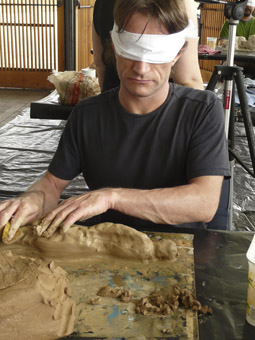
Jonathan Duckworth, from Thinking Through the Body, Bundanon Trust, Bundanon
photo Catherine Truman
Jonathan Duckworth, from Thinking Through the Body, Bundanon Trust, Bundanon
Every now and then an image, a theme or an issue materialises as an edition of RealTime takes shape, spookily permeating its pages. Everywhere in RealTime 93 it’s the body: shrinkwrapped (Shrink, cover), mimicking (Chuncheon International Mime Festival), apocalyptic (Black Marrow), ecstatic (Miracle), regional (On Edge), indigenous/cosmopolitan (Burning Daylight), reversing (Hye Yeon Nam), participatory (Tank Man Tango), punk (We’re Living on Dog Food), doubled (Geminoid Hl-1), superhuman, and as performance engine (Run), music (Soundstream) and land (Garma). Neither fetishistic nor narcissistic, these explorations (Thinking Through the Body) and performative states of being are indicators of art as lived in the body, locally, globally and interculturally.
RealTime issue #93 Oct-Nov 2009 pg. 1
© RealTime ; for permission to reproduce apply to realtime@realtimearts.net

 Germ Studies is a double CD produced by the duo of Clare Cooper of NOWnow Festival fame and Chris Abrahams of The Necks, and the two have been collaborating on it since 2003. Each CD comprises no less than 99 tracks, 198 in all. That is a lot of material and it represents an extensive investigation into the endless range of sounds that can be created by combining the venerable DX7 synthesiser and the even more venerable Chinese zither, the guzheng. It is also a deep exploration of musical language. Rather than producing longer, more self-contained compositions, Cooper (guzheng) and Abrahams (DX7) have created a series of sonic moments that flit through conscious awareness, sharply distinguished from each other by the nature of the sound, the sum of which creates a substantial and engrossing oeuvre. Many of these exquisite tracks are less than a minute in length, some just a few seconds. A few are longer, at 2 or 3 minutes, and, perhaps ironically, the track entitled Neutrino (referring to the almost weightless sub-atomic particle) is an epic at 8 minutes.
Germ Studies is a double CD produced by the duo of Clare Cooper of NOWnow Festival fame and Chris Abrahams of The Necks, and the two have been collaborating on it since 2003. Each CD comprises no less than 99 tracks, 198 in all. That is a lot of material and it represents an extensive investigation into the endless range of sounds that can be created by combining the venerable DX7 synthesiser and the even more venerable Chinese zither, the guzheng. It is also a deep exploration of musical language. Rather than producing longer, more self-contained compositions, Cooper (guzheng) and Abrahams (DX7) have created a series of sonic moments that flit through conscious awareness, sharply distinguished from each other by the nature of the sound, the sum of which creates a substantial and engrossing oeuvre. Many of these exquisite tracks are less than a minute in length, some just a few seconds. A few are longer, at 2 or 3 minutes, and, perhaps ironically, the track entitled Neutrino (referring to the almost weightless sub-atomic particle) is an epic at 8 minutes. 































 A NEW BOOK, EXPERIMENTAL MUSIC: AUDIO EXPLORATIONS IN AUSTRALIA, FROM UNSW PRESS, OPENS ‘SCENIC’ WINDOWS ONTO HIDDEN WORLDS OF AUDIO CULTURE AND CONTEMPORARY MUSIC-MAKING FOR THOSE WHO MAY HAVE BEEN CAUGHT IN ITS SPELL AND WONDERED WHERE IT ALL CAME FROM.
A NEW BOOK, EXPERIMENTAL MUSIC: AUDIO EXPLORATIONS IN AUSTRALIA, FROM UNSW PRESS, OPENS ‘SCENIC’ WINDOWS ONTO HIDDEN WORLDS OF AUDIO CULTURE AND CONTEMPORARY MUSIC-MAKING FOR THOSE WHO MAY HAVE BEEN CAUGHT IN ITS SPELL AND WONDERED WHERE IT ALL CAME FROM. 










































![Bios [Bible], robotlab](https://www.realtime.org.au/wp-content/uploads/art/29/2960_crosby_ars_bible.jpg)









